Notícias do Mercado
-
23:54
GBP/USD aims to regain 1.2200 on softer US Dollar ahead of US CB Consumer Confidence
- GBP/USD picks up bids to extend the previous day’s rebound from three-week low.
- US Treasury bond yields allow USD to regain upside momentum.
- Pessimism surrounding the UK workers’ strike, cautious mood ahead of the key US data probes Cable buyers.
GBP/USD extends the previous day’s rebound from a three-week low, up 0.11% intraday near 1.2190 during the mid-Asian session on Wednesday. In doing so, the Cable pair cheers the broad-based US Dollar weakness, due to the receding fears of the recession. However, the cautious mood ahead of the key US data and challenges to the UK’s health sector seems to probe the pair buyers of late.
“Around 100,000 nurses went on strike on Tuesday for the second time in a week as their union issued an ultimatum to the government to respond to pay demands within 48 hours or face another round of industrial action in January,” said Reuters.
Elsewhere, the US Dollar Index (DXY) dropped the most in a week the previous day, down 0.67% intraday to 103.95, as the greenback traders feared less Japanese bond-buying from the US due to the BOJ action. It’s worth noting that Japan is the biggest holder of the US Treasury bonds and the latest move allows Tokyo to put more funds into the nation than letting it flow outside. That said, the 10-year counterpart rose more than the two-year ones and hence reduced the yield curve inversion that suggests the odds of the recession.
It should be noted that the downbeat US housing data also allowed the GBP/USD pair to remain firmer, before the latest softer run-up.
Talking about the data, US Housing Starts declined by 0.5% MoM in November following October's 2.1% contraction while Building Permits fell by 11.2% versus a 3.3% drop recorded in the previous month. Further, the German Producer Price Index (PPI) for November dropped to -3.9% YoY versus -2.6% market forecasts and -4.2% prior.
While portraying the mood, the US 10-year Treasury yields grind near a three-week high of 3.69% while the two-year bond coupons stay firmer around 4.26% by the press time. Further, Wall Street closed in green and allow stocks in the Asia-Pacific bloc to print mild gains of late.
Looking forward, the United States Conference Board (CB) Consumer Confidence figures for December, expected at 101.00 versus 100.00 prior, will join the political updates from the UK to direct short-term GBP/USD moves. Though, major attention will be given to Thursday’s UK Gross Domestic Product (GDP) figures and Friday’s US Core PCE Inflation data for clear directions.
Technical analysis
21-day EMA joins a one-month-old ascending support line to restrict short-term GBP/USD downside near 1.2160. However, bearish MACD signals and steady RSI challenges the pair buyers.
-
23:37
Gold Price Forecast: XAU/USD grinds higher, United States Consumer Confidence, Treasury bond yields eyed
- Gold price seesaws around weekly top after rising the most in three weeks.
- United States Treasury bond yields underpinned US Dollar’s biggest daily fall in a week and propelled XAU/USD.
- Gold buyers also cheered receding fears of recession, hopes for more stimulus from China.
- US data, risk catalysts will be crucial as Gold traders approach the key resistance near $1,820.
Gold price (XAU/USD) remains sidelined around $1,820 as the metal buyers take a breather during early Wednesday, following the biggest daily jump in three weeks. That said, the US Dollar’s weakness and receding fears of the economic slowdown, as per the Treasury bond yields curve inversion, seemed to have favored the XAU/USD bulls previously. However, the cautious mood ahead of the key United States data and technical analysis challenges the bullion buyers of late.
Gold buyers cheer softer US Dollar
Gold price rallied heavily the previous day as the US Dollar Index (DXY), a gauge of the US Dollar’s move versus the major six currencies, dropped the most in a week, down 0.67% intraday to 103.95 while marking a two-day downtrend. In doing so, the DXY traders feared less Japanese bond-buying from the United States due to the latest Bank of Japan (BOJ) action. It’s worth noting that Japan is the biggest holder of the US Treasury bonds and the latest move allows Tokyo to put more funds into the nation than letting them flow outside.
Bank of Japan (BOJ) rocked markets the previous day and fuelled the Gold price with a surprise move that suggests lesser funds flowing outside Japanese bond markets due to a policy tweak. The Japanese central bank kept the monetary policy unchanged but widened the band of Yield Curve Control (YCC) to -/+ 0.5% from -/+0.25% prior.
United States Treasury bond yields favored XAU/USD bulls, via recession signals
It’s worth noting that the Bank of Japan’s moves triggered the United States bond market signals that suggested receding bets on the economic slowdown, which in turn allowed the Gold buyers to keep the reins. That said, the 10-year counterpart rose more than the two-year ones and hence reduced the yield curve inversion that suggests the market’s fears of recession. It should be noted that the US 10-year Treasury yields grind near a three-week high of 3.69% while the two-year bond coupons stay firmer around 4.26% by the press time.
China-linked headlines also welcome Gold buyers
Being one of the largest customers of Gold, headlines suggesting more stimulus from China, mainly due to the downbeat economic forecasts from the World Bank and policymakers’ readiness to defend the economy, propelled XAU/USD prices the previous day. It’s worth noting, however, that recently softer China economics and mixed concerns surrounding Covid challenge Gold buyers.
US data, yields in focus
Having witnessed a solid run-up, Gold buyers seem to take a breather after the United States Conference Board (CB) Consumer Confidence figures for December, expected 101.00 versus 100.00 prior. Also likely to have probed the XAU/USD bulls could be the latest inaction in the bond markets, after a volatile day, as well as technical space that probes the Gold’s further upside. Should the scheduled US data manage to print higher numbers, the US Dollar may witness a recovery and hence the Gold price could retreat.
Gold price technical analysis
With the heaviest daily rise since December’s start, Gold price approaches the upper line of a five-week-long rising wedge bearish chart pattern, around $1,823 by the press time.
It’s worth noting, however, that the Relative Strength Index (RSI), located at 14, suggests the commodity’s limited upside by being near the overbought region. On the same line, sluggish signals from the Moving Average Convergence and Divergence (MACD) indicator challenge Gold’s further advances.
Hence, the XAU/USD’s upside appears capped near $1,825, at least for now.
However, Gold’s clear break of the said resistance would defy the bearish chart pattern and can quickly propel the precious metal toward June’s high near $1,880.
On the contrary, a convergence of the 21-DMA and the stated wedge’s lower line offers a tough nut to crack for the Gold bears, around $1,780. That said, the $1,800 round figure could restrict the short-term downside of the Gold price.
Gold price: Daily chart
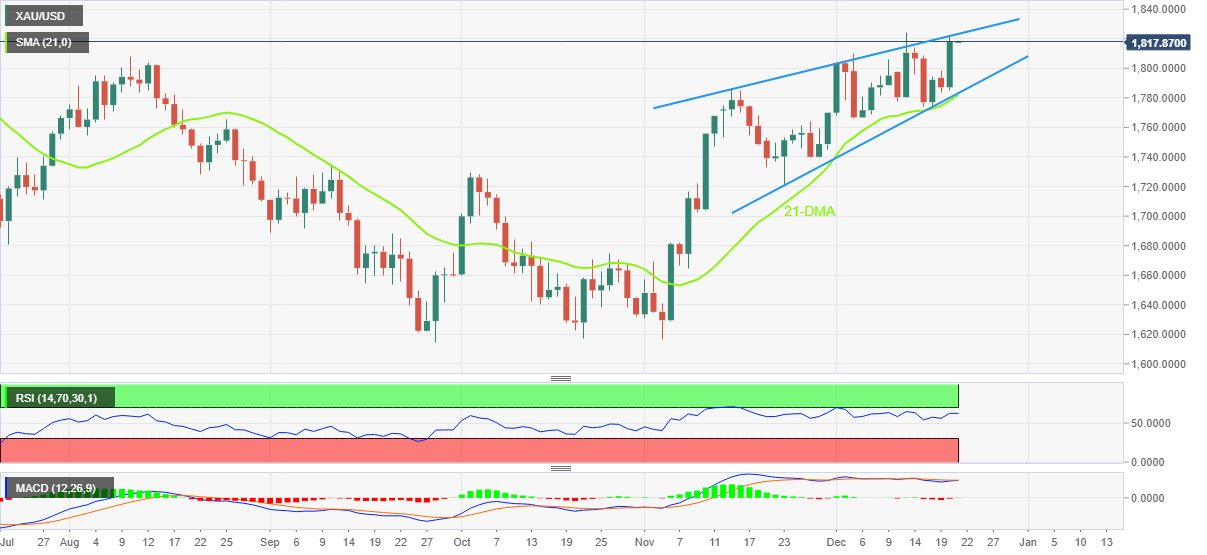
Trend: Limited upside expected
-
23:31
Australia Westpac Leading Index (MoM) dipped from previous -0.05% to -0.1% in November
-
22:59
USD/CAD Price Analysis: Retreats to 1.3600 inside rising wedge
- USD/CAD remains pressured towards 1.3520 support confluence inside six-week-old rising wedge.
- 50-day EMA joins wedge’s lower line to highlight 1.3520 support.
- Looming bear cross on MACD, bearish chart formation favor sellers.
USD/CAD holds lower ground near 1.3610 as it braces for the three-day downtrend during Wednesday’s Asian session. In doing so, the Loonie pair drops inside a 1.5-month-old rising wedge bearish chart pattern.
That said, the impending bear cross on the MACD adds strength to the downside bias, in addition to the rising wedge formation.
As a result, the quote’s downside break of the 1.3600 threshold appears imminent.
However, a convergence of the 50-day Exponential Moving Average (EMA) and the lower line of the stated wedge, highlights the 1.3520 as the key support.
In a case where the USD/CAD prices drop below 1.3520, the odds of witnessing gradual declines towards the 50% and 61.8% Fibonacci retracement of the pair’s August-October upside, 1.3350 and 1.3200 in that order, can’t be ruled out.
Should the quote remains bearish past 1.3200, the theoretical target of the rising wedge confirmation, around 1.3050, gains the major attention.
On the flip side, recovery moves remain elusive unless the USD/CAD pair crosses the 1.3700 round figure.
Even so, the upper line of the stated wedge, near 1.3775 by the press time, could challenge the pair buyers.
Following that, multiple resistances near 1.3810 and 1.3850 could test the USD/CAD bulls before directing them to the yearly high marked in October around 1.3980.
USD/CAD: Daily chart
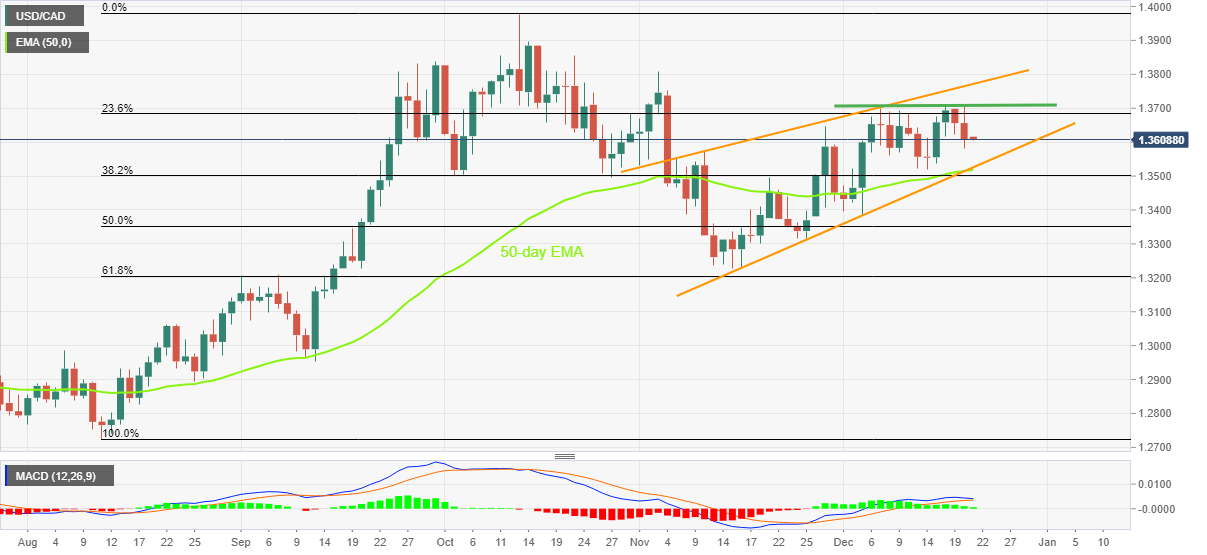
Trend: Further downside expected
-
22:48
New Zealand ANZ – Roy Morgan Consumer Confidence dipped from previous 80.7 to 73.8 in December
-
22:47
United States API Weekly Crude Oil Stock declined to -3.069M in December 16 from previous 7.819M
-
22:43
EUR/USD stays defensive above 1.0600 ahead of US CB Consumer Confidence
- EUR/USD remains sidelined after two-day uptrend, fades bullish bias of late.
- Narrowing of the yield curve inversion, softer US Dollar joined hawkish ECB talks to favor the bulls.
- Mixed sentiment surrounding the bloc, softer German PPI probed buyers.
- Risk catalysts will also be important for fresh impulse.
EUR/USD struggles to extend the previous two-day uptrend during the early hours of Wednesday’s Asian session as it makes rounds to 1.0620-30. In doing so, the major currency pair portrays the market’s indecision despite the latest fall in the US Dollar and receding fears of the recession, as portrayed by easing yield curve inversion.
Bank of Japan (BOJ) rocked markets in Asia and Europe before Wall Street managed to close in green. The reason could be linked to the surprise move by the Japanese central bank that suggests lesser funds flowing to the ex-Japan bond markets due to a policy tweak. The Japanese central bank kept the monetary policy unchanged but widened the band of Yield Curve Control (YCC) to -/+ 0.5% from -/+0.25% prior.
The resulting moves could be witnessed more in the US Dollar and Treasury yields as the US Dollar Index (DXY) dropped the most in a week the previous day, down 0.67% intraday to 103.95, as the greenback traders feared less Japanese bond-buying from the US due to the BOJ action. It’s worth noting that Japan is the biggest holder of the US Treasury bonds and the latest move allows Tokyo to put more funds into the nation than letting it flow outside.
That said, the 10-year counterpart rose more than the two-year ones and hence reduced the yield curve inversion that suggests the odds of the recession.
It’s worth noting that the hawkish comments from the European Central Bank (ECB) officials joined mixed EU data to restrict EUR/USD moves. That said, ECB Governing Council member and French central bank governor Francois Villeroy de Galhau said, “The European economy is likely to avoid a hard landing.” On the same line, ECB policymaker Peter Kazimir said on Tuesday that the “monetary policy should tighten at a stable pace.”
Elsewhere, US Housing Starts declined by 0.5% MoM in November following October's 2.1% contraction while Building Permits fell by 11.2% versus a 3.3% drop recorded in the previous month. Further, the German Producer Price Index (PPI) for November dropped to -3.9% YoY versus -2.6% market forecasts and -4.2% prior.
Moving on, US CB Consumer Confidence for December, expected 101.00 versus 100.00 prior, could entertain the EUR/USD pair traders. However, major attention will be given to the risk catalysts for fresh impulse.
Technical analysis
Despite bouncing off the 10-DMA, around 1.0600 at the latest, the EUR/USD bulls need validation from the 1.0660 hurdle to keep the reins.
-
22:19
NZD/USD seesaws near 0.6350 even as New Zealand trade deficit increases
- NZD/USD defends the bounce off three-week low, stays sidelined of late.
- New Zealand trade deficit increased in November, Exports and Imports also rose.
- Market sentiment dwindles after Bank of Japan-inspired moves, contracting yield curve inversion eases recession woes.
- Second-tier US data eyed for near-term directions as US Dollar stays depressed.
NZD/USD dropped to the lowest levels in three weeks before recently bouncing off 0.6300, making rounds to 0.6350 during early Wednesday. The Kiwi pair’s latest rebound could be linked to the downbeat US Dollar but pays little heed to New Zealand (NZ) trade numbers for November.
New Zealand Trade Balance for November dropped to $-14.63B YoY and $-1,863M MoM versus the expected prints of $12.71B and $-1,091M respective market forecasts. That said, the previous readings were revised down to $-13.86B and $-2,298M. Details suggest that the Imports rose to $8.54B from $8.26B whereas Exports also increase to 6.68B versus $5.96B prior.
Additionally important were the monthly figures of New Zealand’s ANZ-Roy Morgan Consumer Confidence Index that slumped to the lowest levels since 2004, to 73.8 for December versus 80.7 prior.
Previously, the Kiwi pair failed to cheer the broad US Dollar weakness as market sentiment worsened in the Asia-Pacific due to the Bank of Japan’s (BOJ) slight change in the monetary policy parameters. The Japanese central bank kept the monetary policy unchanged but widened the band of Yield Curve Control (YCC) to -/+ 0.5% from -/+0.25% prior.
That said, the US Dollar Index (DXY) dropped the most in a week the previous day, down 0.67% intraday to 103.95, as the greenback traders feared less Japanese bond-buying from the US due to the BOJ action. It’s worth noting that Japan is the biggest holder of the US Treasury bonds and the latest move allows Tokyo to put more funds into the nation than letting it flow outside.
Other than the BOJ-led moves, fears of China’s slower growth, backed by the World Bank’s downbeat economic forecasts, also weighed on the NZD/USD prices.
It’s worth noting that Wall Street closed on the positive side as the US Treasury bond yields rallied. Among them, the 10-year counterpart rose more than the two-year ones and hence reduced the yield curve inversion that suggests the odds of the recession.
Talking about the data, US Housing Starts declined by 0.5% MoM in November following October's 2.1% contraction while Building Permits fell by 11.2% versus a 3.3% drop recorded in the previous month.
Looking forward, US CB Consumer Confidence for December and Existing Home Sales for November will be important to watch. However, major attention will be given to the risk catalysts for fresh impulse.
Technical analysis
NZD/USD bounces off 21-DMA, around 0.6335 by the press time, to defend buyers. Even so, recovery remains elusive below the 0.6400 hurdle.
-
22:03
USD/JPY consolidates near 131.60 after huge move set-off by BoJ
- USD/JPY bears steamrolled their way in. bursting out of a coil and now eye further downside.
- Bank of Japan tweaks policy in a surprise move, sending the Yen on a tear.
USD/JPY is down some 3.8% ahead of the close and roll-over on Tuesday having dropped strongly due to the Bank of Japan's surprise policy tweak. The pair dropped from a high of 137.47 to a low of 130.56.
The Bank of Japan kept broad policy settings unchanged, pinning short-term JGB yields at -0.1% and the 10-year yield around zero. However, the volatility in the markets was set off when the BoJ announced it would let long-term yields move 50 basis points on either side of its 0% target, wider than the 25 basis point band previously. Consequently, the yen soared and broke out of a coil that was highlighted din the pre-BoJ analysis as illustrated in the following technical analysis.
USD/JPY technical analysis
As per the prior analysis, USD/JPY Price Analysis: Could be coiling ahead of a significant breakout, where it was stated that USD/JPY was in a state of consolidation, coiling below the breakout of the daily trendline support of the prior bullish cycle, the breakout occurred as follows:
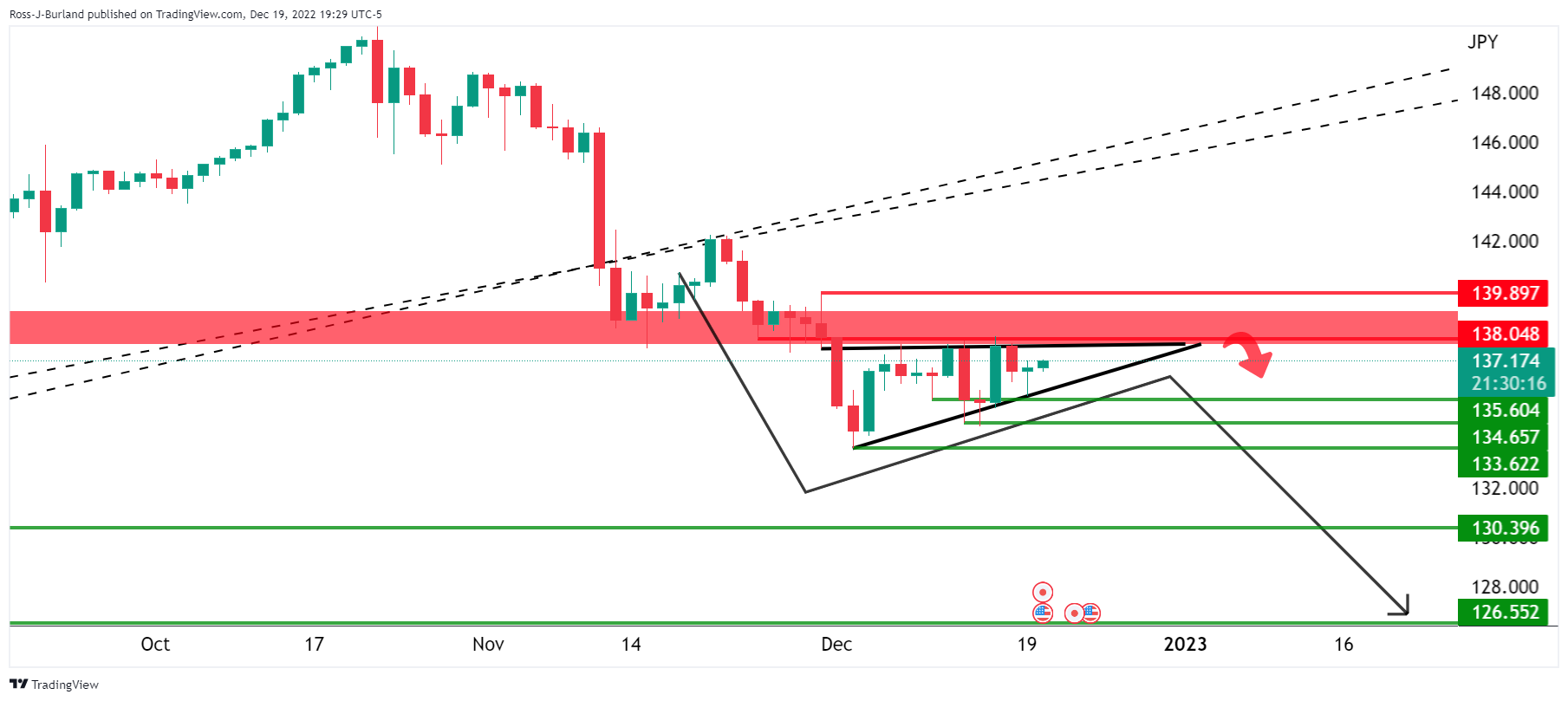
USD/JPY update
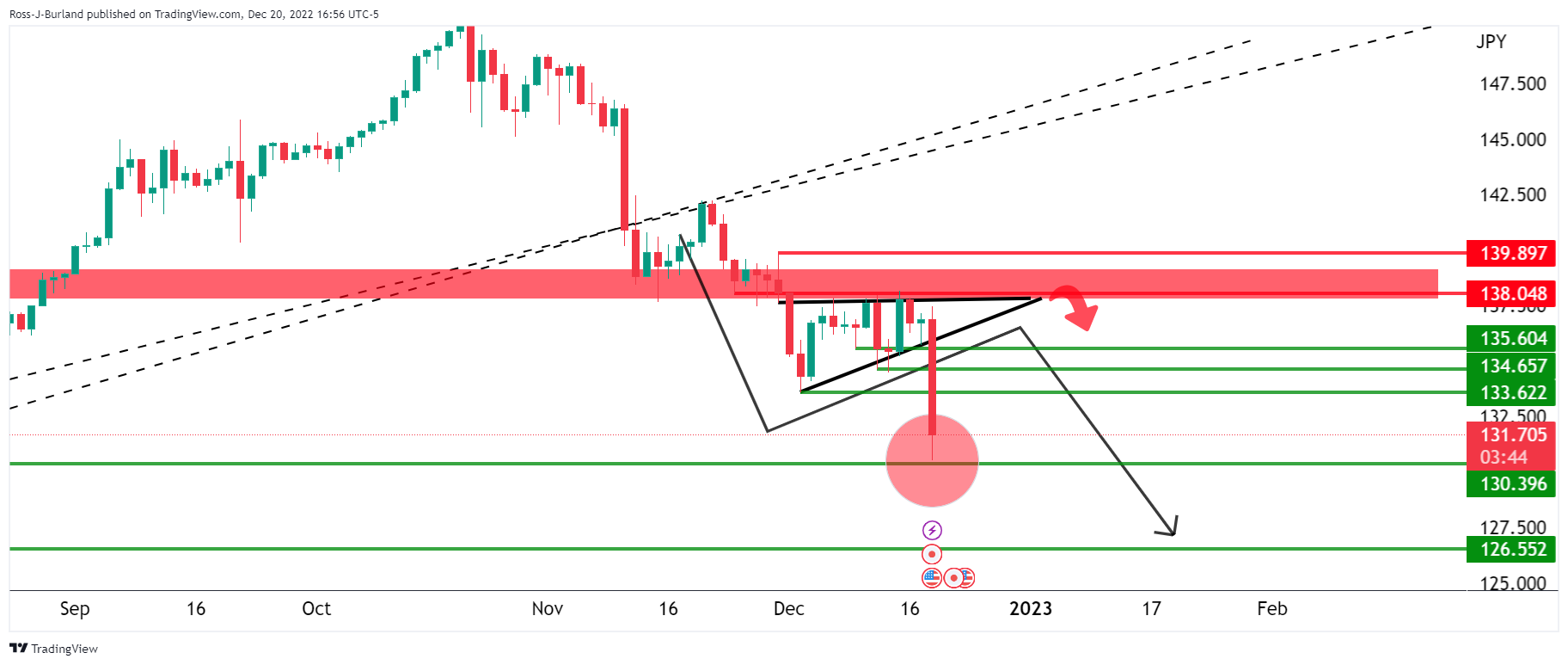
The bears moved in on the first target near 130.50. At this juncture, a continuation towards 129.50 and then 126.50 is on the cards albeit with some volatility along the way is to be expected.
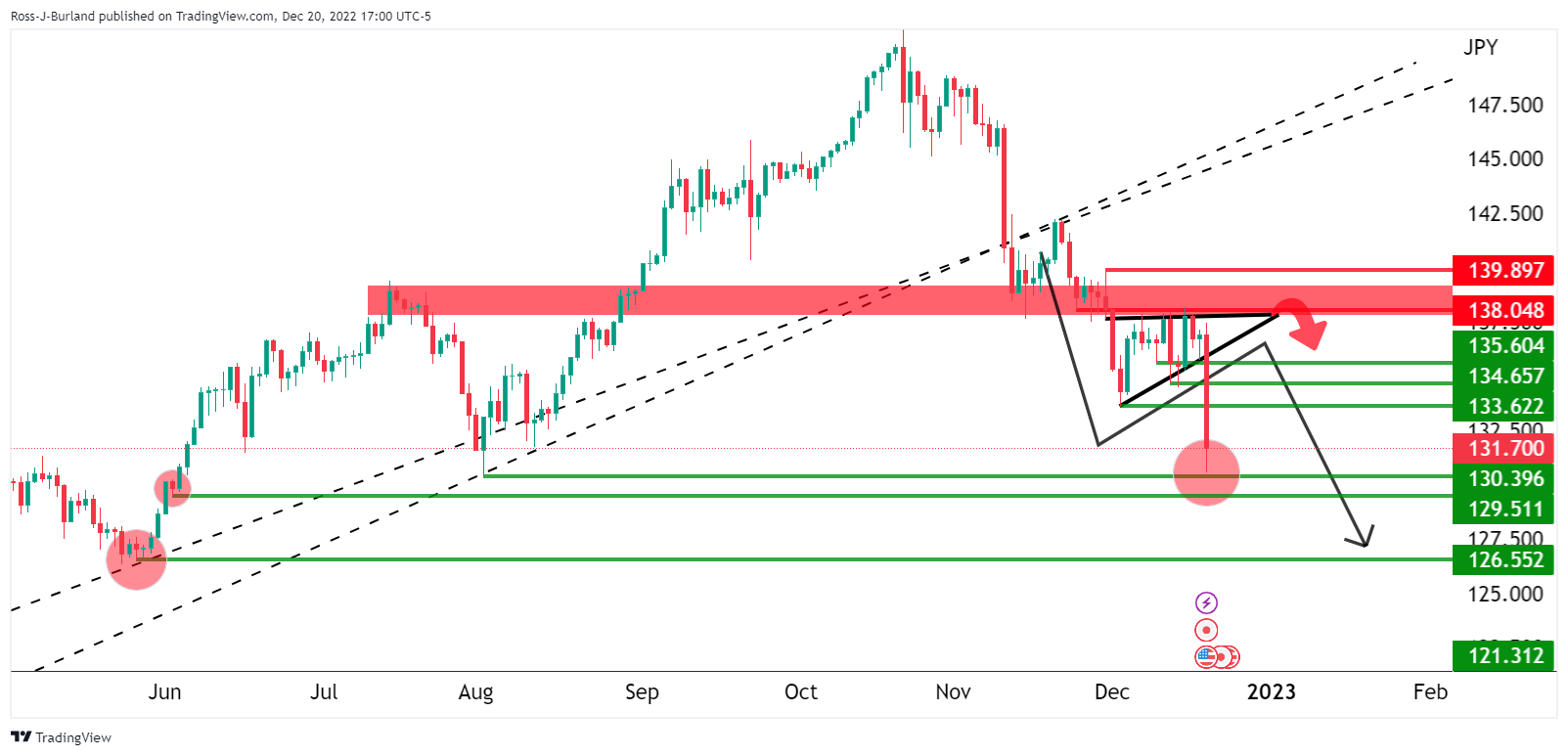
-
21:45
New Zealand Exports: $6.68B (November) vs $6.14B
-
21:45
New Zealand Imports climbed from previous $8.27B to $8.54B in November
-
21:45
New Zealand Trade Balance NZD (MoM) came in at $-1863M below forecasts ($-1091M) in November
-
21:45
New Zealand Trade Balance NZD (YoY) came in at $-14.63B, below expectations ($-12.717B) in November
-
21:24
AUD/USD Price Analysis: Bulls moving in at a discount to target 0.68s
- AUD/USD bulls are moving in from a peak bottom formation.
- Focus is on a move into the 0.68s for the days ahead.
- Eyes on DXY headed towards 102.00 while on front side of bearish cycle's trendline.
As per the prior day's analysis, AUD/USD Price Analysis: Bulls are moving in with eyes on a 61.8% Fibonacci retracement towards 0.6800, while the overall thesis is for a move to 0.6500, there is a meanwhile prospect for 0.6800 still.
In the latest price action, we have seen a sweep of liquidity to 0.6630 which could now result in a move to the upside with 0.6700 as a focus and then 0.6736 to make way for 0.6800 as the following analysis of the current schematic illustrates.
AUD/USD prior analysis
On the daily time frame it was shown that there is a price imbalance (PI) between 0.6736 and 0.6810 with the 61.8% ratio eyed as a confluence:
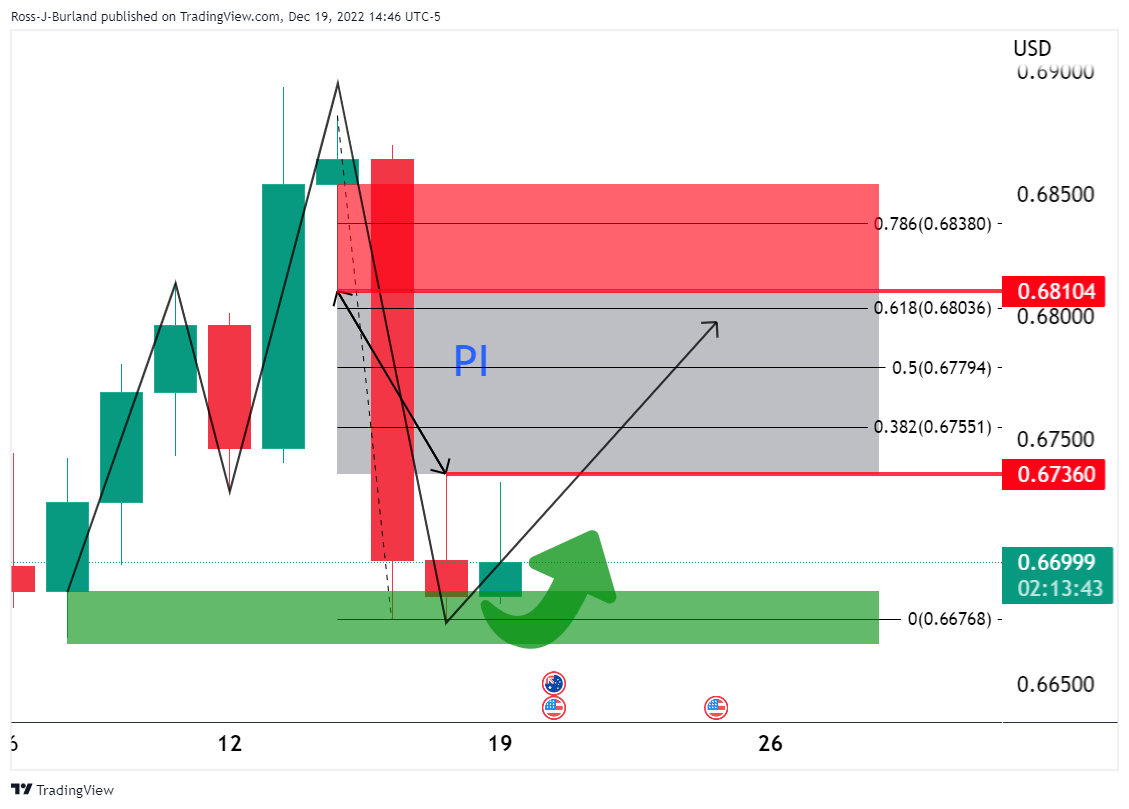
On the lower time frames, it was stated that the bulls will want to see a break of the trendline and prior lower high to confirm a bullish bias:
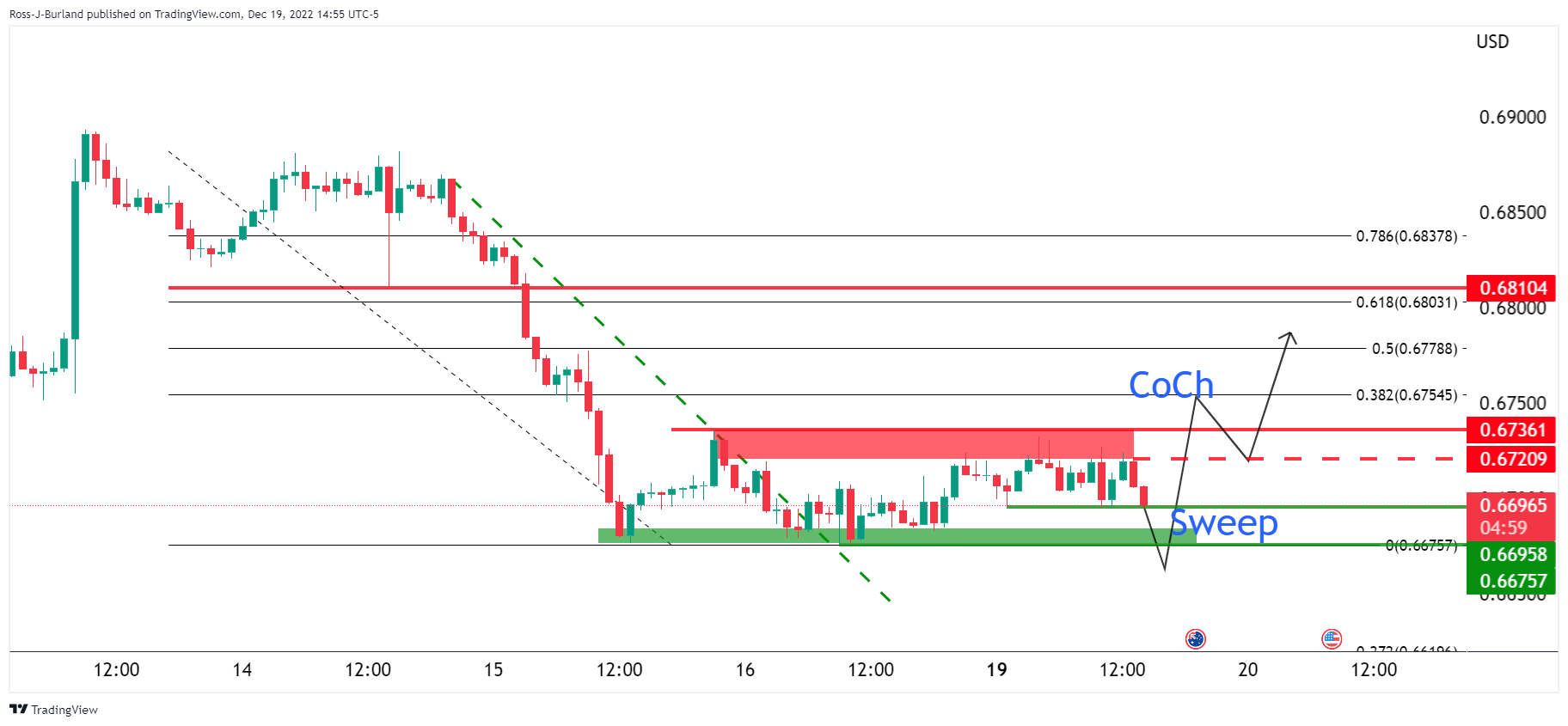
It was shown that there was a break in the trendline on the hourly chart but the market was coiling sideways.
there were equal lows at 0.6695 that were being pressured with liquidity in market orders expected below and under 0.6675 lows.
It was stated that a ''sweep' of the liquidity could result in a surge of demand from the bulls and ultimately provide enough fuel to take out the 0.6720 and then the 0.6736 resistance and create a change of character (CoCh) in the structure to bullish.
However, for the immediate future, 0.6685 and 0.6700 are going to be important levels:
AUD/USD update
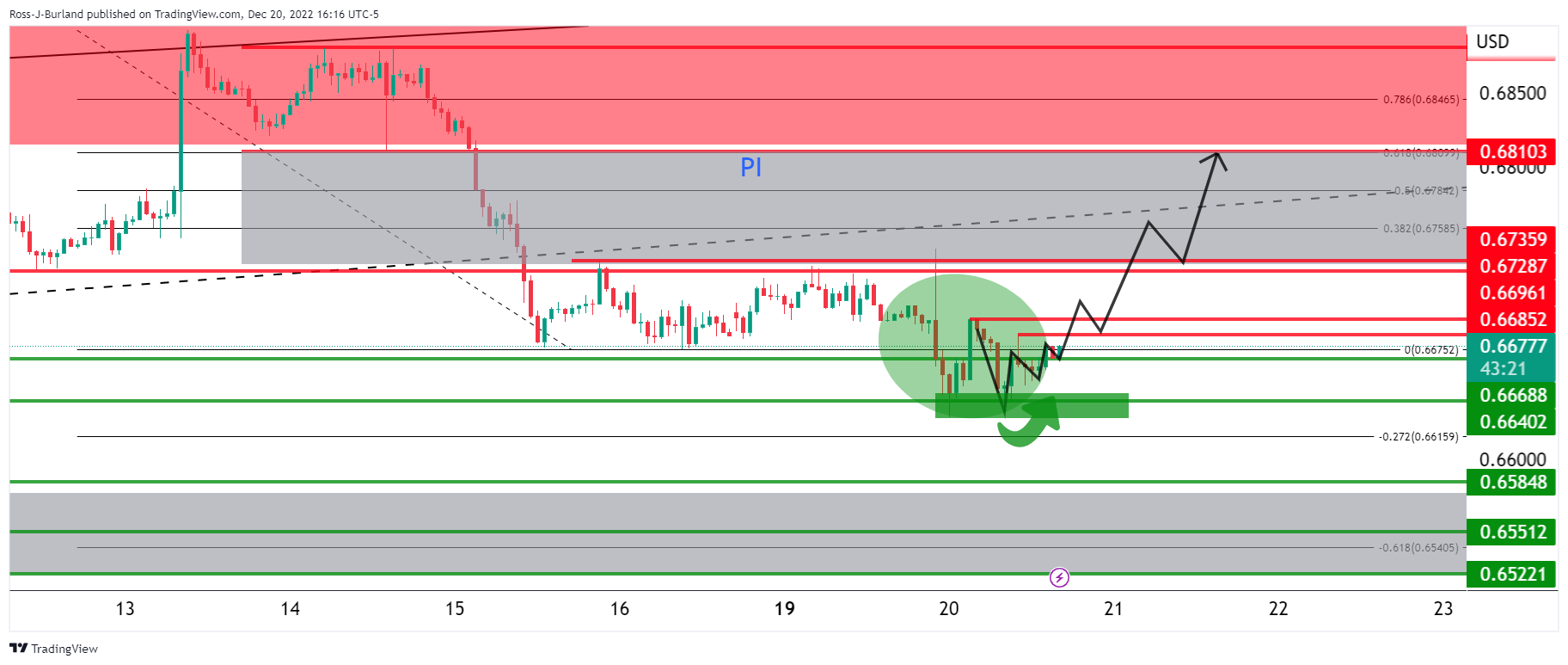
The W-formation is being formed and should the neckline hold around 0.6670, then there will be prospects of a move to test 0.6685 resistance. A break here will result in a change of character in the market and put the bulls back into control as per the daily chart:

This would tie up with the outlook for the US dollar as per the DXY daily chart:
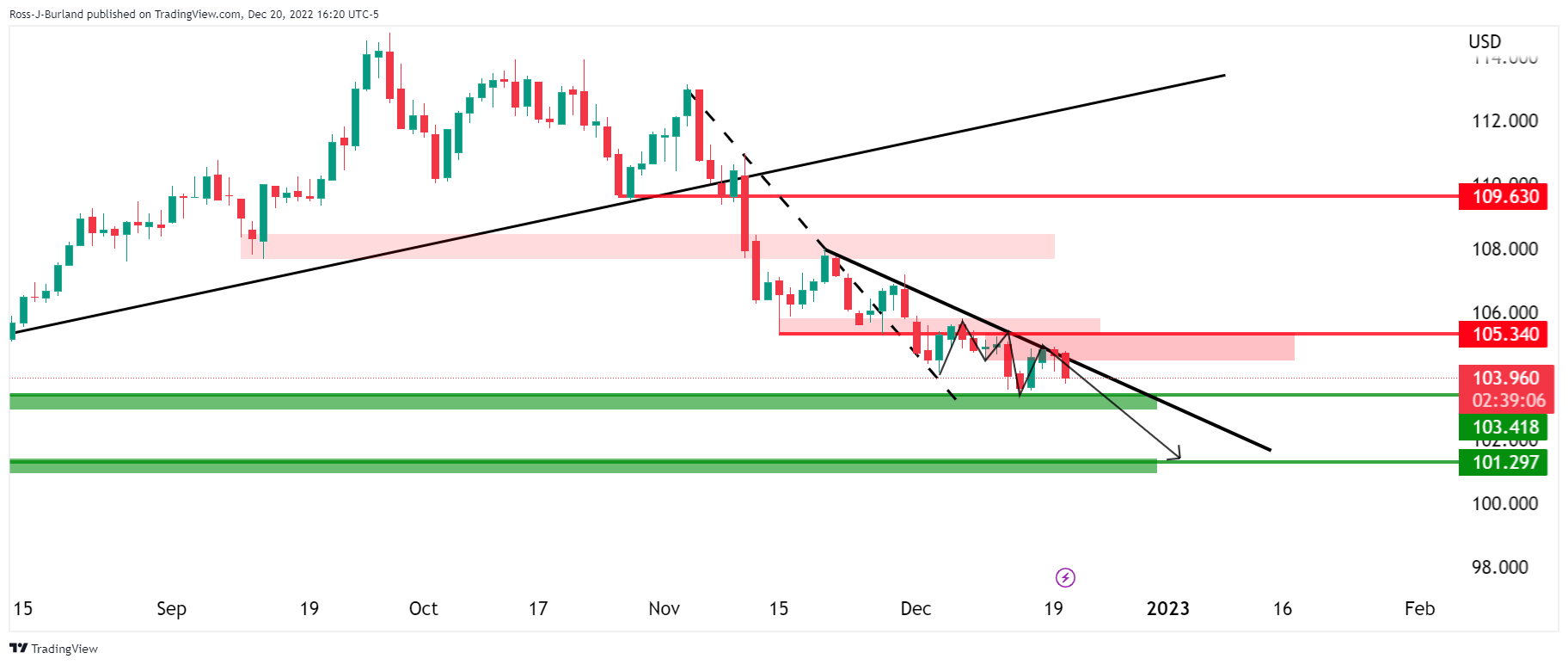
In prior analysis:
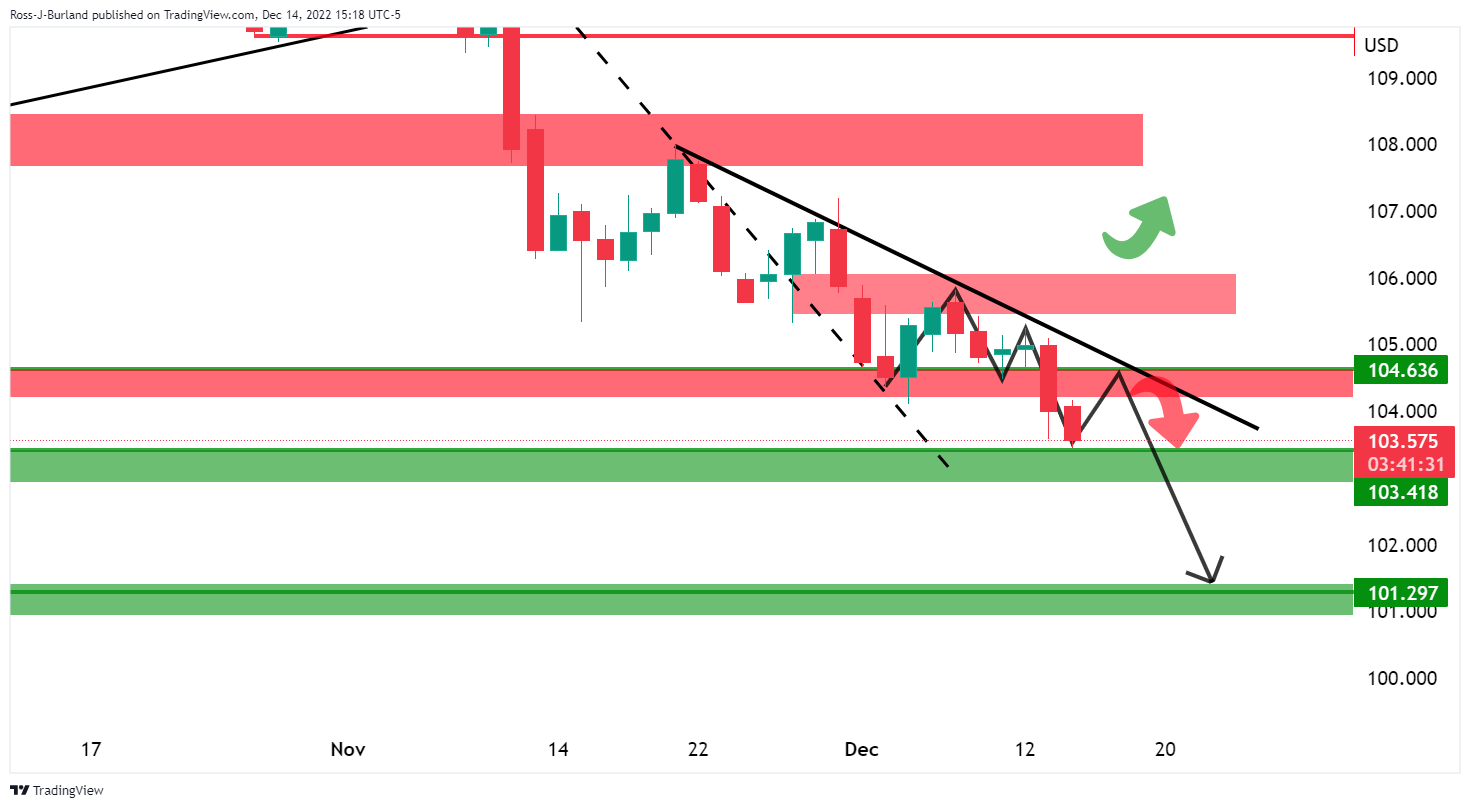
It was stated that the M-formation is a reversion pattern that had shown up on the daily chart above.
While on the front side of the trendline, a move into the neckline would be considered the next phase of the bearish cycle prior to a downside continuation to test 102.00 and below. We are now in the throws of such a move as illustrated above.
-
20:14
Gold Price Forecast: XAU/USD reversing its technical path (or is it?) despite Bank of Japan surprise move
- Gold price is making tracks to the upside despite the Bank of Japan's surprise relaxation on the yield of its 10-year bonds (JGBs).
- US Dollar sinks as the Yen rallies to the moon.
- US Treasury yields and a hawkish Federal Reserve could be the spanner in the works for the Gold price bulls.
The Gold price is higher on Tuesday due to volatility in the market that has sent the USD Dollar lower on the back of a surge in the Japanese Yen following a surprise move by the Bank of Japan (BoJ) in Asian markets.
Gold price rallies on Bank of Japan's surprise move
A decision by Japan's central bank to raise a cap on the yield of its 10-year Japanese government bonds (JGBs) sent markets into a state of shock and lured investors away from US debt. The BoJ is allowing 10-year bonds to trade at interest rates up to 0.5%, up from 0.25% and such a rise in the cap encourages domestic buying of its bonds. However, the Gold price has rallied despite the subsequent lower global borrowing costs and sell-off in bonds across the world, likely as a direct effect of a cheaper US Dollar.
US Dollar is slammed as Yen soars
Nevertheless, the US Dollar has sunk as per the DXY index as the Bank of Japan (BoJ) switches gears which sent the Yen around 5% higher vs the USD. USD/JPY fell from a pre-BoJ high of 137.40 to a low of 130.56. Consequently, the US Dollar as measured against a basket of currencies, including the yen which makes up 13.6% of the basket fell to a low of 103.77. DXY was trading at a high of 104.90 before the announcement by the BoJ.
US Treasury yields and yield curve in view
Nevertheless, higher global yields are potentially capping the rally in the Gold price since Gold offers no interest. The benchmark 10-year Treasury note yields rose to 3.710 and two-year note yields rose to 4.312% although they have started to come off their highs and Gold price is finding demand in late North American trade. Nevertheless, the US Treasury yield curve between two-year and 10-year Treasury notes remains at deeply negative levels, indicating concerns about an impending recession which is commonly positive for the US Dollar.
Federal Reserve sentiment remains key
Going forward, what is going to be critical for the Gold price is the sentiment surrounding the Federal Reserve (Fed). After rising as high as 5.5% after last week’s Federal Open Market Committee (FOMC) meeting, the terminal rate as seen by the swaps market fell back to just below 5.0% despite the hawkish rate hike.
''We cannot understand why the markets continue to fight the Fed,'' analysts at Brown Brothers Harriman said. ''With the exception of some communications missteps here and there, Fed chair Jerome Powell and company have been resolute about the need to take rates higher for longer. Although the media embargo has been lifted, there are no Fed speakers scheduled this week.''
Gold price technical analysis
Prior Gold price analysis:

It was stated that the downside bias in Gold price was in play so long as the bulls are kept at bay below the counter trendlines and $1,800. The price has instead rallied on Tuesday and the bales could be turning. However, holiday markets are setting in and it is uncommon for intended momentum trade setups to play out in what are usually choppy conditions for the Gold price.
Gold price update

The Gold price has switched bullish as per the move into the $1,800s and bulls are now facing a resistance area.
However, Gold price markets do one of three things: 1) Break out, pull back and continue 2) break out pull back and reverse, or 3), break out, pull back and go into a trading range.
Gold price scenario 1:
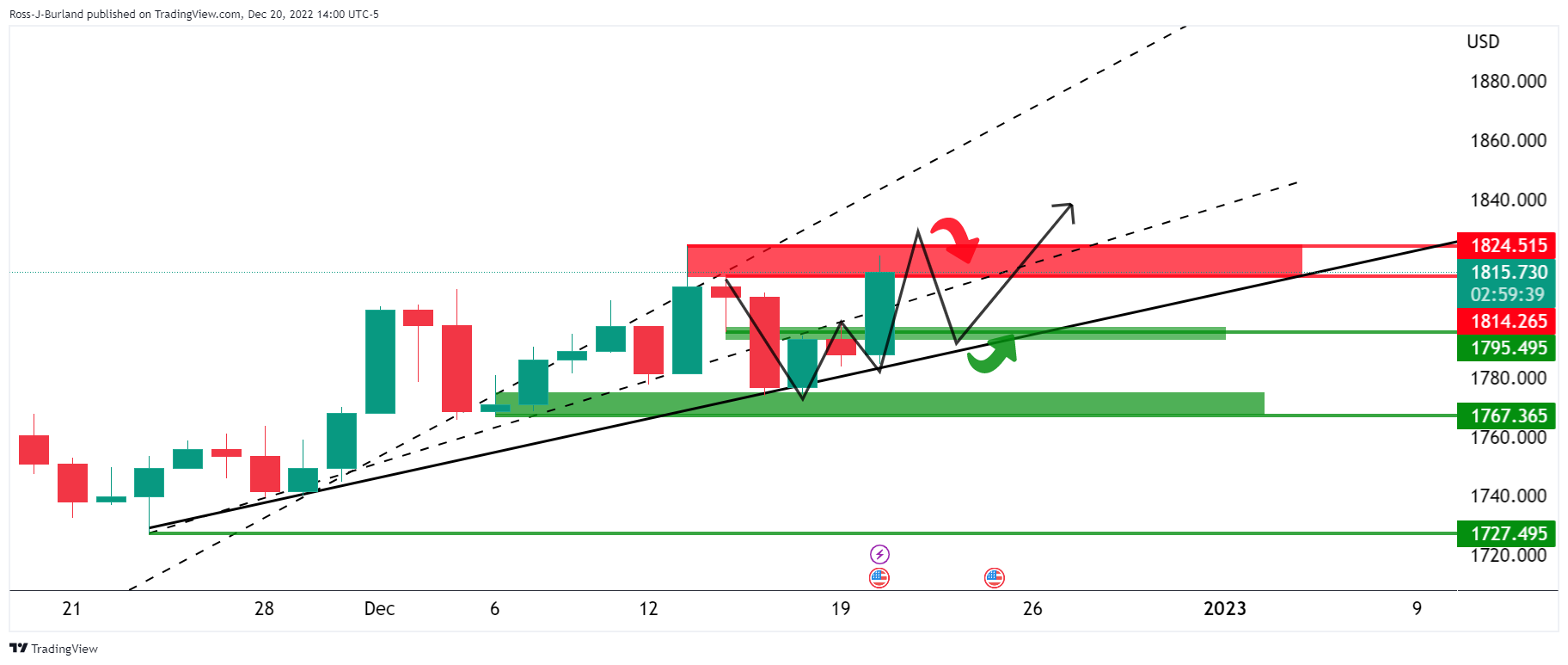
Gold price scenario 2:

Gold price scenario 3:
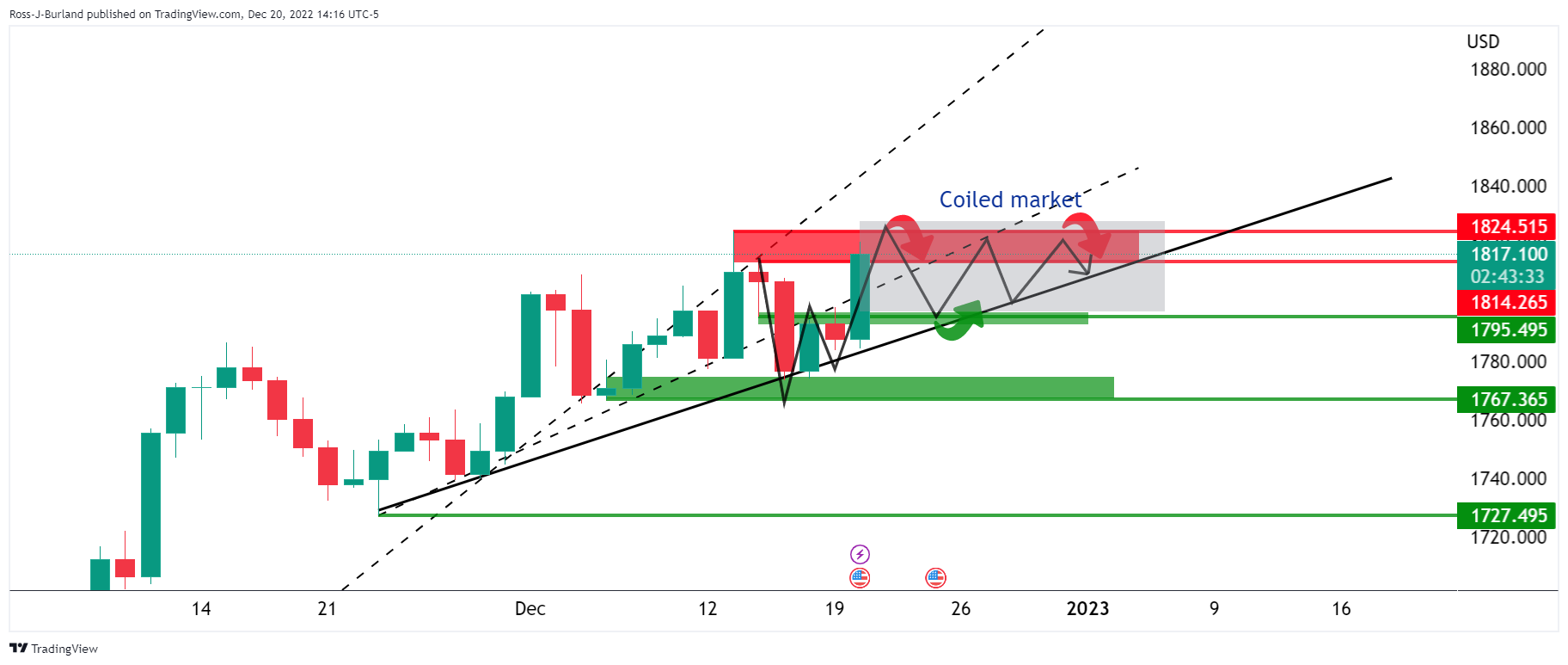
Gold price lower time frames
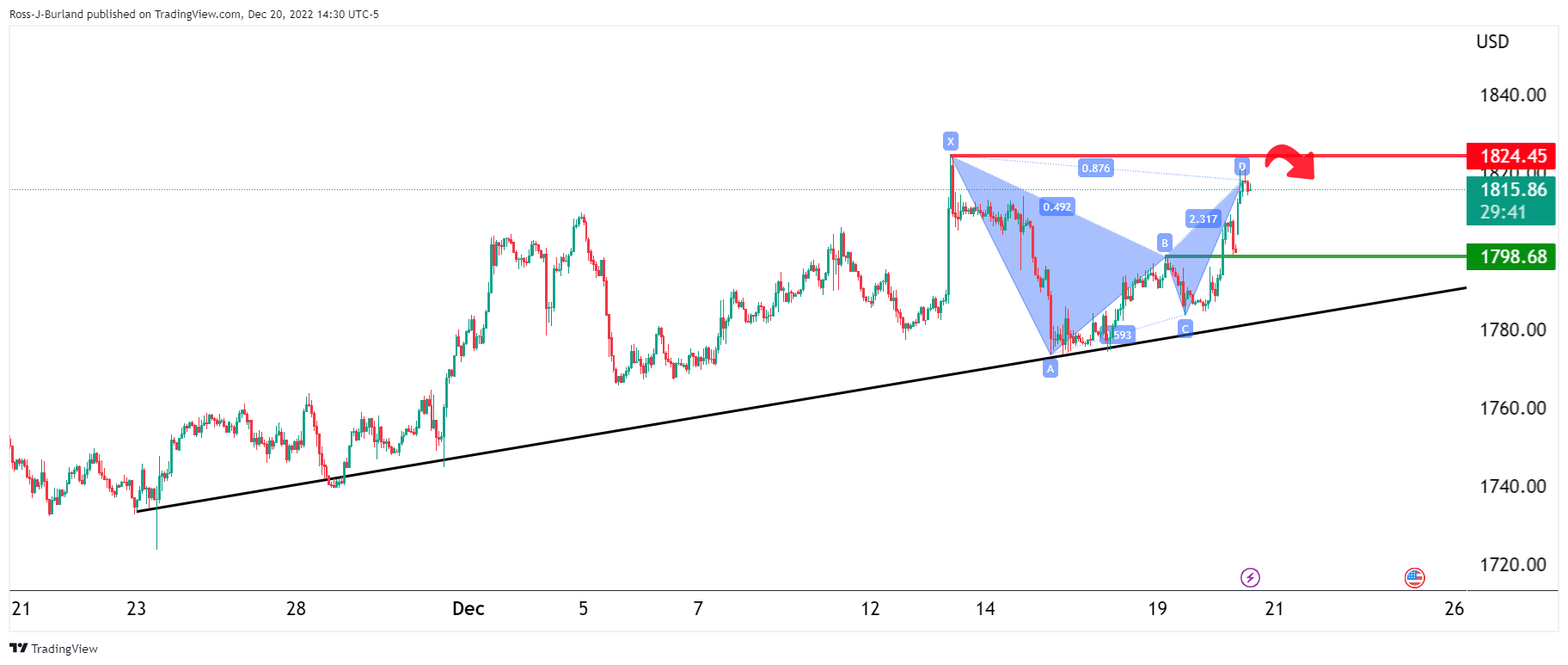
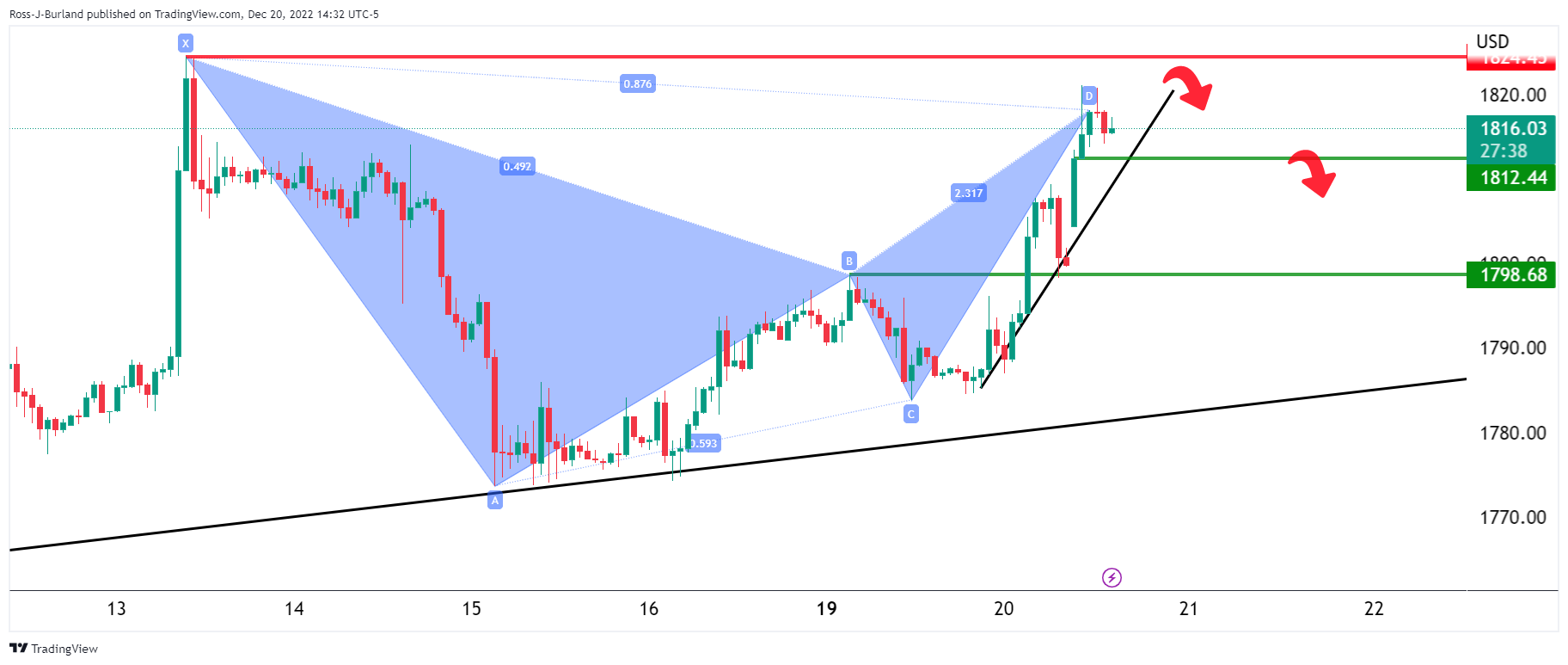
The Gold price 1-hour picture is bearish while below the resistance near $1,825 but not until the Gold price moves to the backside of the micro trend line:

On the 15-minute chart for the Gold price, we can draw the extensions to the downside based on the presumed sideways consolidation box that could form over the coming sessions/days due to the pull of the harmonic bearish pattern on the Gold price daily chart.
-
19:49
Forex Today: US Dollar on the back foot, despite a better mood
What you need to take care of on Wednesday, December 21:
The US Dollar plunged early on Tuesday, recovering ground unevenly throughout the rest of the day to end the day mixed. The Bank of Japan (BoJ) triggered the Greenback sell-off as the Japanese central bank announced its monetary policy decision. The BoJ left its benchmark rate unchanged at -0.1% and maintained the 10-year Japanese Government Bond (JGB) yield at 0.00%, as expected. Policymakers, however, introduced a minor twist: they will allow the 10-year JGB yield to fluctuate between -0.5% and 0.5%, compared to -0.25% and 0.25% previously, and noted that they would review the yield curve control operation.
Following the decision, BoJ’s Governor Haruhiko Kuroda reaffirmed the central bank's dovish stance, repeating they are ready to ease further if needed and noting it is no time to debate exiting quantitative tightening. The USD/JPY pair plummeted to 130.55, its lowest since early August, and now trades at around 131.50 while heading into the Asian opening.
Asian shares plunged, while European indexes also closed in the red, but managed to trim most of their intraday losses. Wall Street shrugged off the downbeat mood and maintained the green by the end of the day.
Meanwhile, US Treasury yields advanced, although that on the 10-year note did it at a faster pace than the one on the 2-year one. The yield curve remains inverted, but the distance is shrinking.
EUR/USD was unable to advance beyond 1.0650 and finished another day little changed just above the 1.0600 level. GBP/USD seesawed between gains and losses but finished the day flat at 1.2150.
AUD/USD reached a fresh December low of 0.6628 and finished the day in the red, undermined by the poor performance of Asian and European stock markets. US better tone was not enough to put the pair back into the green.
The USD/CAD pair finished the day in the red at around 1.3610, with the CAD underpinned by higher oil prices. WTI settled at $76.25 a barrel.
Canada will publish November inflation figures on Wednesday.
Gold soared on the broad US Dollar weakness, and currently trades at $1,816 a troy ounce.
Like this article? Help us with some feedback by answering this survey:
Rate this content -
18:29
GBP/USD Price Analysis: On track for strongest quarterly gain against USD since 2009
- GBP/USD is coming to a peak in a coil which puts to an imminent breakout.
- The emphasis is currently on a test of 1.2080 for the coming sessions.
- If the bears fail to break this level of support, then a meaningful correction to the upside will be on the cards.
GBP/USD remains on the backside of the late September rally's trendline where the pair gained some 20% in the quarter so far, albeit shedding gains to around 3% to the current spot price and consolidation lows of 1.20975. Still, the Pound Sterling is on track for its best quarter in more than 13 years. However, However, GBP/USD remains about 10% lower for the year and the following analysis is going to be through the eyes of the bears.
GBP/USD was last -0.6% having fluctuated in and out of the positive territory on Tuesday, driven by volatility due to the Bank of Japan's (BoJ) surprise tweak to its bond yield control. The BoJ is now allowing long-term interest rates to rise more in a move aimed at easing some of the costs of prolonged monetary stimulus.
This means that the Japanese could be looking to bring assets home, sinking all ships vs. the yen on the forex board. However, the price is now settled back within the volatility between 1.2223 and 1.2084 but it is coiled into a potential breakout peak below 1.2150.
GBP/USD Daily chart
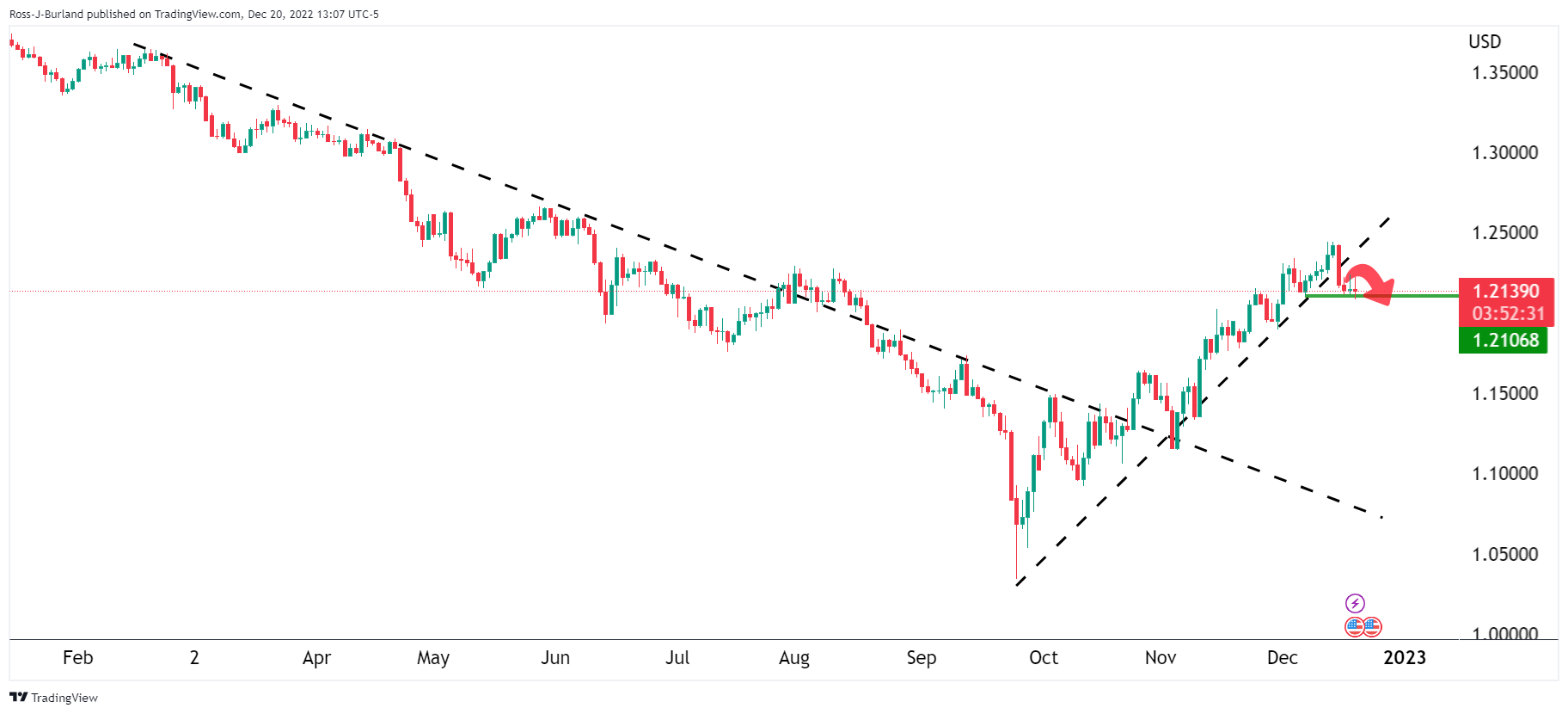


As the images above show, the price is on the backside of the trend and us testing the 1.2100 support. An upside correction into the prior bearish impulse would be expected which eyes 1.2250 resistance that is marked by the volume profile and confluence with the 38.2% Fibonacci retracement as well as the prior structure.
GBP/USD H4 charts
However, moving down to the lower time frames, the bears are flexing and we may have seen the last-ditch effort from the bulls already:

Meanwhile, the coil is coming to a peak and a break out is expected one way or the other. If the price imbalances above are not swept, then the outlook could play out as the above.
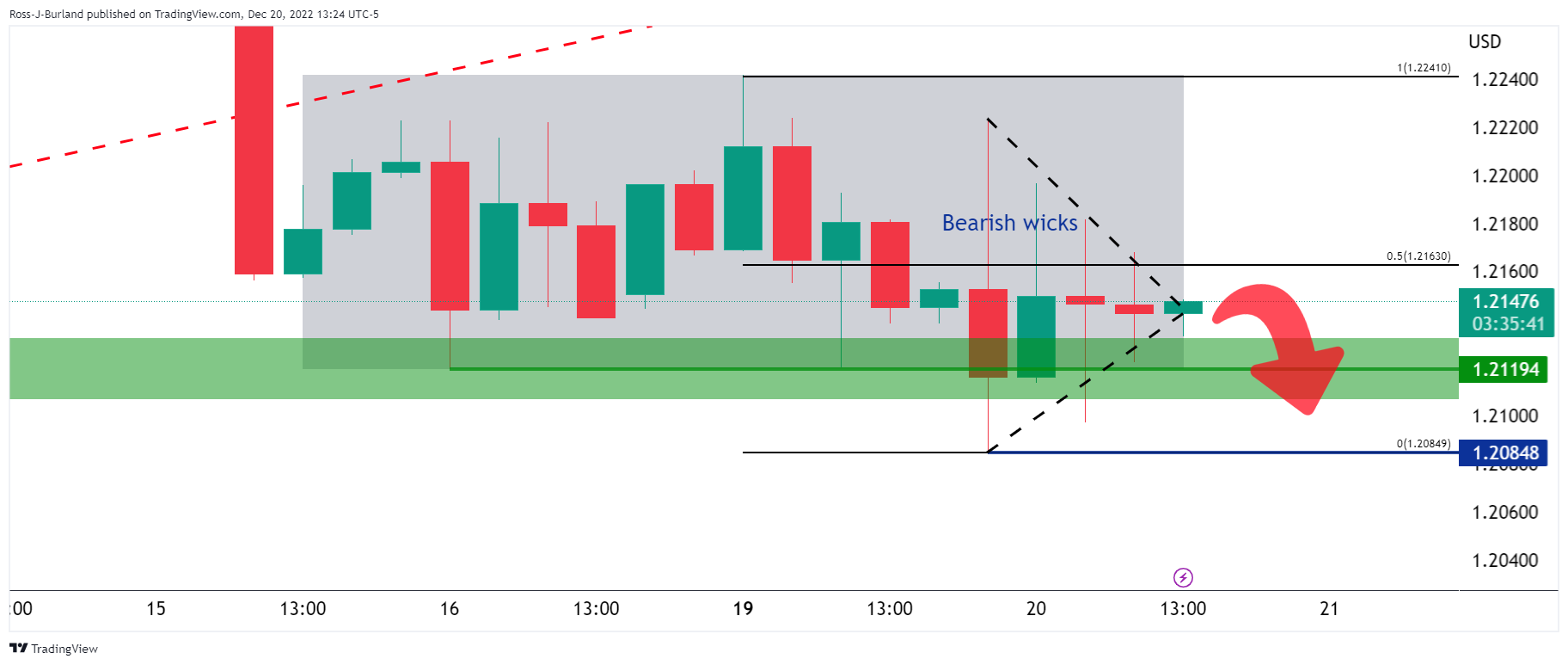
Staying with the bearish bias, the bearish wicks are a compelling feature which puts the emphasis on a test of 1.2080 for the coming sessions. If the bears fail to break this level of support, then a meaningful correction to the upside, as oper the daily chart, has a higher probability of playing out.
-
18:24
Colombia Trade Balance up to $1475M in October from previous $-1401M
-
17:00
GBP/JPY drops below 160.00 to the lowest since September; down more than 700 pips
- GBP/JPY loses more than 4%, on worst day in months.
- Next medium-term support at 158.00.
- Japanse Yen soars across the board after the Bank of Japan’s decision.
The GBP/JPY cross is losing more than 700 pips on Tuesday amid a rally of the Japanese Yen following the Bank of Japan’s monetary policy announcement.
The decision of the Bank of Japan to raise the upper range of its yield curve control of the 10-year bond from 0.25% to 0.50% boosted the Japanese Yen, that is having one of the most significant gains in years. The announcement took markets by surprise, leading to a selloff in government bonds.“Governor Kuroda stressed that the move did not represent tightening and that it was made to improve market functioning. While the policy rate was kept at -0.10%, speculation will grow for an eventual rate hike next year. We thought it was an H2 prospect but today’s move suggests it could happen as early as H1. Furthermore, given Governor Kuroda’s propensity for surprises, this hike could come under his watch rather than his successor’s”, explained analysts at Brown Brothers Harriman.
The Yen is rising by more than 4% against its main rivals on Tuesday. The GBP/JPY cross is down by more than 700 pips, on its way to the lowest daily close since September 29.
Recently the cross bottomed at 159.06 and it is hovering around 159.40. Before BoJ’s decision, it was trading at 166.70. On the downside, the next strong support area is seen around 158.00.
Technical levels
-
16:16
USD/JPY tumbles by more than 4.5%, tests 131.00
- Yens keeps rising across the board after Bank of Japan’s surprise.
- USD/JPY drops by more than 4% on Tuesday.
- US dollar mixed across the board, on risk appetite.
The USD/JPY dropped even further during the American session and bottomed at 131.00, the lowest intraday level since August 2. It remains near the low, falling more than 550 pips or 4.15%.
The pair is headed toward the lowest daily close since June with the Yen having one of the biggest daily gains across the board boosted by the decision of the Bank of Japan to raise the upper banks of its yield curve control of the 10-year bond from 0.25% to 0.50%.
BoJ breaks market correlation?
It was a small change from the BoJ but market participants are seen a lot more. The impact of the announcement shows that a more significant policy shift could take place much sooner than expected.
Until a few hours ago, higher US yields meant a weaker Japanese Yen and bearish pressure for gold. The Japanese Yen is having the best day in years across the board and Gold prices are at weekly highs.Main indexes in Wall Street are now positive for the day, not affected by higher US yields. Back in the old days, prior to the wide divergence between the Federal Reserve and the BoJ monetary policy, higher yields were normal at times of optimism in the equity market, reflecting money going out of safer assets, looking for higher returns.
Technical levels
-
16:06
US: Atlanta Fed GDPNow for Q4 declines to 2.7%
According to the Federal Reserve Bank of Atlanta's GDPNow model, the US economy is expected to grow at an annualized rate of 2.7% in the fourth quarter, down slightly from 2.8% in the previous estimate.
"After this morning’s housing starts report from the US Census Bureau, the nowcast of fourth-quarter real residential investment growth decreased from -21.2% to -21.5%," the Atlanta Fed explained in its publication.
Market reaction
This report doesn't seem to be having a significant impact on the US Dollar's performance against its major rivals. As of writing, the US Dollar Index was down 0.7% on the day at 103.95.
-
15:57
A small step for the BoJ, a big step for the Yen – SocGen
The Yen has gained more than 3% against the Dollar today after the Bank of Japan (BoJ) surprised by shifting its Yield Curve Control (YCC) framework. Kit Juckes, Chief Global FX Strategist at Société Générale, believes that the JPY may have further to run.
Yen reached lows not seen since 1973, and has room to bounce
“The BoJ widened the band in which 10yr JGB yields can fluctuate to +/-50 bps and announced daily operations to buy 10-year JGBs at a yield of 0.5%. Monthly purchases will increase from Y7.3 trn to about Y9 trn. The BoJ emphasises that this move is intended tackle the (damaged) functioning of the bond market but attempts to downplay it’s policy significance will fall on deaf ears.”
“This is a change of direction for the BoJ, which has stood firm against any shift in recent months. Symbolically, this is an important step. Also, the Yen remains undervalued on almost any measure. In real effective terms, it had fallen to its lowest level since 1973.”
“We’ve previously argued that big USD/JPY swings are largely a function of Japan’s net international investment position, and changes in FX hedging ratios. This move increases pressure to hedge foreign asset portfolios and so, to buy the Yen, in thin holiday markets.”
-
15:52
Gold Price Forecast: XAU/USD hits fresh weekly highs above $1,820
- US Dollar weakens during the American session as market sentiment improves.
- Gold rises further despite higher US yields.
- XAU/USD with bullish bias, looking at monthly highs around $1,825.
Gold prices broke above $1,810 and jumped to $1,821 reaching the highest level in a week. XAU/USD remains around $1,1815 looking at the monthly high amid an improvement in market sentiment and despite higher US yields.
Equity prices in Wall Street accelerated to the upside during the last hours after opening in negative ground. The Dow Jones is up by 0.50% and the Nasdaq gains by 0.42%. US yields are off highs but still up for the day. The US 10-year bond yield rose to 3.70%, the highest level since November. Also European yields are up, boosted by the Bank of Japan (BoJ) surprise.The BoJ widened the band of its yield curve control and triggered a selloff in bond around the globe. Gold prices held relatively steady and then started to rise on European hours. After the beginning of the American session, XAU/USD rose even further.
Short-term outlook
Gold prices are now looking at the monthly high around $1,825. A break higher would expose the next resistance area $1,830. The outlook is bullish for gold, however a slide back below $1,810 should keep XAU/USD in the wide range with support at the 20-day Simple Moving Average at $1,780.
A daily close around current levels would be the strongest since late June. On the downside, a daily close under $1,765 could suggest a near term peak.
Technical levels
-
15:46
Precious metals could face considerable setback potential – Commerzbank
Latest surge in precious metals prices was presumably supported by speculative buying. Thus, the sector faces considerable setback potential, strategists at Commerzbank report.
Potential for further gains could be limited
“The surge in precious metals prices to multi-month highs that has been observed since early November is likely to have been driven by speculative buying.”
“The potential for further gains will be limited if speculative financial investors rethink their recently optimistic attitude towards precious metals given the prospect of more pronounced interest rate hikes next year.
“If previous long positions were to be liquidated or new short positions built up, prices could even face considerable setback potential.”
-
15:29
BoJ shift likely to fuel further JPY strength – MUFG
The Bank of Japan shifts its yield curve control (YCC) stance with obvious consequences. USD/JPY could be into the 120’s sooner than analysts at MUFG Bank expected.
BoJ’s surprise will impact all FX market players
“The BoJ has surprised the markets by announcing an adjustment to its YCC policy. Nobody will be surprised to see the 10yr JGB yield jump close to the top of the new trading range around zero percent of +/-50 bps.”
“To us this decision will impact all FX market players – corporate hedging behaviour; investor hedging behaviour; speculative behaviour; and capital flows.”
“The shift from the BoJ merely reinforces a strong and compelling view that the divergence at the heart of the surge in JPY selling in 2022 is going to reverse in 2023, resulting in a reversal of JPY selling that took the Yen to record levels of under-valuation.”
“USD/JPY could be into the 120’s sooner than we expected.”
-
15:19
Colombia Trade Balance: $-1475M (October) vs previous $-1401M
-
15:15
NZD/USD finds support at 0.6300 and rebounds toward 0.6350
- US Dollar post mix results across the board on Tuesday.
- NZD and AUD are among worst performers hit by BoJ.
- NZD/USD faces next resistance at 0.6365, key support at 0.6300.
The NZD/USD dropped to test the 0.6300 area after the beginning of the American session. Buyers again appear and pushed the pair back to the 0.6340 area.
Risk sentiment improves, helping Kiwi
Equity prices in the US turned positive amid an improvement in market sentiment. The Dow Jones is up by 0.19% and the Nasdaq by 0.03%. Commodity prices are trading near daily highs.
Treasury bond yields are up following the Bank of Japan (BoJ) policy announcement. Early on Tuesday, the BoJ shocked markets by easing its bond-yield controls. This was seen as a potential shift. The US 10-year reached 3.70% while the 2-year rose to 4.30%. Higher yields are giving some support to the US Dollar. The DXY is falling by 0.75%, mostly due to the USD/JPY’s slide of more than 3%. The Kiwi and the Aussie are the worst performers among G10 currencies.
US economic data released on Tuesday came in below expectations. Building Permits tumbled 11.2% to 1.342 million (annual rate) below the 1.470 million of market consensus. Housing starts dropped less than expected to 1.427 million.
Technical outlook
The NZD/USD is rebounding after being able to hold above 0.6300. A break lower would open the doors to more losses. The next relevant support is seen at 0.6250. On the upside, the pair faces a critical resistance at 0.6365 (horizontal level and the 20-Simple Moving Average in 4-hour chart). A break higher could lead to a test of 0.6400.
Technical levels
-
15:13
Eurozone Consumer Confidence Index improves to -22.2 in December vs. -22 expected
- Consumer Confidence Index in the Eurozone rose modestly in December.
- EUR/USD continues to trade in positive territory near 1.0650.
Consumer sentiment in the Euro area improved modestly in December with the Consumer Confidence Index rising to -22.2 from -23.9 in the flash estimate. This reading came in slightly weaker than the market expectation of -22.
In the EU, the Consumer Confidence Index rose by 1.4 points to -24.4.
"Consumer confidence remains well below its long-term average but is now slightly above the trough reached at the onset of the COVID-19 pandemic," the European Commission noted in its publication.
Market reaction
EUR/USD pair edged higher after this report and was last seen rising 0.4% on the day at 1.0648.
-
15:01
European Monetary Union Consumer Confidence came in at -22.2 below forecasts (-22) in December
-
15:01
S&P 500 Index could slump to the 3000 level – Morgan Stanley
Economists at Morgan Stranley expect price declines for equities. The S&P 500 Index could fall to the 3000 level.
Have markets fully priced an earnings decline?
“We are feeling more confident about our 2023 forecast for S&P 500 earnings per share of $195. This remains well below both the bottoms up consensus of $231 and the top down forecasts of $215.”
“The consensus view on the buy side is now that we won't make new lows on the S&P 500 next year, but will instead defend the October levels or the 200 week moving average, approximately 3500 to 3600 on the S&P 500.”
“We remain decidedly in the 3000 to 3300 camp with a bias toward the low end given our view on earnings.”
“With the year end Santa Claus rally now fading, there is reason to believe the decline from last week is the beginning of the move lower into the first quarter for stocks that we've been expecting, and when a more sustainable low is likely to be made.”
-
14:59
New Zealand GDT Price Index: -3.8% vs previous 0.6%
-
14:24
USD/JPY may break below 130.00 – ING
The Bank of Japan announced a surprise change in its yield curve control policy. The immediate impact on the yen has been sizeable, with USD/JPY dropping more than 3%. The pair could slump under the 130 level, economists at ING report.
BoJ delivers last shock of the year
“The BoJ announced a surprising change in its YCC policy. The target band for the 10-year JGB has been widened to +/- 0.50% from the previous 0.25%, essentially allowing higher interest rates in the current inflationary environment despite still officially targeting 0.00% as the outright target. The move was accompanied by an increase in the amount of JGB purchases, from JPY7.3 tn per month to 9 tn.”
“For now, we think risks remain skewed to the downside for USD/JPY into the festive break, and we cannot exclude a break below 130.00 – also given the generally soft Dollar environment.”
“For now, the negative reaction in global equities is capping pro-cyclical currencies, and offering some USD support on balance, but broader dollar weakness is surely a possibility in the near term. DXY could press 103.50 by the end of this week.”
-
14:02
EUR/USD Price Analysis: Flirts with a nearly two-week-old ascending trend-line, around 1.0600
- EUR/USD extends its two-way price move for the second successive day on Tuesday.
- The setup supports prospects for the emergence of some dip-buying at lower levels.
- A break below a two-month-old ascending channel is needed to negate the positive bias.
The EUR/USD pair seesaws between tepid gains/minor losses through the early North American session and is currently placed in neutral territory, around the 1.0600 mark.
From a technical perspective, the EUR/USD pair, so far, has managed to defend support marked by an upward-sloping trend-line extending from December 7. A convincing break below might prompt aggressive technical selling and accelerate the fall towards the 100-period SMA on the 4-hour chart, currently around the 1.0520 area.
Meanwhile, oscillators on hourly charts have just started drifting in the negative territory and favour bearish traders amid looming recession risks. Technical indicators on the daily chart, however, are holding comfortably in the bullish zone and support prospects for the emergence of some dip-buying around the EUR/USD pair.
That said, some follow-through selling will make the EUR/USD pair vulnerable to weaken below the 1.0500 psychological mark and test the next relevant support near the 1.0460-1.0455 area. The latter coincides with the lower boundary of a nearly two-month-old ascending channel and should act as a pivotal point for short-term traders.
On the flip side, the 1.0650-1.0660 region now seems to have emerged as an immediate hurdle. This is closely followed by the 1.0680 horizontal barrier ahead of the 1.0700 round figure. Any subsequent move-up could meet with some supply near the trend-channel resistance, currently around the 1.0725 area, just ahead of the post-ECB swing high.
A sustained strength beyond will be seen as a fresh trigger for bullish traders and set the stage for an extension of the recent strong recovery move from over a two-decade low touched in September. The EUR/USD pair might then aim to reclaim the 1.0800 round-figure mark for the first time since April 2022.
EUR/USD 4-hour chart
-638071416064365696.png)
Key levels to watch
-
13:55
United States Redbook Index (YoY): 7.6% (December 16) vs 5.9%
-
13:37
Canada: Retail Sales rise by 1.4% in October vs -0.3% expected
- Retail Sales in Canada rose unexpectedly in October.
- USD/CAD trades in negative territory, holds above 1.3600.
Retail Sales in Canada rose by 1.4% on a monthly basis in October following September's 0.6% decline, the data published by Statistics Canada revealed on Tuesday. This reading came in much better than the market expectation for a decrease of 0.3%.
Retail Sales ex Autos increased by 1.7% in the same period, compared to analysts' estimate of 0.8%.
Market reaction
USD/CAD edged slightly lower with the initial reaction to this data and was last seen losing 0.15% on the day at 1.3622.
-
13:33
US: Housing Starts decline 0.5%, Building Permits plunge 11.2% in November
- Housing Starts and Building Permits in the US continued to decline in November.
- US Dollar Index stays in negative territory below 104.50.
The monthly data published by the US Census Bureau revealed on Tuesday that Housing Starts declined by 0.5% on a monthly basis in November following October's 2.1% contraction.
In the same period, Building Permits fell by 11.2%, compared to a 3.3% drop recorded in October.
Market reaction
These figures don't seem to be having a significant impact on the US Dollar's valuation against its major rivals. As of writing, the US Dollar Index was down 0.35% on the day at 104.30.
-
13:30
Canada Retail Sales (MoM) above forecasts (-0.3%) in October: Actual (1.4%)
-
13:30
Canada Retail Sales ex Autos (MoM) above forecasts (0.8%) in October: Actual (1.7%)
-
13:30
United States Building Permits Change: -11.2% (November) vs previous -2.4%
-
13:30
United States Building Permits (MoM) below forecasts (1.47M) in November: Actual (1.342M)
-
13:30
United States Housing Starts (MoM) above forecasts (1.415M) in November: Actual (1.427M)
-
13:30
United States Housing Starts Change climbed from previous -4.2% to -0.5% in November
-
13:28
Silver Price Analysis: XAG/USD seems poised to retest multi-month high, north of $24.00
- Silver catches fresh bids on Tuesday and rallies to the $24.00 neighbourhood.
- The technical setup favours bulls and supports prospects for additional gains.
- A break below the $22.80 confluence is needed to negate the positive outlook.
Silver gains strong positive traction on Tuesday and rallies to a fresh daily high, back closer to the $24.00 mark in the last hour. The white metal, however, trims a part of its intraday gains and retreats to the mid-$23.00s heading into the North American session.
Given the recent bounce from a confluence comprising an ascending trend-line extending from November low and the 100-period SMA on the 4-hour chart, the bias seems tilted in favour of bulls. The positive outlook is reinforced by the fact that oscillators on the daily chart are holding comfortably in the bullish territory and have again started gaining traction on the 4-hour chart.
That said, RSI (14) on the 1-hour chart flashes slightly overbought conditions and holds back traders from positioning for any further gains. Nevertheless, the XAG/USD still seems poised to surpass the $24.00 mark and retest the multi-month top, around the $24.10-$24.15 area touched earlier this month. Some follow-through buying should pave the way for additional near-term gains.
On the flip side, the $23.30 horizontal support now seems to protect the immediate downside ahead of the $23.00 mark and the aforementioned confluence, currently around the $22.80 region. A convincing break below will negate the constructive set-up and prompt aggressive technical selling. The XAG/USD might then slide to the next relevant support near the $22.00 round figure.
Silver 4-hour chart
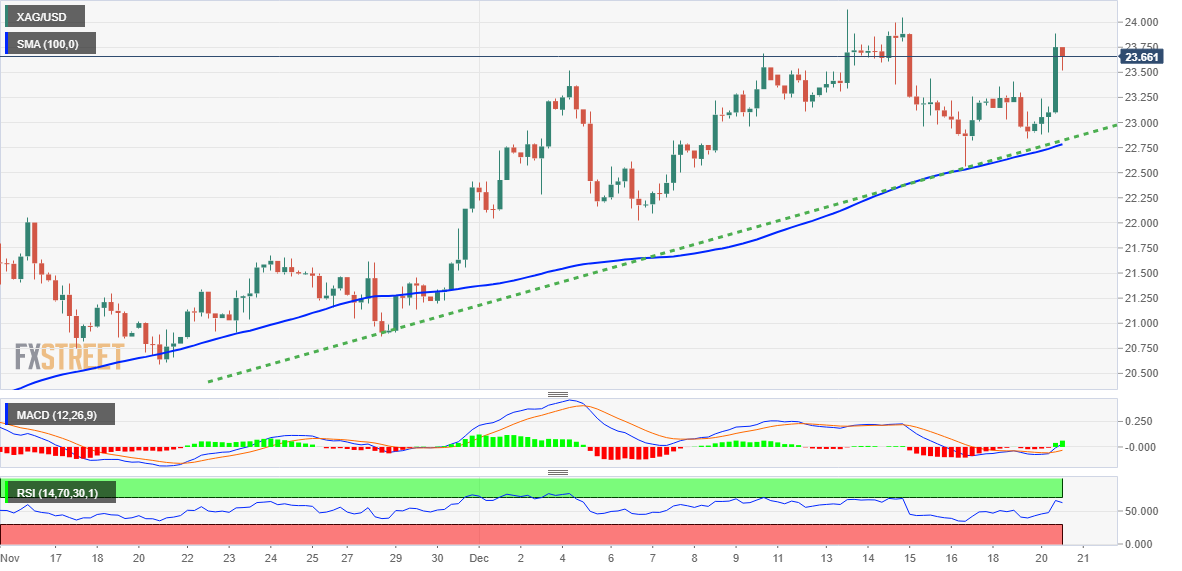
Key levels to watch
-
13:25
EUR/USD: Gains through 1.0655/60 will add to upside momentum – Scotiabank
EUR/USD consolidates around 1.0600. The pair could extend its gains on a break past 1.0655/60 in the short run, economists at Scotiabankr report.
EUR’s recent rally is due a pause or correction lower
“We still rather think the EUR’s recent rally is due a pause or correction lower but intraday price action looks modestly constructive and may develop a little more upside pressure in the short run.”
“EUR/USD losses have been well-supported on sub-1.06 dips; intraday gains that extend through 1.0655/60 (minor bull trigger) will add to upside momentum for a retest of the low 1.07s.”
“Intraday support is 1.0575/80.”
-
13:06
GBP/USD: Sub-1.20 dips likely to remain well supported – Scotiabank
GBP/USD stays at around 1.2150. Economists at Scotiabank expect the pair to hold above the 1.20 level.
More sideways range trade in the near term
“Cable is holding in about the middle of the past week’s range between support at 1.2090/00 and resistance at 1.2240/50.”
“Trend signals are mixed and weak across the shorter-term studies, suggesting more sideways range trade in the near term.”
“Broader trends suggest some modest downside risk as spot corrects the sharp rise from the Sep low but sub-1.20 dips are likely to remain well supported.”
-
12:54
USD/CAD drops to three-day low, around 1.3600 mark ahead of Canadian/US data
- USD/CAD turns lower for the second straight day amid broad-based USD weakness.
- A combination of factors could offer some support to the pair and help limit losses.
- Growing recession fears act as a headwind for oil prices and undermine the Loonie.
- Hawkish Fed, rising US bond yields should revive the USD demand and lend support.
The USD/CAD pair continues with its struggle to find acceptance or build on the momentum beyond the 1.3700 mark and turns lower for the second successive day on Tuesday. The downward trajectory drags spot prices to a three-day low, around the 1.3600 round figure heading into the North American session and is sponsored by the heavily offered tone surrounding the US Dollar.
The Bank of Japan-inspired strong rally in the Japanese Yen is seen weighing on the greenback. Apart from this, a slight recovery in the risk sentiment - as depicted by a modest bounce around the US equity futures - exerts additional pressure on the safe-haven greenback and attracts fresh selling around the USD/CAD pair. That said, a combination of factors should help limit the downside for the buck and lend some support to the major, at least for the time being.
Investors remain concerned that a surge in new COVID-19 cases in China could delay a broader reopening of the economy and dent fuel demand. This, in turn, acts as a headwind for crude oil prices, which, in turn, is seen undermining the commodity-linked Loonie. Furthermore, growing recession fears might keep a lid on any optimism in the markets. This, along with the Fed's hawkish outlook, could revive the USD demand and attract some dip-buying around the USD/CAD pair.
Traders now look to Tuesday's economic docket, featuring the release of monthly Retail Sales figures from Canada and the US housing market data. The data might do little to provide any meaningful impetus, leaving the USD/CAD pair at the mercy of the USD demand. Apart from this, traders will take cues from oil price dynamics to grab short-term opportunities around the major.
Technical levels to watch
-
12:45
USD/CAD: Upbeat Canadian Retail Sales to lift the Loonie, but gains could be short-lived – Scotiabank
USD/CAD is little changed ahead of what should be positive Retail Sales data. However, gains following the figures could be short-lived, according to economists at Scotiabank.
Clear push under 1.3620 should see USD/CAD dip to the 1.3540 zone
“The advance estimate for Canadian Retail Sales suggests a solid 1.5% increase in the Nov month. Not that the CAD will likely react to positive economic news. Positive data should give the CAD a lift but gains may be minor and/or short-lived.”
“Technically, after repeated failures around 1.37, the USD edging below 1.3620 (the low point of the past week’s range and a double/triple top trigger) today should have produced more downside pressure on USD/CAD. That may still develop but the market seems reluctant to bring negative pressure to bear on the USD.”
“A clear push under 1.3620 should see USD/CAD dip to the 1.3540 zone in the next few days.”
-
12:19
Gold Price Forecast: XAU/USD bulls again turn to bullion after CPI numbers emerge – SocGen
Gold edged higher following Consumer Price Index (CPI) data and is now trading above the $1,800 level, economists at Société Générale report.
Gold rises after November CPI prints
“US inflation data for November were released at the very end of the week, with core CPI printing at 6.0% YoY compared to analysts’ forecast of 6.1%. This was particularly supportive for Gold since it was thought that it would further convince the Fed to slow the pace of tightening during its 13-14 December FOMC meeting.”
“Although lower inflation would typically be bearish for Gold, the bullion has been supported recently by the prospect of the Fed slowing interest rate increases. Because Gold is a non-interest generating asset, a lower peak interest rate is bullish for the bullion.”
“The US Dollar depreciated following the data release, which improved the affordability of the precious metal to foreign investors, further supporting Gold prices.
-
12:13
USD/JPY pauses BoJ-inspired slump to multi-month low, finds some support near 132.00
- USD/JPY comes under intense selling pressure in reaction to the BoJ’s hawkish twist on Tuesday.
- Recession fears continue to weigh on investors’ sentiment and further benefit the safe-haven JPY.
- The Fed’s hawkish outlook, rising US bond yields fails to impress USD bulls or lend any support.
The USD/JPY pair adds to its heavy intraday losses and plummets to over a four-month low, around the 132.00 mark during the mid-European session. The pair, however, manages to recover a few pips in the last hour and is currently trading around the 132.70-132.75 region.
The sharp fall for the USD/JPY pair comes after the Bank of Japan (BoJ) stunned markets by reviewing its yield curve control policy. In a surprise move, the Japanese central bank decided to widen the range for fluctuations in the 10-year government bond yield. This is seen as a precursor to the end of the BoJ's ultra-accommodative monetary policy and prompts aggressive buying around the Japanese Yen.
Moreover, the cautious mood - amid growing recession fears - benefits the safe-haven JPY and exerts additional downward pressure on the USD/JPY pair. Investors remain concerned that a surge in COVID-19 cases in China could delay a broader reopening of the economy. Adding to this, geopolitical risks fuel worries about a deeper global economic downturn and take its toll on the risk sentiment.
The US Dollar, on the other hand, struggles to attract buyers despite a more hawkish commentary by the Fed last week. It is worth recalling that the US central bank indicated that it will continue to raise interest rates to crush inflation and projected an additional 75 bps lift-off by the end of 2023. This triggers a fresh leg up in the US Treasury bond yields, though fails to impress the USD bulls.
The intraday slump, meanwhile, confirms a fresh breakdown below a technically significant 200-day SMA and supports prospects for an extension of the depreciating move. That said, the oversold RSI (14) on hourly charts hold back traders from placing fresh bearish bets. This, in turn, assists the USD/JPY pair to find some support near the 132.00 mark, though any meaningful bounce seems elusive.
Market participants now look forward to the release of the US housing market data - Building Permits and Housing Starts. The data might do little to influence the USD or provide any impetus to the USD/JPY pair. Nevertheless, the aforementioned factors suggest that the path of least resistance for spot prices is to the downside and attempted recovery is more likely to get sold into.
Technical levels to watch
-
12:11
Bank of Spain trims 2023 growth projection to 1.3% from 1.4%
In its quarterly macroeconomic projections, the Bank of Spain revised the 2023 growth forecast to 1.3% from 1.4% previously. The bank sees Gross Domestic Product (GDP) growth of 2.7% in 2024 and 2.1% in 2025.
In the fourth quarter of the year, the bank expects the economy to expand only by 0.1%. "Weak consumption is one of the main factors behind the modest GDP growth forecast for the fourth quarter," the bank explained in its publication.
Finally, the bank forecasts the annual HICP inflation to decline to 4.9% in 2023 and 3.9% in 2024 from 8.4% in 2022.
Market reaction
The EUR/USD pair showed no immediate reaction to this publication and was last seen rising 0.25% on the day at 1.0633.
-
12:00
Mexico Retail Sales (YoY) came in at 3.8%, below expectations (4%) in October
-
12:00
Mexico Retail Sales (MoM) registered at 0.7% above expectations (-0.7%) in October
-
11:59
USD/JPY seen at 125 by end-2023 as the uptrend has come to an end – ABN Amro
Bank of Japan (BoJ) surprised the market by raising the upper band on its yield curve control (YCC) policy. The move triggered the Yen to rally by more than 3% versus the USD and the Euro. Economists at ABN Amro expect a further comeback of the JPY.
BoJ tweaks YCC
“The BoJ surprised friend and foe by shifting its YCC framework much earlier than expected. While leaving its policy balance rate and 10-yr yield target unchanged for now (at -0.1% and 0.0%, respectively), the BoJ announced to widen the trading band on 10-year bond yields and raise the upper limit of the band to around 0.50%, from 0.25%.”
“The uptrend of the US Dollar versus the Yen has now also come to an end, with the breaking of the 200-Day Moving Average in USD/JPY.”
“We expect more upside in the Yen versus the USD, mainly because of the rate cuts by the Fed we foresee to start end of 2023.”
“Our end-of-year forecasts for USD/JPY currently stand at 132 for 2023 and 125 for 2024.”
-
11:24
EUR/GBP may move to the upper half of the 0.87-0.88 band – ING
EUR/GBP is back at Monday’s close. Economists at ING expect the pair to move to the upper half of the 0.87-0.88 band.
No domestic drivers
“There is nothing to highlight in the UK calendar today, and the Pound should continue to be driven by Dollar dynamics.”
“EUR/GBP initially had a positive reaction to the BoJ announcement, likely due to GBP’s higher sensitivity to the adverse response in global equities, but is now back at yesterday’s close.”
“Still, GBP downside risks should be larger than for the Euro if risk sentiment remains pressured today, and EUR/GBP may move to the upper half of the 0.87-0.88 band.”
-
11:17
Portugal Current Account Balance up to €-2.871B in October from previous €-3.597B
-
11:06
USD/JPY: Defending 130.40 is essential to avert a revisit of 2015 levels near 125.85/124.00 – SocGen
USD/JPY has slumped to its weakest level in four months below 133.00. Holding above 130.40 is critical to avoid a deeper fall, economists at Société Générale report.
Signals of a meaningful rebound are not yet visible
“Daily MACD is in deep negative territory, however, signals of a meaningful rebound are not yet visible.”
“A revisit of August trough near 130.40 is not ruled out. Defending this would be essential to avert a revisit of 2015 levels near 125.85/124.00.”
“The MA at 135.60 is near term hurdle.”
-
10:55
EUR/USD could test 1.0700 before Christmas – ING
EUR/USD is holding marginally above 1.0600. The pair could test 1.07 in the coming days, economists at ING report.
Sidelined, for now
“It’s likely that the downward pressure on the Dollar from the BoJ's hawkish shift has been fully offset by the deterioration in risk sentiment, which negatively impacts the pro-cyclical Euro.”
“There are lingering downside risks to the Dollar and we could see EUR/USD test 1.0700 before Christmas. Anyway, volatility should become significantly thinner from Wednesday/Thursday, with today’s BoJ announcement having been the last major event in markets.”
-
10:36
BoJ’s surprise makes more difficult to assess what monetary policy will be like under new chief – Commerzbank
The Yen made a massive jump as the Bank of Japan (BoJ) is moving after all. Economists at Commerzbank believe that now it will more difficult to assess what monetary policy will be like under the new BoJ chief.
A first admission to the upward pressure on yields
“BoJ extended the target for the 10-year yield from -0.25 to +0.25% to -0.50 to +0.50%. However, it immediately limits this step again.”
“I am still a bit split on how to assess today's action. It makes sense to allow a wider target range of yields, which are pushing higher, when yields are rising globally. But to simultaneously increase buying volume to better defend the new target again dilutes this decision.”
“Perhaps this is a first admission to the upward pressure on yields and at the same time paves the way for Haruhiko Kuroda's successor, who will take office in the spring. At least we now know that the BoJ can also move. This will probably make it all the more difficult to assess what monetary policy will be like under the new BoJ chief.”
-
10:30
Gold Price Forecast: XAU/USD eyes $1,810-12 hurdle amid weaker US Dollar, recession fears
- Gold price catches fresh bids on Tuesday and draws support from a combination of factors.
- Recession fears act as a tailwind for the safe-haven metal amid broad-based USD weakness.
- The upside seems limited amid the prospects for further tightening by major central banks.
Gold price regains positive traction on Tuesday and steadily climbs back above the $1,800 mark during the first half of the European session. The XAU/USD is currently placed above a technically significant 200-day Simple Moving Average (SMA) and is supported by a combination of factors.
Recession fears underpin safe-haven Gold price
Despite the easing of strict COVID-19 restrictions in China, investors remain worried that a surge in new infections in the country could delay a broader reopening of the economy. Adding to this, the protracted Russia-Ukraine war has been fueling concerns about a deeper global economic downturn and weighing on investors' sentiment. This is evident from the prevalent cautious market mood, which, in turn, is driving some flows towards the safe-haven Gold price.
Weaker US Dollar further benefits Gold price
Apart from this, a weaker US Dollar provides an additional boost to the US Dollar-denominated Gold price. The sharp intraday fall in the buck could be solely attributed to the Bank of Japan (BoJ)-inspired strong buying around the Japanese Yen. Apart from this, the USD downfall lacks any obvious fundamental catalyst and is more likely to remain limited, at least for the time being, amid a more hawkish commentary by the Federal Reserve (Fed) last week.
Hawkish central banks could cap Gold price
In fact, the US central bank signalled that it will continue to raise rates to crush inflation. Adding to this, policymakers projected at least an additional 75 bps increases in borrowing costs by the end of 2023. This, in turn, triggers a fresh leg up in the US Treasury bond yields and favours the USD bulls. This, along with the prospects for further tightening by other major central banks, could also contribute to capping gains for the non-yielding Gold price.
The European Central Bank (ECB) last week stressed that significant tightening remained ahead and pledged that rates will be increased again, potentially as many as three times, by the same amount to tame runaway inflation. The Bank of England (BoE) lifted the benchmark rate to its highest level since 2008 and indicated that more hikes were likely. Furthermore, the Swiss National Bank (SNB) Chairman Thomas Jordan said that further tightening was necessary to crush inflation.
Bulls need to wait for move beyond $1,810-$1,812 supply zone
The aforementioned fundamental backdrop makes it prudent to wait for a sustained strength back above the $1,810-$1,812 supply zone before placing fresh bullish bets around Gold price. Nevertheless, the XAU/USD, for now, seems to have found acceptance above the $1,800 mark and remains at the mercy of the USD price dynamics.
Gold price technical outlook
From a technical perspective, some follow-through buying beyond the aforementioned barrier should lift Gold price to a multi-month top, around the $1,824-$1,825 region touched earlier this month. The momentum could get extended further towards the $1,854-$1,855 hurdle en route to the next relevant resistance near the $1,886-$1,887 zone.
On the flip side, dips below the $1,800 mark could attract some buyers near the very important 200-day Simple Moving Average (SMA), currently around the $1,788 area. This is followed by support near the $1,774-$1,773 region, which if broken decisively will negate any positive bias and prompt some technical selling. Gold price might then accelerate the fall toward the $1,766 intermediate support before eventually dropping to the $1,760 level.
Key levels to watch
-
10:01
FX option expiries for Dec 20 NY cut
FX option expiries for Dec 20 NY cut at 10:00 Eastern Time, via DTCC, can be found below.
- EUR/USD: EUR amounts
- 1.0700 806m
- USD/JPY: USD amounts
- 135.50 312m
- 136.32 572m
- AUD/USD: AUD amounts
- 0.6535 374m
- 0.6725 387m
- NZD/USD: NZD amounts
- 0.6180 615m
-
10:00
Belgium Consumer Confidence Index climbed from previous -22 to -15 in December
-
09:57
USD Index: Price objective should be somewhere closer to 95-96 levels in the medium term – OCBC
On the US Dollar Index (DXY) weekly chart, bearish momentum remains intact. Thus, economists at OCBC Bank expect DXY to plunge toward 95.96 over the next months.
Near term upside risk
“Near term, daily momentum is showing signs of mild bullish bias while RSI rose. Price action also resembles a falling wedge pattern – typically associated with a bullish reversal. We do not rule out the risk of rebound in the near term.”
“Resistance at 105.30 (21 DMA), 105.90 (200 DMA) and 107.”
“Price action on weekly chart exhibited a head & shoulders (H&S) pattern with neckline around 104.10. Further downside puts next support at 102.15 (50% fibo retracement of 2021 low to 2022 high).”
“Assuming what we are seeing is an eventual playout of a head & shoulders beyond the near term, then the textbook price objective of the breakdown should be somewhere closer to 95-96 levels (medium term).”
-
09:25
ECB's Kazimir: Monetary policy should tighten at a stable pace
European Central Bank (ECB) policymaker Peter Kazimir said on Tuesday that the “monetary policy should tighten at a stable pace.”
On Monday, Kazimir noted that “strong action will be necessary in the first half of 2023.”
Also read: The European economy is likely to avoid a hard landing
Market reaction
The Euro cheers the hawkish commentary from the ECB policymakers, extending gains at around 1.0630, at the time of writing. The pair is up 0.26% on the day.
-
09:22
The JPY has a lot more room to run – TDS
In a surprise move, the Bank of Japan widened its 10y JGB Yield Curve Control (YCC) Band to +/- 0.5% from +/- 0.25% previously. Markets reacted sharply, with JPY strengthening. Economists at TD Securities believe that USD/JPY downside will persist.
More JPY upside
“BoJ widens its YCC band to +/- 0.5% in a surprise move. While a shift in the YCC band was the most plausible option in our view, the widening was bigger and earlier than anticipated, with no prior signalling. We maintain the view that a more extensive policy shift in terms of policy balance rate and 10y JGB target will take place once there is a new BoJ Governor in place. We do not rule out further band widening, however.”
“Despite the sharp knee-jerk move higher in the JPY, we think it will extend further in the coming days given how soon this shift has occurred.”
“We also see a return to FX value as a key driver for the currency space amid peak USD. On that basis, the JPY has a lot more room to run.”
“Major support levels for USD/JPY comes in the 130/132 area before reassessing the extension. Meanwhile, we see more extension to 90/95 in CAD/JPY and 135 in EUR/JPY though the latter will be less linear given the ECB's hawkishness.”
-
09:20
GBP/USD struggles to capitalize on its modest bounce from over two-week low
- GBP/USD reverses an intraday dip to sub-1.2100 levels, or over a two-week low.
- The BoJ-inspired rally in the JPY weighs on the USD, which, in turn, lends support.
- Hawkish Fed, rising US bond yields and recession fears should limit the USD losses.
The GBP/USD pair attracts fresh buying near the very important 200-day SMA and rebounds nearly 100 pips from a two-and-half-week low touched earlier this Tuesday. The momentum is supported by the heavy US Dollar selling and lifts spot prices closer to the 1.2200 mark during the first half of the European session, though lacks bullish conviction.
An unexpected hawkish twist by the Bank of Japan triggers a massive rally in the Japanese Yen, which, in turn, weighs on the greenback. Apart from this, an intraday recovery in the risk sentiment is seen as another factor undermining the safe-haven buck and acting as a tailwind for the GBP/USD pair. That said, any meaningful upside still seems elusive, warranting some caution for aggressive bullish traders and positioning for a further intraday appreciating move.
Worries that a surge in new COVID-19 infections in China could delay a broader reopening in the country overshadows the recent easing of strict lockdown measures. This, along with the protracted Russia-Ukraine war, has been fueling fears about a deeper global economic downturn, which should keep a lid on any optimistic move in the markets. Moreover, a more hawkish commentary by the Federal Reserve supports prospects for the emergence of some dip-buying around the USD.
It is worth recalling that the US central bank indicated that it will continue to raise rates to crush inflation. Furthermore, policymakers projected at least an additional 75 bps increases in borrowing costs by the end of 2023. This, in turn, leads to a fresh leg up in the US Treasury bond yields and favours the USD bulls. Apart from this, a dovish outcome from the Bank of England meeting last week might contribute to capping the upside for the GBP/USD pair.
In fact, two out of nine BoE MPC members voted to keep interest rates unchanged, suggesting that the central bank is closer to ending the current policy tightening cycle. Hence, any further recovery might still be seen as a selling opportunity and runs the risk of fizzling out rather quickly. Bearish traders, however, might wait for a sustained break below a technically significant 200-day SMA support before placing fresh bets and positioning for deeper losses.
Technical levels to watch
-
09:18
ECB’s Villeroy: The European economy is likely to avoid a hard landing
European Central Bank (ECB) Governing Council member and French central bank governor Francois Villeroy de Galhau made some comments on the economic outlook on Tuesday.
Key quotes
“The European economy is likely to avoid a hard landing.”
“France probably will escape a recession.”
Market reaction
Amidst broad US Dollar sell-off and encouraging ECB-speak, EUR/USD is holding its recovery gains at around 1.0625, at the time of writing. The spot is up 0.20% on the day.
-
09:02
Japan’s Suzuki: No comment on market reaction to BoJ decision
Japanese Finance Minister Shunichi Suzuki declined to comment on the market reaction, in response to the Bank of Japan’s (BoJ) policy decision.
Additional comments
“Monetary policy is up to BoJ to decide.“
“BoJ decision aimed at improving corporate finance while maintaining accommodative monetary conditions.”
Market reaction
USD/JPY remains heavily sold-off into the hawkish BoJ policy shift, which sent markets into a tailspin. The pair is down 3.40% on the day at 132.25, at the press time.
-
09:01
European Monetary Union Current Account s.a above forecasts (€-11.6B) in October: Actual (€-0.4B)
-
09:01
European Monetary Union Current Account n.s.a came in at €-4.4B, above forecasts (€-13.8B) in October
-
08:57
It might get more difficult for the Dollar over the coming weeks – Commerzbank
The US Dollar was unable to benefit from the Fed meeting. Economists at Commerzbank expect the greenback to struggle in the next few weeks.
Some US economic data is now deteriorating
“The first comments from FOMC members following last week’s Fed meeting were more on the hawkish side. After all the dots were moved upwards and signal that Fed Funds will peak above 5%. That means further restrictive comments over the coming days should not come as a surprise, nor should they prompt anyone to buy the Dollar.”
“Some US economic data is now deteriorating too, such as the PMI. That is more likely to fuel scepticism that the Fed might be overdoing its restrictive approach and will therefore have to lower the key rate that much more again next year – which would be detrimental to the Dollar.”
“Shortly before Christmas liquidity on the market is getting increasingly thin, but regardless of this fact I fear that every time weak US data is published USD will be under close scrutiny in future. That means things might get more difficult for the greenback over the coming weeks.”
-
08:43
EUR/USD struggles for a firm intraday direction, consolidates around 1.0600 mark
- EUR/USD oscillates in a familiar trading range around the 1.0600 mark on Tuesday.
- The BoJ-inspired rally in the JPY weighs on the USD and lends support to the major.
- Hawkish Fed, rising US bond yields and the risk-off mood limits losses for the buck.
The EUR/USD pair struggles to gain any meaningful traction and seesaws between tepid gains/minor losses through the early European session on Tuesday. Spot prices, however, show resilience below the 1.0600 mark and remain at the mercy of the US Dollar price dynamics.
The Bank of Japan-inspired rally in the Japanese Yen is seen weighing on the USD, which, in turn, is seen lending some support to the EUR/USD pair. That said, a combination of factors continues to act as a tailwind for the greenback and keeps a lid on any meaningful upside for the major, at least for the time being.
Investors seem worried that a surge in COVID-19 cases in China could delay a broader reopening. This, in turn, overshadows the optimism over the easing of lockdown measures and takes its toll on the global risk sentiment. This is evident from a weaker tone around the equity markets and should benefit the safe-haven buck.
Apart from this, a more hawkish outlook by the Federal Reserve last week supports prospects for the emergence of some USD dip-buying. In fact, the US central bank indicated that it will continue to raise rates to tame inflation and projected at least an additional 75 bps increase in borrowing costs by the end of 2023.
This, in turn, pushes the US Treasury bond yields higher and reaffirms the near-term positive outlook for the greenback. That said, hawkish signals from the European Central Bank (ECB), signalling that it will need to raise interest rates significantly further to crush inflation, warrant caution for bearish traders.
In the absence of any major market-moving economic releases from the Eurozone, the mixed fundamental backdrop warrants some caution before placing aggressive directional bets. The US economic docket, meanwhile, features housing market data - Building Permits and Housing Starts - later during the early North American session.
This, along with the US bond yields and the broader risk sentiment, will drive the USD demand and provide some impetus to the EUR/USD pair. The focus, however, will remain on the final US Q3 GDP print on Thursday, followed by the release of the Core PCE Price Index - the Fed's preferred inflation gauge - on Friday.
Technical levels to watch
-
08:31
Hong Kong SAR Consumer Price Index below forecasts (3%) in November: Actual (1.8%)
-
08:12
GBP/USD: Clean break below 21DMA could open room for further downside – OCBC
GBP/USD stays relatively quiet at around 1.2150. A break below here could open room for further losses, economists at OCBC Bank report
Risks still skewed to the downside in the near term
“Daily momentum is mild bearish while RSI is flat.”
“Bearish divergence on MACD and rising wedge pattern (bearish reversal) continue to caution for pullback play lower in the near term.”
“Risks still skewed to the downside in the near term.”
“Support here at 1.2150 (21 DMA), 1.21 (200 DMA), 1.2050 (50% fibo).” “Resistance at 1.2450 (61.8% fibo retracement of 2022 high to low).”
-
07:59
EUR/USD: Resistance seen at 1.0690, support aligns at 1.0520 – OCBC
EUR/USD fluctuates in a tight range around 1.0600. Economists at OCBC Bank highlight the key technical levels to watch.
Rangebound trade still likely within trend channel
“Daily momentum is showing a mild bearish bias while RSI is flat.”
“Rangebound trade still likely within trend channel.”
“Resistance at 1.0690 (trend upper bound), 1.0750 levels (61.8% fibo retracement of 2022 high to low).”
“Support at 1.0520 (50% fibo), 1.0480 (21DMA) and 1.0340 (200DMA).”
See: EUR/USD has weakened every year in January, February and March since 2019 – SocGen
-
07:56
AUD/USD hangs near one-month low, bears flirt with 100-day SMA around mid-0.6600s
- AUD/USD drops to a nearly one-month low and is pressured by a combination of factors.
- The dovish RBA minutes, along with the risk-off mood, weigh on the risk-sensitive Aussie.
- A weaker USD lends support, though the bias now seems tilted in favour of bearish traders.
The AUD/USD pair comes under heavy selling following an early uptick to the 0.6745 area and dives to a nearly one-month low on Tuesday. Spot prices, however, manage to rebound a few pips and hold steady around mid-0.6600s during the early European session.
The Australian Dollar started losing ground after the Reserve Bank of Australia (RBA) minutes showed that policymakers considered leaving interest rates unchanged at the December meeting. Apart from this, the Bank of Japan-inspired slump in the AUD/JPY cross, along with an extended sell-off in the equity markets, contribute to driving flows away from the risk-sensitive Aussie. That said, a weaker US Dollar helps limit the downside for the AUD/USD pair, at least for the time being.
The intraday USD downtick, meanwhile, could be attributed to aggressive buying around the Japanese Yen, though a combination of factors should help limit the downside. Worries that a surge in COVID-19 cases in China could delay a broader reopening in the country overshadows the optimism over the easing of strict lockdown measures. This, along with a more hawkish commentary by the Fed, should offer support to the safe-haven buck and cap any attempted recovery for the AUD/USD pair.
It is worth recalling that the US central bank indicated that it will continue to raise rates to crush inflation. Furthermore, policymakers projected at least an additional 75 bps increases in borrowing costs by the end of 2023. This, in turn, pushes the US Treasury bond yields and favours the USD bulls, suggesting that the path of least resistance for the AUD/USD pair is to the downside. Moreover, a break below the 100-day SMA support adds credence to the negative outlook for spot prices.
Moving ahead, there isn't any major market-moving economic data due for release from the US on Tuesday. Hence, the US bond yields, along with the broader risk sentiment, will play a key role in influencing the USD price dynamics and provide some impetus to the AUD/USD pair. Apart from this, the COVID-19 situation in China should allow traders to grab short-term opportunities.
Technical levels to watch
-
07:47
Hungary’s rate decision unlikely to have much effect on Forint – Commerzbank
The National Bank of Hungary is expected to maintain policy rates unchanged. The decision is unlikely to affect the Forint, in the view of economists at Commerzbank.
MNB’s rate decision a non-event
“A rise in the Hungarian inflation rate to 22.5% in November is no doubt unfortunate – this is the highest level since 1996. But the Hungarian central bank (MNB) will nonetheless keep its key rate unchanged at 13% today, which consensus is also expecting.”
“Initially inflation in December is likely to rise further after the fuel price cap was abolished. As a result, HUF might get a battering in mid-January when the December inflation data is published. Today’s rate decision is likely to be a non-event for the market though, thus not having much effect on the exchange rates.”
-
07:31
The JPY is set to strengthen during 2023 – HSBC
The Japanese Yen is set to strengthen during 2023, in the view of economists at HSBC.
If the BoJ tweaks its monetary policy, the JPY may strengthen further
“We believe the upward pressure on USD/JPY exerted by its yield differentials should cease when the Fed stops hiking.”
“If the Bank of Japan tweaks its monetary policy (not our economists’ base case), the USD/JPY pair may fall even harder.”
“A normalisation of extremes in valuation and improving Japan’s current account should also support the Japanese Yen.”
-
07:27
Forex Today: BOJ policy tweak weighs on risk trade
Here is what you need to know on Tuesday, December 20:
Global equity indexes are suffering heavy losses on Tuesday in reaction to the Bank of Japan's (BOJ) unexpected policy tweak. The 10-year US Treasury bond yield rises toward 3.7% and US stock index futures are down between 0.6% and 1%. The US economic docket will feature Building Permits and Housing Starts for November. The European Commission will release the preliminary December Consumer Confidence report later in the day. Investors will keep a close eye on risk perception in the absence of high-impact macroeconomic data releases.
Following the December policy meeting, the BOJ left its policy rate unchanged at -0.1% and maintained the 10-year Japanese Government Bond (JGB) yield at 0.00% as expected. The BOJ, however, announced that they will allow the 10-year JGB yield to fluctuate between -0.5% and 0.5%, compared to -0.25% and 0.25% previously, and noted that they will review the yield curve control operation. Although this development by itself was not a big change in the BOJ's policy stance, the impact on the Japanese Yen was significant with investors possibly pricing in a hawkish policy step in the near future.
Risk appetite worsens on BOJ YCC move, Yen gains.
While speaking at the post-meeting press conference, BOJ Governor Haruhiko Kuroda reiterated that they will not hesitate to ease the policy further if necessary and noted that it was too early to debate an exit from the current monetary policy. "Today's decision on yield curve control is not an exit of yield curve control or change in policy," Kuroda explained and added that the decision was made on concerns of deteriorating market function threatening corporate financing.
BoJ’s Kuroda: Necessary to achieve 2% inflation target sustainably, stably in tandem with wage growth.
With the initial reaction to the BOJ's policy announcements, USD/JPY lost more than 500 pips from its daily high and slumped to its weakest level in four months below 133.00. BOJ Governor Kuroda's comments failed to help the pair stage a rebound. Similarly, EUR/JPY is down nearly 3% on the day, trading near 141.00 in the European morning.
EUR/USD fluctuated in a tight range during the Asian trading hours on was last seen trading at around 1.0600.
GBP/USD closed virtually unchanged on Monday and extended its sideways grind early Tuesday. At the time of press, the pair was staying relatively quiet at around 1.2150.
Gold price managed to edge higher and reclaimed $1,790 early Tuesday despite rising US Treasury bond yields.
Following Monday's decline, Bitcoin regained its traction and was last seen gaining more than 2% on the day at around $16,800. Ethereum gathered bullish momentum and rose above $1,200, rising more than 3% on a daily basis.
-
07:07
USD/JPY: Yen renews four-month low as Bank of Japan surprises markets
- USD/JPY drops more than 3.0% to refresh multi-day bottom after Bank of Japan tweaks Yield Curve Control (YCC) policy.
- Chatters surrounding Japan’s budget, Treasury bond buying also entertain Yen traders.
- BOJ Governor Kuroda shows readiness to ease policy if needed, USD/JPY stays pressured.
- Risk aversion fails to underpin US Dollar as Federal Reserve appears less hawkish.
USD/JPY bears the burden of the Bank of Japan’s (BOJ) surprise policy tweak during early Tuesday, despite the latest rebound. While portraying the Yen trader’s mood, the quote initially slumped to the lowest levels since early August before the recent bounce from 132.66 to 133.60. Even so, the quote remains 2.75% in the red as we write.
Bank of Japan surprises markets with YCC move, drowns USD/JPY
Bank of Japan (BOJ) held its benchmark rate unchanged at -0.10% and kept the short-term interest rate target at -0.1% while directing 10-year Japanese Government Bond (JGB) yields toward zero. In doing so, the Japanese central bank matched the market expectations and should have kept the USD/JPY intact.
The surprise factor, however, was the BOJ’s alteration of the Yield Curve Control (YCC) and the bond issuance announcements. “The BOJ will expand the range of 10-year Japan government bond yield fluctuations from its current plus and minus 0.25 percentage points to plus and minus 0.5 percentage points,” reported Reuters. Following that, the Yen pair plunged to the multi-day low of 132.66 ahead of bouncing back beyond 133.00.
The BOJ not only affected the USD/JPY prices but also roiled the risk appetite and propelled the Treasury bond yields across the board, which in turn allowed the US Dollar to pare intraday losses.
BOJ Governor Haruhiko Kuroda defends Yen buyers
Having witnessed the BOJ-inflicted slump in the USD/JPY prices, Governor Haruhiko Kuroda allowed the Yen traders to lick their wounds while defending the easy money policies for one last time.
In doing so, BOJ’s Kuroda highlights the need for a 2.0% inflation target, as well as shows readiness to ease monetary policy if needed.
“Today's decision on yield curve control is not an exit of yield curve control or change in policy,” said BOJ’s Kuroda per Reuters.
Also read: BoJ’s Kuroda: Necessary to achieve 2% inflation target sustainably, stably in tandem with wage growth
US Dollar fails to cheer risk-off mood
Despite the risk-aversion wave, the US Dollar Index (DXY) remains mildly offered near 104.40, down for the second consecutive day. The reason for the USD/JPY pair’s weakness could be linked to the Federal Reserve’s (Fed) less hawkish bias, as informed via the latest monetary policy meetings, as well as the softer US Purchasing Managers’ Indexes (PMIs) for December. Also likely to have weighed on the US Dollar are the strongly hawkish statements from the European Central Bank (ECB) officials, as well as upbeat German data.
Risk catalysts will be crucial for Yen sellers
Looking forward, USD/JPY pair bears need to pay close attention to the risk catalysts and the bond market moves for near-term directions amid a light calendar. Also important will be the US Building Permits and Housing Starts could join Germany’s Producers Price Index (PPI) data to direct immediate moves. However, major attention will be given to the Fed’s preferred inflation gauge, namely Friday’s US Core Personal Consumption Expenditure (PCE) – Price Index for December, expected 4.6% YoY versus 5.0% prior.
USD/JPY technical analysis
USD/JPY extends a downside break of the 200-DMA, as well as an upward-sloping trend line from early August, towards refreshing the multi-day low.
Given the impending bear cross on the Moving Average Convergence and Divergence (MACD) indicator, as well as the downbeat Relative Strength Index (RSI), located at 14, not oversold, the USD/JPY pair is likely to extend the latest weakness.
However, the RSI (14) is near the oversold territory and hence signals limited downside room, which in turn highlights the 78.6% Fibonacci retracement level of the May-October upside, near 131.70.
Also acting as the downside filter is the August month low near 130.40 and the 130.00 round figure.
In a case where the USD/JPY rebounds from the current level, the support-turned-resistance line from August, around 134.15 by the press time, could challenge intraday bulls.
Following that, the 200-DMA hurdle surrounding 135.75 will be crucial to watch for the Yen buyers.
Above all, a two-week-old horizontal resistance area near 138.00 could restrict the USD/JPY buyers from entering the ring.
USD/JPY: Daily chart
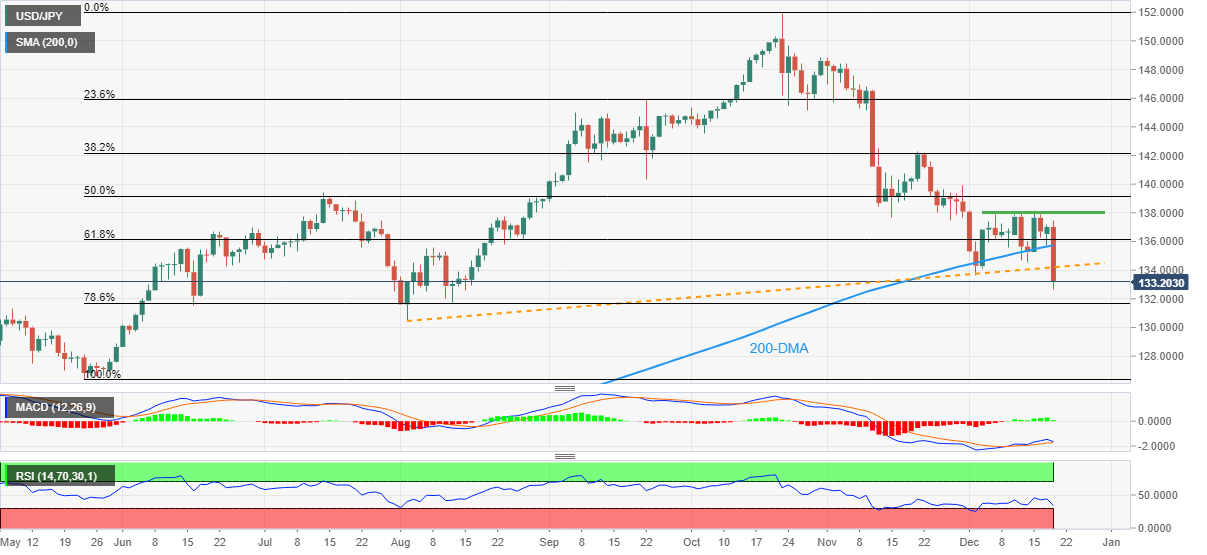
Trend: Limited downside expected
-
07:03
Switzerland Imports (MoM) climbed from previous 19989M to 21916M in November
-
07:03
Switzerland Exports (MoM) climbed from previous 24129M to 24223M in November
-
07:01
GBP/JPY bounces off two-month low, back above 162.00 as BoJ Kuroda's presser gets underway
- GBP/JPY plummets to over a two-month low in reaction to the BoJ’s hawkish twist on Tuesday.
- A dovish outlook, however, caps gains for the JPY and assists spot prices to recover a few pips.
- The fundamental backdrop favours bearish traders and supports prospects for further losses.
The GBP/JPY cross comes under intense selling pressure on Tuesday and plunges to its lowest level since October 12 in reaction to the Bank of Japan's hawkish twist. Spot prices, however, manage to recover around 150 pips and jumps back above the 162.00 mark during the early European session.
The Japanese Yen rallies across the board after the Japanese central bank announced its monetary policy decision, which, in turn, prompts aggressive selling around the GBP/JPY cross. In an unexpected move, the BoJ widened the allowable trading band for the 10-year government bond yield to 50 bps on either side of the 0% target from the 25 bps previous. This is seen as a step towards the policy normalisation process, which, in turn, provides a strong boost to the JPY.
The BoJ, however, sticks to its dovish guidance and pledges to ramp up monetary stimulus as needed. The central bank also projects that interest rates will move at current or lower levels. In the post-meeting press conference, BoJ Governor Haruhiko Kuroda said that Japan's economy still faces a lot of uncertainty and sees inflation growth fading in 2H 2023. This caps the upside for the JPY and assists the GBP/JPY cross to attract some buyers near the 160.80-160.75 area.
Any meaningful recovery, however, still seems elusive, warranting some caution for bullish traders. The prevalent risk-off mood, amid growing recession fears, should continue to benefit the JPY's relative safe-haven status. Apart from this, a dovish outcome from the Bank of England meeting last week, with two MPC members voting to keep interest rates unchanged, might undermine the GBP. This, in turn, acts as a headwind for the GBP/JPY cross and keep a lid on the intraday uptick.
Even from a technical perspective, a convincing break below the very important 100 and 200-day SMAs favours bearish traders and supports prospects for the emergence of fresh sellers at higher levels. Hence, any subsequent move up could be seen as a selling opportunity and runs the risk of fizzling out quickly in the absence of relevant economic data from the UK.
Technical levels to watch
-
07:01
Germany Producer Price Index (YoY) came in at 28.2% below forecasts (30%) in November
-
07:00
Turkey Consumer Confidence: 75.6 (December) vs previous 76.6
-
07:00
Germany Producer Price Index (MoM) below expectations (-2.6%) in November: Actual (-3.9%)
-
07:00
Switzerland Trade Balance below expectations (3800M) in November: Actual (2307M)
-
07:00
Denmark Consumer Confidence up to -28.9 in December from previous -30.4
-
06:58
Gold Price Forecast: XAU/USD needs to recapture $1,800 to extend the renewed upside
Gold price finds fresh buyers after having defended the critical 200-Daily Moving Average (DMA) support at $1,785. The yellow metal eyes $1,800 following the latest uptick, FXStreet’s Dhwani Mehta notes.
Selling pressure will intensify on a sustained move below 21DMA at $1,777
“Bulls now yearn for a sustained break above the $1,800 barrier, with the next resistance seen at December 15 highs of $1,809. Fresh buying opportunities will emerge above the latter, calling for a test of the December 14 high at $1,814.”
“On the flip side, a breach of the 200DMA on a daily closing basis will reopen floors toward the bullish 21DMA at $1,777. Selling pressure will likely intensify on a sustained move below the critical short-term line of defense of 21DMA, fuelling a fresh downswing toward the $1,750 psychological level.”
-
06:47
BoJ’s Kuroda: Necessary to achieve 2% inflation target sustainably, stably in tandem with wage growth
Bank of Japan (BOJ) is speaking at the post-policy meeting conference on Tuesday, commenting on inflation and wage growth outlook.
Key quotes
Sustainable, stable achievement of inflation target should be determined on not just wage figures but also on economic, price trends, underlying mechanism, future outlook.
Necessary to achieve 2% inflation target sustainably, stably in tandem with wage growth.
Today's decision on yield curve control is not an exit of yield curve control or change in policy.
Appropriate to continue easing policy.
Decision was made today as deteriorating market functions could threaten corporate financing.
Bond market volatility has recently been heightening again, distorting yield curve shapes.
Expects volatility in global financial markets to decrease gradually.
Cannot be optimistic amid uncertainties from Ukraine war, rate hikes in western economies, China’s shift of zero-covid policy.
Economic stimulus effect has been rising despite same nominal rates because inflation brings real rates down.
more to come ...
Related reads
- BOJ’s Kuroda: Won't hesitate to ease monetary policy further if necessary
- Risk appetite worsens on BOJ YCC move, Yen gains
-
06:37
BOJ’s Kuroda: Won't hesitate to ease monetary policy further if necessary
Bank of Japan (BOJ) is speaking at the post-policy meeting conference on Tuesday, reiterating that they “won't hesitate to ease monetary policy further if necessary.”
Additional quotes
Won't hesitate to ease monetary policy further if necessary.
Premature to debate specifics on BoJ’s monetary policy framework review.
Effects overwhelm negative side-effects.
Still takes time to achieve inflation target.
Too early to debate exit to current monetary policy.
If possibility of achieving 2% price target draws near, we can discuss timing of exit.
Today's decision is not a rate hike.
Market reaction
USD/JPY is off the multi-month lows of 132.38 on Kuroda’s comments. The pair is trading at 133.03, still down 2.81% so far.
-
06:25
Gold Price Forecast: XAU/USD struggles below $1,800 on firmer yields
- Gold price remains mildly bid despite the US Dollar’s latest rebound.
- BOJ-linked slump in equities, bonds underpin Gold’s safe-haven buying.
- Headlines surrounding China, global recession also probe XAU/USD bulls but light calendar, holiday mood stop seller’s entry.
Gold price (XAU/USD) clings to mild gains near $1,790 during early Tuesday morning in Europe, despite the US Dollar’s rebound from the intraday low. The reason could be linked to the market’s rush towards risk safety.
The Bank of Japan’s (BOJ) surprise action triggered the risk aversion wave for a few hours, which in turn propelled the bond yields and drowned the prices of commodities. However, the US Dollar Index failed to overcome the daily loss and challenged the Gold sellers afterward.
Recently, the BOJ tweaked its policy to widen the Yield Curve Control (YCC) measures while keeping the monetary policy unchanged.
Also underpinning the risk-off mood could be the economic fears surrounding China, as well as the globe. Behind the moves could be the World Bank’s cut in China’s economic forecasts as well as the hawkish actions of the major central banks to tame inflation, especially when the recession fears are already looming.
Against this backdrop, S&P 500 Futures and the Asia-Pacific stocks print losses while the US 10-year Treasury yields rise for the third consecutive day to refresh the monthly peak near 3.70%, at 3.67% by the press time.
Moving on, risk catalysts are the key for the Gold traders to watch amid a light calendar. Among them, central bank updates and headlines surrounding China and Russia will be crucial.
Technical analysis
A one-week-old descending resistance line, around $1,793 by the press time, restricts the short-term Gold upside amid gradually improving RSI (14) and firmer MACD signals.
As a result, the XAU/USD buyers are likely to portray another attempt in crossing the $1,793 hurdle, which in turn will highlight a downward-sloping resistance line from December 05, near $1,800 at the latest.
Following that, a run-up toward the monthly high near $1,824 can’t be ruled out.
Alternatively, pullback moves remain elusive unless the Gold stays beyond a two-week-old ascending support line, close to $1,776 by the press time.
Gold: Hourly chart
-20122022-638071143172721965.png)
Trend: Further upside expected
-
06:03
USD/CAD bulls attack 1.3700 as yields underpin US Dollar rebound, Oil drops
- USD/CAD picks up bids to reverse the week-start losses.
- US Dollar benefits from the BOJ-inflicted losses in bond, stock markets.
- Oil price weaken amid economic fears surrounding China.
- Canada Retail Sales, US housing data eyed for fresh impulse.
USD/CAD clings to mild gains around 1.3700 as the US Dollar reverses the intraday losses heading into Tuesday’s European session. The Loonie pair’s run-up could also be linked to the downside move of Canada’s main export item, namely WTI crude oil.
That said, the US Dollar Index (DXY) picks up bids to pare recent losses around 104.50 as the Treasury bond yields rally on the Bank of Japan’s (BOJ) surprise. Recently, the BOJ tweaked its policy to widen the Yield Curve Control (YCC) measures while keeping the monetary policy unchanged.
Also underpinning the US Dollar’s latest rebound could be the economic fears surrounding China, as well as the globe. Behind the moves could be the World Bank’s cut in China’s economic forecasts as well as the hawkish actions of the major central banks to tame inflation, especially when the recession fears are already looming.
However, comparatively less hawkish comments from the Fed officials join softer US PMIs to challenge DXY bulls.
Elsewhere, WTI takes offers to refresh intraday low near $75.50, down half a percent at the latest. The European leaders’ agreement on the oil price cap for Russian energy exports also seems to exert downside pressure on the black gold prices.
Amid these plays, S&P 500 Futures and the Asia-Pacific stocks print losses while the US 10-year Treasury yields rise for the third consecutive day to refresh the monthly peak near 3.70%, at 3.67% by the press time.
Looking forward, the risk-aversion wave may help USD/CAD buyers ahead of the Canadian Retail Sales for October, expected -0.3% versus 0.5% prior. On the other hand, US Building Permits and Housing Starts for November may also direct short-term pair moves.
Technical analysis
A daily closing beyond the 1.3700 hurdle, comprising multiple tops marked in the last two weeks, becomes necessary for the USD/CAD bulls to aim for the previous monthly high near 1.3810. Otherwise, a pullback towards the 50-DMA support of 1.3557 can’t be ruled out.
-
05:39
GBP/USD Price Analysis: Pierces through monthly key support with eyes on 200-SMA
- GBP/USD takes offers to refresh intraday low, pokes short-term key support line.
- Sustained trading below 100-SMA keeps sellers hopeful of visiting 200-SMA.
- Two-week-old horizontal area restricts immediate upside before the monthly high.
GBP/USD sellers attack monthly low as it drops to 1.2090 heading into Tuesday’s London open. That said, the quote prints four-day downtrend as it approaches the monthly bottom amid broad US Dollar rebound.
In doing so, the Cable pair traders attack a one-month-old ascending trend line, after multiple failures to cross the 100-SMA. Additionally favoring the pair sellers could be the bearish MACD signals.
As a result, the GBP/USD prices could drop to the 200-SMA level surrounding 1.1980. However, the 1.2000 psychological magnet and the late November swing lows near 1.1900 may restrict the quote’s south run.
In a case where the Cable pair remains bearish past 1.1900, the mid-November swing low near 1.1760 could gain the market’s attention.
Alternatively, the support-turned-resistance line near 1.2130 and the 100-SMA level surrounding 1.2200 could challenge GBP/USD bulls.
Following that, the 1.2300 round figure and a fortnight-old horizontal region near 1.2345 could challenge the pair’s further upside before directing buyers towards the monthly peak of 1.2445.
Overall, GBP/USD is likely to decline further but the 200-SMA and multiple lows marked during late November could restrict short-term downside.
GBP/USD: Four-hour chart

Trend: Further downside expected
-
05:31
Netherlands, The Consumer Spending Volume down to 0.6% in October from previous 2.2%
-
05:30
Netherlands, The Consumer Confidence Adj: -52 (December) vs -57
-
05:25
BoJ conducts unlimited bond buying for 1-to-5 year tenors
Following the surprise policy move by the Bank of Japan (BoJ) on Tuesday, the central bank conducted unlimited bond buying for one-to-five-year tenors.
Also read: BoJ stands pat on monetary policy, USD/JPY slumps
Key takeaways
"BoJ offers to buy JPY600 billion (bln) worth of Japanese Government Bonds (JGBs):
JPY100bln 1-3 year.
JPY100bln 3-5 year..
JPY300bln 5-10 year.
JPY100bln 10-25 year."
Market reaction
USD/JPY fails to find any support from the BoJ operations, as it sinks 2.57% on the day to trade at 133.35, as of writing.
-
05:14
Asian Stock Market: Bears cheer Bank of Japan moves to trace Wall Street's losses
- Asia-Pacific equities trace Wall Street’s losses as BOJ surprises markets.
- BOJ defends current monetary policy, alters YCC curve limits to entertain momentum traders.
- RBA Minutes, PBOC inaction gain less attention but keep policy hawks hopeful.
- Headlines surrounding China offer mixed signals but risk appetite remains weak amid recession fears.
Equities in the Asia-Pacific region copy Wall Street’s move, despite an upbeat start, as the Bank of Japan (BOJ) inflicted losses in the stocks and bond markets with its unexpected move during early Thursday. On the same line could be the Reserve Bank of Australia’s (RBA) readiness for further rate hikes, per the RBA Meeting Minutes, as well as the World Bank’s degrading of China’s growth forecasts.
Amid these plays, the MSCI’s index of the Asia-Pacific shares ex-Japan prints a four-day downtrend while Japan’s Nikkei 225 slumps 2.71% by the press time.
BOJ held its benchmark rate unchanged at -0.10% while keeping the short-term interest rate target at -0.1% while directing 10-year Japanese Government Bond (JGB) yields toward zero. In doing so, the Japanese central bank matched the market expectations. The surprise factor, however, was the BOJ’s alteration of the Yield Curve Control (YCC) and the bond issuance announcements. “The BOJ will expand the range of 10-year Japan government bond yield fluctuations from its current plus and minus 0.25 percentage points to plus and minus 0.5 percentage points,” reported Reuters.
Elsewhere, RBA Minutes suggested that Australia's central bank considered leaving interest rates unchanged at its December policy meeting, citing the lagged effects of the aggressive tightening delivered so far and the benefits of moving cautiously in an uncertain environment. The same failed to impress Australia’s ASX 200 and joined the broad risk-off mood to print 1.50% intraday loss at the latest.
On the other hand, Chinese markets remained dismal even as the People’s Bank of China (PBOC) kept the benchmark Loan Prime Rates (LPR) unchanged. The reason could be linked to the World Bank’s downbeat forecasts for the dragon nation, as well as the cautious mood ahead of a diplomatic meeting between Australia and China.
As BOJ was considered the last bear among the major central banks, the recent hawkish signals amplify the global recession woes and underpin the run-up in the key Treasury bond yields, which in turn weigh on the equities. However, the US Dollar struggles to cheer the same amid the Japanese Yen’s (JPY) haven status and recently downbeat concerns surrounding the US. It should be noted that prices of Oil dropped but those of Gold recover as of late.
Moving on, a speech from BOJ Governor Haruhiko Kuroda will precede the second-tier data from Germany and the US to entertain traders.
-
05:12
ECB’s Nagel: Central bank is a long way from inflation target
European Central Bank (ECB) policymaker and Germany’s central bank head Joachim Nagel said in an interview with Stern on Tuesday, the “central bank is still a long way from hitting its inflation goal.”
Nagel noted, “inflation is persistent and thus the European Central Bank must also be persistent on rates.”
Market reaction
EUR/USD is trading on the defensive at around 1.0600, as rallying US Treasury yields outweigh the US Dollar weakness.
-
04:53
USD/INR Price Analysis: Indian Rupee drops back to 82.80 support inside bearish wedge
- USD/INR picks up bids inside fortnight-old bearish chart pattern.
- Immediate resistance line, bearish MACD signals test recovery moves inside rising wedge.
- 50-SMA, looming bull cross on MACD restrict immediate downside.
- Slower grind to the north more likely amid firmer RSI, sustained trading beyond the key SMAs.
USD/INR picks up bids to snap a two-day south run as the Indian Rupee (INR) pair prints mild gains around 82.80 during early Tuesday morning in Europe.
In doing so, the Indian Rupee pair bounces off the 50-SMA, as well as the weekly support line, near 82.60 by the press time.
However, bearish MACD signals and a downward-sloping resistance line from Friday, close to 82.85 challenge the USD/INR bulls.
Following that, the upper line of the stated rising wedge bearish chart formation near 83.10 will be on the USD/INR bull’s radar.
Overall, USD/INR remains bullish but the upside room appears limited.
Meanwhile, a clear break of the 82.60 support confluence including the 50-SMA and a one-week-old ascending trend line could quickly drag the USD/INR bears toward the 200-SMA level surrounding 81.80.
In a case where the USD/INR pair remains bearish past 81.80, the monthly low near 81.00 and November’s bottom surrounding 80.35 will gain the market’s attention. If the USD/INR bears dominate past 80.35, the 80.00 psychological manget should act as the last defense of the bulls.
USD/INR: Four-hour chart
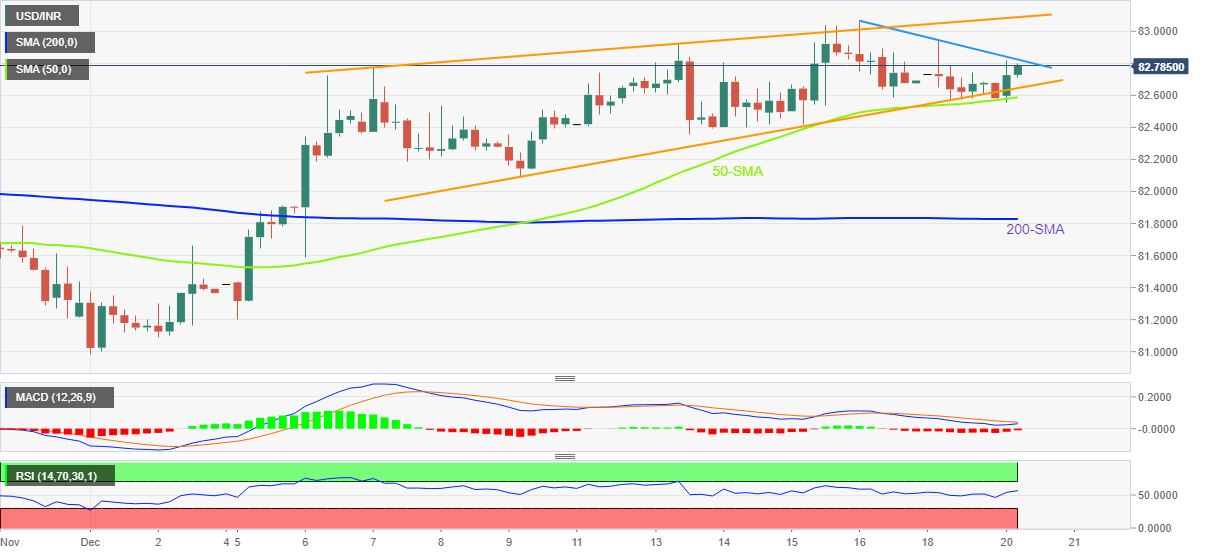
Trend: Limited upside expected
-
04:30
EUR/USD: Bears struggle to retake control near 1.0600 despite softer US Dollar
- EUR/USD remains depressed even as US Dollar stays on the bear’s radar.
- BOJ inflicted losses on the US Dollar, Euro has fewer reasons to celebrate.
- Hawkish bias over ECB jostles with Fed rate hike expectations, oil price cap updates to test bulls.
- German PPI, US housing market numbers to decorate calendar.
EUR/USD remains indecisive around 1.0600, after the latest whipsaw, as it retreats from an intraday high during early Tuesday morning in Europe. The major currency pair’s latest moves could be linked to the US Dollar’s zigzag amid mixed concerns and a light calendar.
The US Dollar Index (DXY) marked 60+ pips of a slump to refresh the intraday low near 103.95, around 104.30 at the latest, as the Bank of Japan (BOJ) altered its Yields Curve Control (YCC) by extending the upper limit to 0.50%. On the same line could be the Japanese central bank’s readiness for more bond issuance.
The BOJ move becomes important for the DXY as Japan is one of the largest buyers of US Treasury bonds. Additionally, the BOJ’s retreat from the easy-money policy also allows the market to cheer Yen’s haven status, especially when the Fed failed to impress DXY bulls.
On the other hand, chatters surrounding China’s stimulus and the World Bank’s downgrading of Beijing's economic forecasts also flash mixed messages and challenge the EUR/USD traders.
Overall, the comparatively more hawkish bias of the European Central Bank (ECB), as per the latest comments from the policymakers, should have favored the EUR/USD buyers.
However, firmer US Treasury yields and downbeat US stock futures restrict the US Dollar’s downside move, which in turn put a floor under the EUR/USD prices. As a result, the EUR/USD traders should pay attention to the risk catalysts for fresh impulse.
That said, Germany’s Producers Price Index (PPI) for November, expected -2.6% YoY versus -4.2% prior, will precede the US Building Permits and Housing Starts for the stated month to determine immediate moves.
Technical analysis
A daily closing below the 10-DMA, surrounding 1.0585 by the press time, becomes necessary for the EUR/USD sellers. Alternatively, the previous support line from November 30, close to 1.0655, guards the short-term upside of the pair. That said, sluggish RSI and bearish MACD signals join the failure to cross the previous support line in a corrective move to keep bears hopeful.
-
03:59
AUD/USD Price Analysis: Further downside hinges on 100-DMA break
- AUD/USD takes offers to refresh intraday low, reverses week-start recovery.
- Support break joins bearish MACD signals, downbeat RSI to keep sellers hopeful.
- Daily closing below 100-DMA appears necessary to defend sellers.
AUD/USD remains on the back foot as it renews its intraday low near 0.6665, reversing the early-week rebound, as bears return to the table on Tuesday.
In doing so, the Aussie pair cheers the previous week’s downside break of a one-week-old ascending trend line, now resistance around 0.6725. The downside bias also takes clues from the bearish MACD signals and the steady RSI.
That said, the 100-DMA level surrounding 0.6660 challenges the AUD/USD bears by the press time, a break of which could quickly direct it to the November lows near 0.6580.
Should the AUD/USD bears keep the reins past 0.6580, October’s top near 0.6550 will be in focus.
On the flip side, a daily closing beyond the previous support line near 0.6725 becomes necessary for the AUD/USD buyers to retake control.
Even so, a downward-sloping resistance line from early June, close to 0.6870 by the press time, appears a tough nut to crack for the bulls.
It should be observed that the monthly high near 0.6895 and the 0.6900 round figure can act as extra upside filters before directing AUD/USD towards August month’s high near 0.7135.
AUD/USD: Daily chart
-20122022-638071055462425056.png)
Trend: Further downside expected
-
03:45
EUR/JPY plummets 2.0% on BOJ’s surprise move, Kuroda eyed
- EUR/JPY dropped more than 400 pips on Bank of Japan’s widening the bank of yield cap.
- BOJ left monetary policy unchanged, as expected.
- ECB hawks, firmer German data previously favored bulls.
- BOJ Governor Kuroda’s speech will be closely monitored for fresh impulses.
EUR/JPY bears cheer the Bank of Japan’s (BOJ) alteration to yield target during early Tuesday as the cross-currency pair slumped over 400 pips or 2.0%, to 141.90 at the latest.
Bank of Japan (BOJ) kept the benchmark interest rate unchanged at -0.10% and also defended the 10-year Japanese Government Bond (JGB) yield target of 0.0% in its latest monetary policy announcement. However, the central bank’s comments suggesting the increase in the upper line of the Yield Curve Control (YCC) seemed to have lured the Japanese Yen (JPY) buyers.
In this regard, Reuters said, “The Bank of Japan decided on Tuesday to allow long-term interest rates to rise more by widening the band around its yield cap, in a surprise move to address the rising cost of prolonged monetary easing.”
Also read:
Previously, the majority of the European Central Bank (ECB) policymakers followed the last week’s hawkish bias of ECB President Christine Lagarde and backed further rate increases, which in turn propelled Euro. Notable among them were Vice-President Luis de Guindos and the ECB board members, Gediminas Simkus and Peter Kazimir.
It’s worth noting that the German IFO Business Climate Index climbed to 88.6 in December versus the previous reading of 86.3 and the forecast of 87.2. Details suggest that the IFO Current Economic Assessment for the nation improved to 94.4 points in the reported month compared to November's 93.1 and 93.5 expected. Further, the IFO Expectations Index – indicating firms’ projections for the next six months, rose to 83.2 in December from the previous month’s 80.0 and against the estimates of 82.0.
Amid these plays, yields rise 11 basis points (bps) to 3.70% whereas S&P 500 Futures reverse initial gains and drop 0.70% intraday by the press time.
Looking forward, EUR/JPY traders should pay attention to BOJ Governor Kuroda’s speech for fresh impulse. Following that, Germany’s Producers Price Index (PPI) for November, expected -2.6% YoY versus -4.2% prior, will be important to watch. Overall, the risk catalysts and hawkish BOJ concerns could weigh on the prices.
Technical analysis
A daily closing below the four-month-old ascending trend line, previous support near 142.45, becomes necessary for the bears to aim for the 200-DMA support close to the 140.00 round figure.
-
03:44
Gold Price Forecast: XAU/USD rebounds toward $1,800 amid US Dollar sell-off
- Gold price jumps, as US Dollar tracks USD/JPY sell-off post-BoJ decision.
- US Treasury bond yields rocket, limiting the upside in Gold price.
- Gold price bounces-off 200DMA support once again, will it regain $1,800?
Gold price has caught a fresh bid over the last hour, as it jumps back toward the $1,800 mark. The US Dollar has come under massive selling pressure after the USD/JPY pair plunged over 2% following the Bank of Japan (BoJ) monetary policy announcements.
The Japanese Yen rallied hard and smashed the USD/JPY pair after the central bank kept the rates unchanged but tweaked the operational functions of the yield curve control (YCC) framework. The sudden slump in the pair dragged the US Dollar sharply lower across the board, lifting the USD-sensitive Gold price.
However, a further upside in the bright metal appears elusive, as the BoJ’s YCC tweak has shot up the US Treasury bond yields through the roof, as it underscores the widening Fed-BoJ policy divergence. The benchmark 10-year US Treasury bond yield is up 3.50% on the day at 3.705%, as of writing. Higher yields tend to weigh on the non-interest-bearing Gold price.
Meanwhile, risk-aversion could put a floor under the US Dollar slump, keeping a check on the upside in Gold price.
Looking ahead, the sentiment around the US Dollar and the yields will continue influencing the precious metal ahead of the US Housing data and the Wall Street opening.
Gold price technical outlook: Daily chart
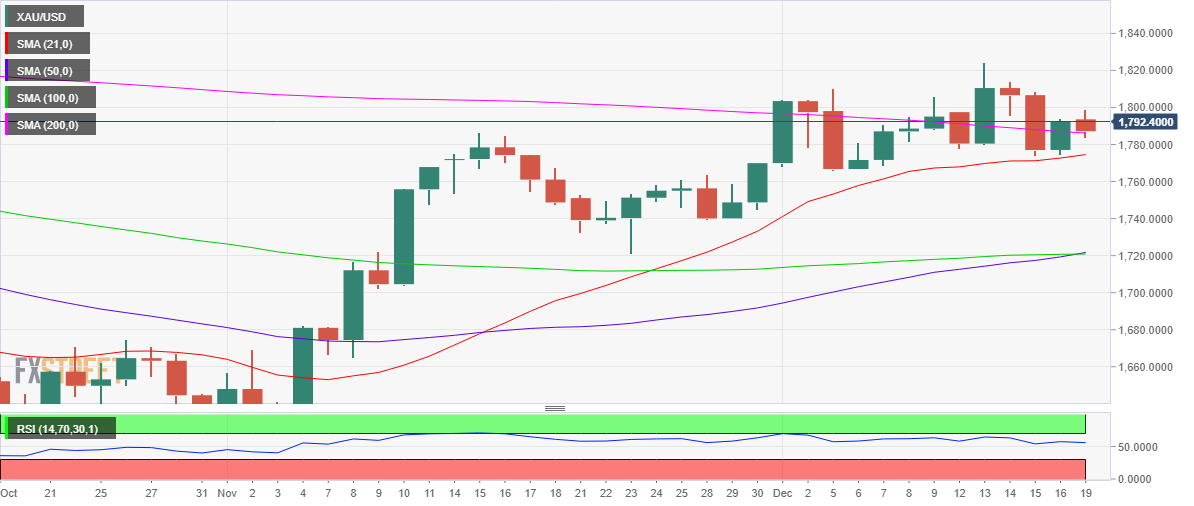
On the daily sticks, Gold price has bounced off the critical 200-Daily Moving Average (DMA) yet again, as it now looks to recapture the $1,800 mark.
The next relevant stop for Gold bulls is seen at the December 15 high of $1,809. The 14-day Relative Strength Index (RSI) inches higher above the midline, supporting the upswing.
On the downside, a breach of the 200DMA will reopen floors toward the bullish 21DMA at $1,777. Further south, the $1,750 psychological level will be back on sellers’ radars.
-
03:24
GBP/JPY Price Analysis: Bears cheer BOJ’s readiness to act, 200-DMA in focus
- GBP/JPY plummets to two-month low on BOJ’s inaction.
- Downside break of the key support line, 100-DMA joins bearish MACD signals to favor sellers.
- Daily closing below 200-DMA appears necessary to defend sellers.
- 50-DMA guards recovery moves, October’s low acts as additional downside filter.
GBP/JPY takes offers to test the lowest levels since October 12 after the Bank of Japan (BOJ) teased Yen buyers by showing readiness to act on Yield Curve Control (YCC) if needed. That said, the cross-currency pair slumped nearly 400+ pips following the announcements, down 2.0% near 163.00 by the press time of early Tuesday.
In doing so, the quote not only broke the 100-DMA but also smashed the previous key support line from November 11. It should be noted that the pair currently trades beneath the 200-DMA but needs a daily closing below the same to keep sellers on the table.
Given the bearish MACD signals and the fundamental moves, GBP/JPY is likely to stay below the 200-DMA support near 163.70, which in turn could help the bears to aim for October’s low near 159.75. However, the 160.00 round figure may act as an intermediate halt.
In a case where the GBP/JPY bears dominate past 159.75, the 61.8% Fibonacci retracement level of the pair's September-October recovery, near 157.70, will be in focus.
Meanwhile, a daily closing beyond the 200-DMA level of 163.70 could aim for the 100-DMA and support-turned-resistance line, respectively around 164.70 and 165.00.
Following that, the 50-DMA hurdle near 167.20 will act as the last defense for the bears.
GBP/JPY: Daily chart
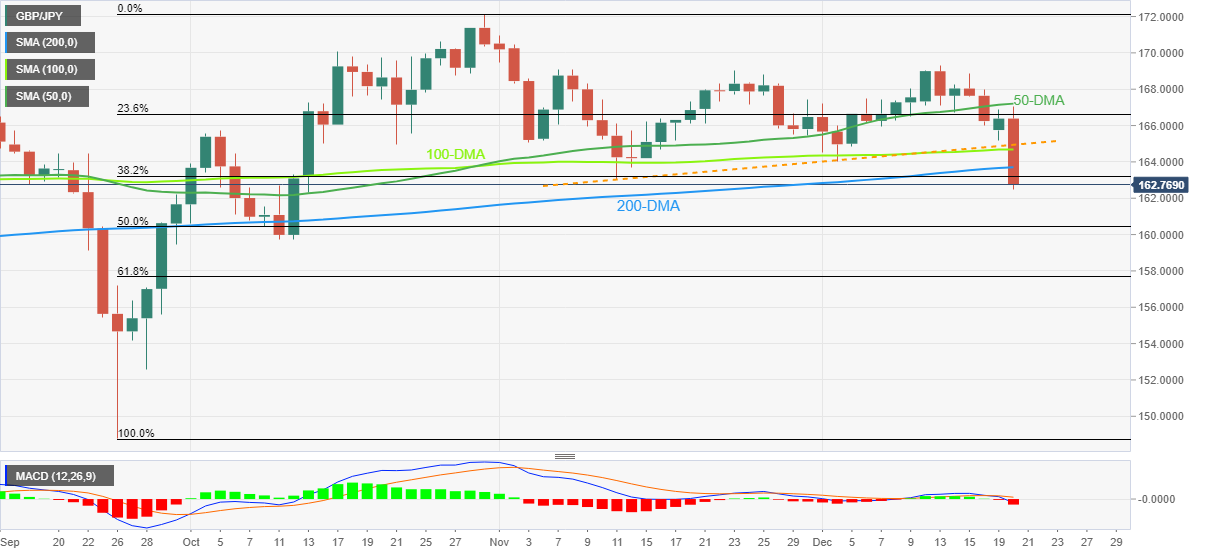
Trend: Further downside expected
-
03:10
BoJ: Will take additional easing steps without hesitation as needed
Following are the key highlights from the Bank of Japan (BoJ) monetary policy statement, as cited by Reuters.
BoJ will sharply increase JGB buying amount.
Leaves unchanged forward guidance on interest rates, says expects short-and long-term policy rates to remain at 'present or lower' levels.
Leaves unchanged its guidance on policy bias, says it will take additional easing steps without hesitation as needed with eye on pandemic's impact on economy.
Will review operation of YCC.
Will aim to achieve price target by enhancing sustainability of monetary easing under this framework through these steps
Japan's economy picking up.
Inflation expectations heightening.
Japan's economy expected to recover as impact of pandemic, supply constraints subsides.
Must be vigilant to financial, FX market moves and their impact on Japan's economy, prices.
BoJ to expand band around its 10-year yield target to 0.5% up and down each, from 0.25%.
Will increase to 9 trln yen from 7.3 trln yen monthly buying under new quarterly bond buying plan.
Fluctuation of bond market has deteriorated.
If such market conditions persist, it would have negative impact on financial conditions such as issuance of corporate bonds.
Steps decided today will facilitate transmission of monetary easing effect generated under YCC.
To conduct additional purchases of JGBs on Dec 22.
To make nimble responses for each maturity by increasing amount of purchases even more and conducting fixed-rate purchase operations when deemed necessary.
In fixed-rate JGB buying ops, bonds with highest yield between three on-the-run issues will be purchased at fixed rate of 0.50%.
Bank will set a fixed rate to be applied in auctions for 10-year JGBs no. 358 at 0.50%.
Set maximum amount of outright purchases of single issuer's corporate bonds at 200 bln yen and 30% of total amount outstanding.
Related reads
- Breaking: BoJ stands pat on monetary policy, USD/JPY slumps
- USD/JPY slumps +200 pips to sub-135.00s despite Bank of Japan inaction
-
03:07
USD/JPY slumps +200 pips to sub-135.00s despite Bank of Japan inaction
- USD/JPY takes offers to refresh intraday low, reverses the latest gains.
- Bank of Japan keeps monetary policy unchanged, as expected.
- Mixed sentiment, firmer yields previously underpinned recovery moves amid light calendar elsewhere.
- Chatters over Japan’s more bond issuance, cap on yields highlight BOJ Governor Kuroda’s speech.
USD/JPY stands on slippery grounds near 134.80, losing nearly 200-pips on the Bank of Japan’s (BOJ) inaction during early Tuesday.
That said, the BOJ held its benchmark rate unchanged at -0.10% while keeping the short-term interest rate target at -0.1% while directing 10-year Japanese Government Bond (JGB) yields toward zero. In doing so, the Japanese central bank matched the market expectations.
Also read: Breaking: BoJ stands pat on monetary policy, USD/JPY drops
Earlier in the day, talks of Japan’s heavy budget proposal triggered the talks of more bond issuance and yield caps. Japan's budget proposal for the 2023-2024 fiscal year (FY) could be as high as 114 trillion yen, the Nikkei reported, adding that the government could issue more than 35 trillion yen in bonds, per Reuters.
In this regard, Japan Finance Minister (FinMin) Shunichi Suzuki ruled out speculations that the Japanese government and the Bank of Japan have decided on a policy to revise joint statements.
Elsewhere, market sentiment remains dicey amid hawkish central bank moves and recession fears. Even so, China’s readiness for more stimulus and an effort to improve trade ties with other nations, recently with Australia, seem to underpin cautious optimism. Alternatively, the World Bank’s recent pessimism surrounding China and hopes of more rate hikes from the global central banks challenge the risk-on mood. As a result, the USD/JPY pair remained mostly firmer, mainly due to the US Dollar’s safe haven appeal.
While portraying the mood, S&P 500 Futures print mild gains despite the downbeat closing of Wall Street. That said, the benchmark 10-year US bond yields rose 1.5 basis points (bps) to 3.60% whereas the two-year counterpart rises to 4.26% by the press time, which in turn portrays the yield curve inversion and suggests the market’s rush for risk safety.
Looking forward, USD/JPY pair traders will pay attention to a speech from BOJ Governor Haruhiko Kuroda for immediate directions. In that case, the sellers may seek hints for Yield Curve Control (YCC)
Technical analysis
USD/JPY jostles with the 21-DMA hurdle surrounding 137.40 inside a 12-day-old bullish channel, currently between 135.00 and 138.40.
-
03:03
Breaking: BoJ stands pat on monetary policy, USD/JPY slumps
At the final monetary policy meeting of this year, the Bank of Japan (BoJ) board members decided to maintain their monetary policy settings in December, leaving rates unchanged at -10bps and 10yr JGB yield target steady at 0.00%.
Summary of the statement
BoJ made decision on ycc by unanimous vote.
Will review operation of yield curve control.
Japan's market function has declined.
Market reaction
USD/JPY comes under heavy selling pressure in a knee-jerk reaction. The pair is currently trading at 134.33, shedding 1.85% on the day.
-
03:03
Japan BoJ Interest Rate Decision remains unchanged at -0.1%
-
02:55
Japan’s Suzuki: Not true that government, BoJ have decided on policy to revise joint statement
Japan’s Finance Minister Shunichi Suzuki said on Tuesday, “not true that government and BoJ have decided on a policy to revise the joint statement.”
He said that “I hope BoJ continues to strive toward achieving price target stably, sustainably.”
Market reaction
USD/JPY is consoldiating gains at around 137.30, up 0.32% on the day. The BoJ policy decision coming up next.
-
02:36
World Bank trims China's 2023 GDP forecast to 4.3% from 4.5%
In the "World Bank China Economic Update - December 2022", the international lender reduced its GDP forecast for China for the next year.
Key takeaways
“Activity in China has followed the ups and downs of the pandemic—outbreaks and economic slowdowns have been followed by uneven recoveries.”
“Despite policy support, real GDP growth is expected to slow to 2.7 percent in 2022, before recovering to 4.3 percent in 2023 amid a reopening of the economy.”
“The growth outlook is subject to significant risks. Recurrent COVID-19 outbreaks, the possibility of renewed mobility restrictions and precautionary behavior to slow the spread of the virus could lead to longer-than-expected disruption in economic activity. Persistent stress in the real estate sector could also have wider macroeconomic and financial spillovers.”
“China’s economy is also vulnerable to climate change, highly uncertain world growth prospects, greater-than-expected tightening in global financial conditions and heightened geopolitical tensions.”
“Continued macroeconomic policy support will be needed in the near term, as the economy remains below potential and the global environment is weakening. China has adequate fiscal policy space, especially at the central level, that could be deployed to bolster a stronger recovery.”
Market reaction
Despite the grim outlook, AUD/USD remains unfazed and holds lower ground near 0.6700, losing 0.10% on the day.
-
02:30
Commodities. Daily history for Monday, December 19, 2022
Raw materials Closed Change, % Silver 22.979 -0.89 Gold 1787.53 -0.27 Palladium 1665.68 -2.94 -
02:22
GBP/USD: Better bid around 1.2150 as US Dollar stalls rebound
- GBP/USD pauses downside momentum amid a steady US Dollar, cautious mood.
- Fed-BoE policy divergence continues to keep any upside in GBP/USD temporary.
- Pound Sterling bears fight back control below 21DMA, eyes 200DMA support.
GBP/USD is attempting a tepid bounce near mid-1.2100s, having paused its three-day bearish momentum. The US Dollar is holding steady amid a mixed market mood and the persistent uptrend in the US Treasury bond yields across the curve.
The hawkish Fed outlook and downbeat US economic data-induced recession fears continue to keep investors on the edge. Meanwhile, the continued widening policy divergence between the US Federal Reserve (Fed) and the Bank of England (BoE) adds to the vulnerability in the GBP/USD pair.
Attention now turns towards a set of US Housing data, which will be closely watched for the state of the US economy, as we head toward the Christmas holiday thin trading in the second half of this week.
Broad-based US Dollar weakness is underpinning the uptick in the Pound Sterling, despite the continued widening policy divergence between the US Federal Reserve (Fed) and the Bank of England (BoE). The slide in the USD/JPY pair is exerting bearish pressure on the US Dollar, as investors pay little heed to the higher Treasury bond yields.
Despite the bullish 14-day Relative Strength Index (RSI) and double Bull Cross confirmation, the rising wedge pattern overpowers and keeps GBP bears pushing for more.
After defending the mildly bullish 21-Daily Moving Average (DMA) at 1.2160 on Monday, the pair opened Tuesday below the latter, exposing the descending 200DMA at 1.2091.
Daily closing below the critical 200DMA will initiate a fresh downswing toward the bullish 50DMA at 1.1777.
On the upside, Cable will need to recapture the 21DMA on a daily closing basis in order to challenge the 1.2200 hurdle once again. Further up, bulls will aim for Monday’s high at 1.2223.
The next relevant upside target is envisioned at the 1.2250 psychological level.
GBP/USD: Daily chart

GBP/USD: Additional technical levels
-
02:01
NZD/USD bears taking a bite out of bullish structure
- NZD/USD is taking out a key level and printing fresh lows within a bearish schematic.
- should the bulls move in now, then there will be prospects of a restest of prior structures near 0.6355 and 0.6375 above.
NZD/USD has been chipping away at the downside in Asia, sliding to a fresh session low at the time of writing, down 0.35% on the day so far after dropping from a high of 0.6365. The US Dollar has been struggling to break higher which had been giving the commodity complex some room to breathe but the tables are turning.
The greenback came under pressure in recent weeks as investors expect a pivot from the Federal Reserve sooner than later. This had been supporting the Kiwi. However, a combination of a poor start on Wall Street on Monday and dismal domestic data is impacting the currency at the start of this week.
New Zealand Business confidence has plummeted to a fresh record low in December, down 13 points to -70. Expected own activity fell from -14 to -26. Analysts at ANZ Bank said that the ''Reserve Bank of New Zealand appears to have achieved shock value with its sharp increase in the OCR, hawkish forecasts, and warning of deliberate recession in 2023. Many indicators are around Global Financial Crisis (GFC) lows. Inflation pressures remain intense. Wage expectations jumped.''
Meanwhile, high beta currencies, such as NZD, were pressured on the back of US stocks closing sharply lower to extend their three-day losing streak on Monday and Treasury yields advanced. Given the time of year, there will be few catalysts to dissuade risk-off sentiment in the low-volume, the pre-holiday week which could lead to further downside in what appears to be a fresh bearish cycle given the recent break of trendline support as the following illustrates.
NZD/USD technical analysis
As per the earlier analysis, NZD/USD Price Analysis: Bears attempt to take control at a key support structure at 0.6340, the bird is making headway to the downside.
It was stated that the bears would not in the clear until a change of structure in the 4-hour time frame and this required a break of 0.6340:
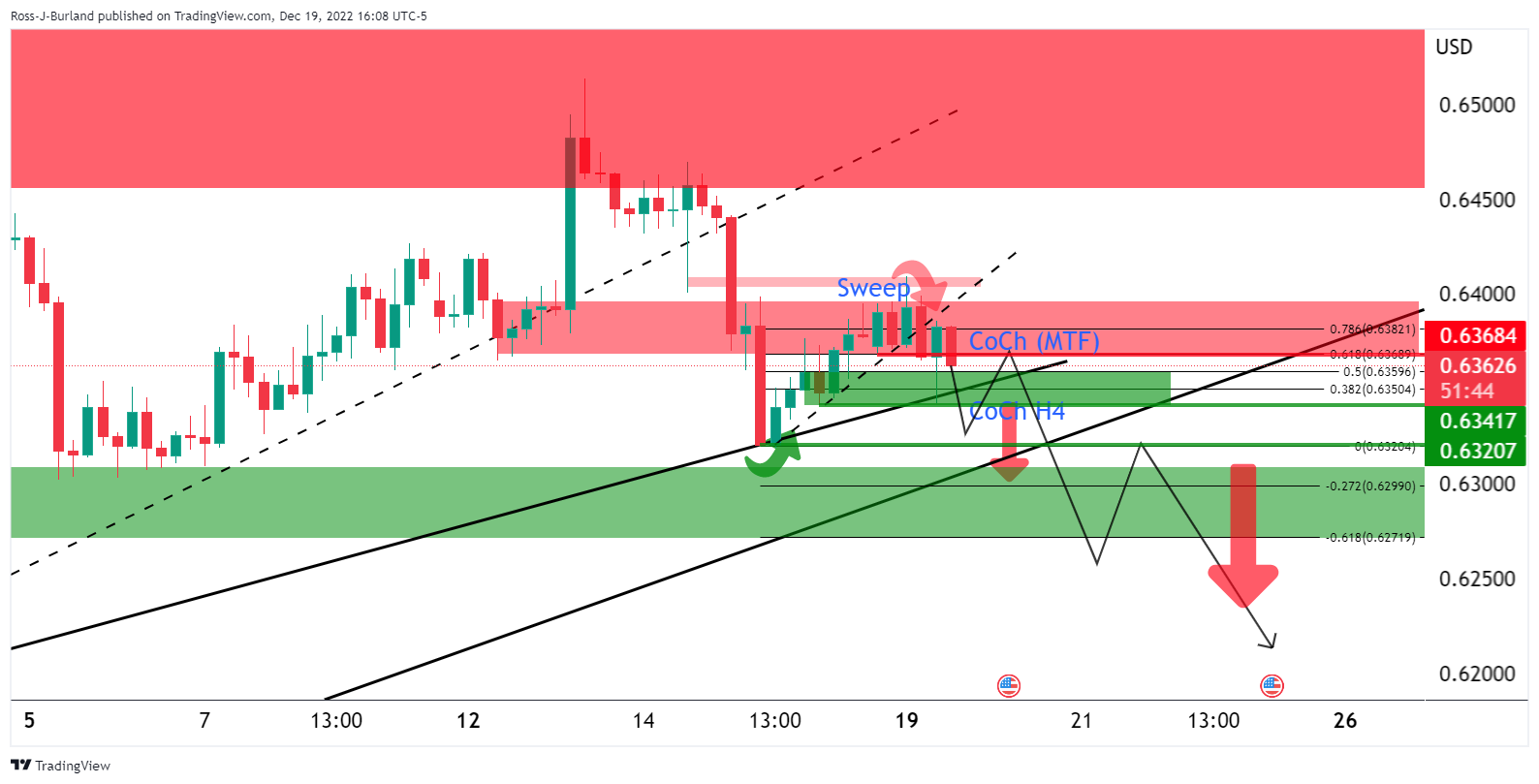
Moving to the 15-min charts to monitor for tests of this area...
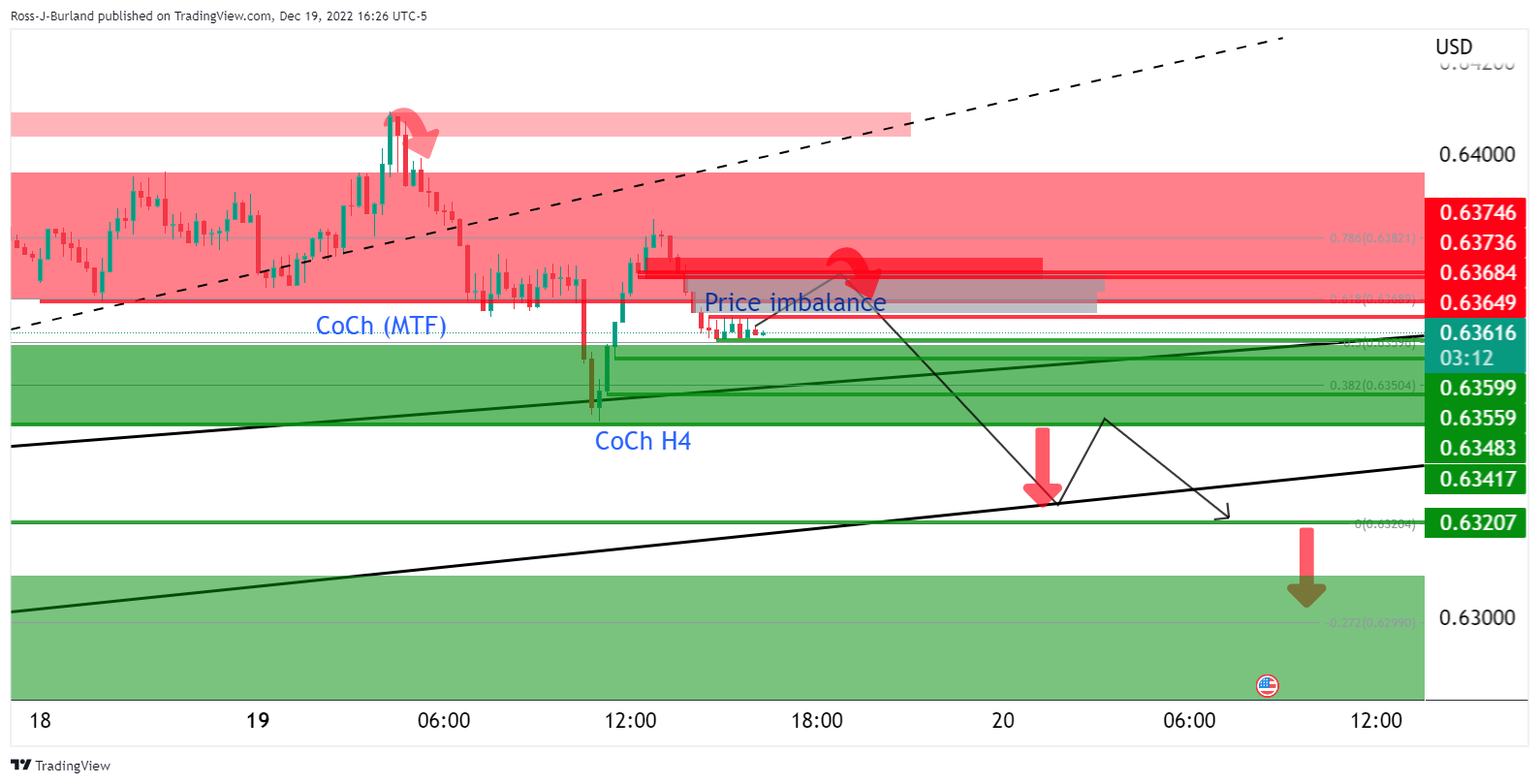
The prior analysis above illustrated the market structure in more detail.
NZD/USD update, M15 chart
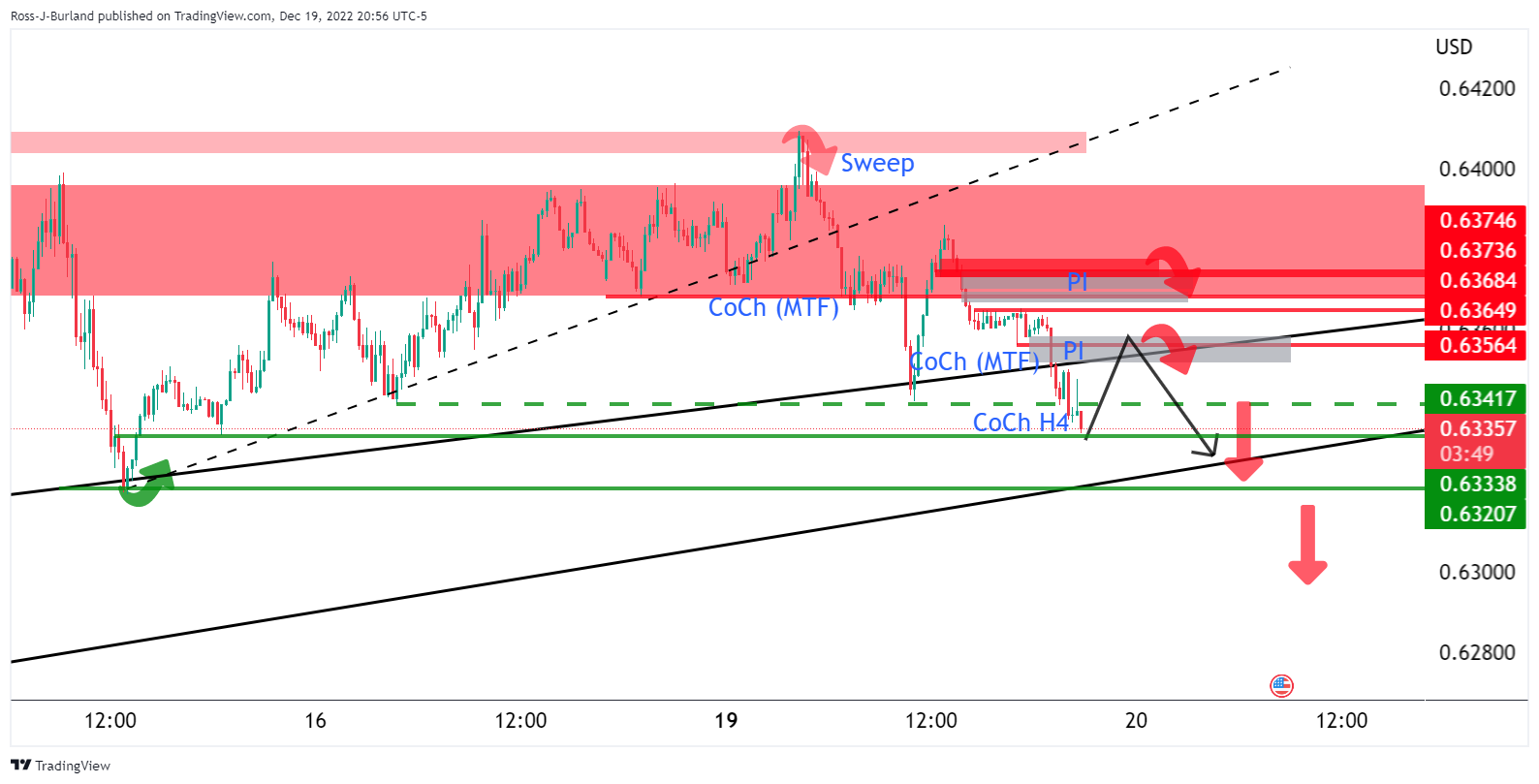
The price is taking out the trendline support and the horizontal 0.6340 level while printing fresh lows within this bearish schematic. However, should the bulls move in now, then there will be prospects of a restest of prior structures namely where the price imbalances are situated around 0.6355 and 0.6375 above. If either of these structures were to hold, the bias will remains to the downside for a run to test 0.6320.
-
02:01
When is the BOJ rate decision and how could it affect USD/JPY?
Early on Tuesday, around 03:00 AM GMT, the Bank of Japan (BOJ) will announce routine monetary policy meeting decisions taken after a two-day brainstorming. Following the rate decision, BOJ Governor Haruhiko Kuroda will attend the press conference, around 06:00 AM GMT, to convey the logic behind the latest policy moves.
The Japanese central bank is widely expected to keep the short-term interest rate target at -0.1% while directing 10-year Japanese Government Bond (JGB) yields toward zero.
Although the BOJ isn’t expected to offer any change in its monetary policy, the latest hawkish moves of the major central banks and the inflation fear in Japan highlight today’s BOJ as the key event for the USD/JPY traders. Also increasing the importance of the BOJ announcements are the chatters over Governor Haruhiko Kuroda’s retirement and the government’s help to BOJ in tightening the policy afterward.
Ahead of the event, FXStreet’s Valeria Bednarik said,
An on-hold BoJ should help the pair advance, but with the broad USD weakness, gains are likely to remain limited. Hints on upcoming tightening should send USD/JPY close to the aforementioned November low.
How could it affect the USD/JPY?
USD/JPY picks up bids to extend the week-start gains, as well as refresh intraday high, near 137.40 ahead of the Bank of Japan’s (BOJ) monetary policy announcements. The pair’s latest run-up could be linked to the firmer US Treasury bond yields, as well as the market’s preparations for the BOJ amid hawkish hopes.
Japanese policymakers have already turned down the expectations of any major moves from the Bank of Japan (BOJ). However, the recent announcement of bond-buying and talks of the town supporting the official push for higher rates in the future push the USD/JPY bears.
The same could quickly drag the USD/JPY pair towards a 12-day-old support line near 135.00. However, the risk-off mood and firmer USD, as well as fewer odds of the BOJ’s hawkish mood, are likely to favor the short-term USD/JPY buyers.
Technically, USD/JPY bulls need a clear upside break of the 21-DMA, currently around 137.40 to keep reins while a downside break of the aforementioned support line of around 135.00 won’t hesitate to direct sellers towards the monthly low of 133.62.
Key Notes
USD/JPY Price Analysis: Could be coiling ahead of a significant breakout
Bank of Japan Preview: Policymakers can boost the JPY
About BoJ Rate Decision
BoJ Interest Rate Decision is announced by the Bank of Japan. Generally, if the BoJ is hawkish about the inflationary outlook of the economy and rises the interest rates it is positive, or bullish, for the JPY. Likewise, if the BoJ has a dovish view of the Japanese economy and keeps the ongoing interest rate, or cuts the interest rate it is negative, or bearish.
-
01:48
Gold Price Forecast: XAU/USD retreats towards $1,775 amid hawkish central banks, recession woes
- Gold price holds onto Monday’s bearish bias as it renews intraday low, stays mildly offered though.
- Recession fears weigh on Gold price as global central banks promote higher rates.
- United States Treasury bond yields print three-day uptrend and underpin US Dollar’s latest rebound.
- Mixed concerns surrounding China, Federal Reserve test Gold buyers ahead of key data/events.
Gold price (XAU/USD) takes offers to refresh intraday low near $1,785 during early Tuesday, extending the week-start losses amid firmer US Dollar. In doing so, the Yellow metal bears the burden of the global central bank actions amid a light calendar and mixed economic signals from key customers like the United States and China.
Central Banks weigh on Gold price
Be it the European Central Bank (ECB) or the Federal Reserve (Fed), not to forget the Bank of England (BOE) and the Swiss National Bank (SNB), all of them played hawkish moves the last week and challenged Gold buyers. Following that, policymakers from some of the central banks crossed wires to renew the chatters surrounding higher rates and weighed on the XAU/USD prices. Notable among them were ECB Vice-President Luis de Guindos and New York Fed President John Williams.
Recently, the Reserve Bank of Australia's (RBA) latest Monetary Policy Meeting Minutes conveyed hawkish bias among policymakers. However, the People’s Bank of China (PBOC) kept the one-year and five-year Loan Prime Rates (LPR) unchanged at 3.65% and 4.30% in that order.
It should be noted that the higher rates and strong inflation lead traders towards less risky assets like the US Dollar while cutting off from the Gold price.
United States Treasury bond yields defend US Dollar bulls, weigh on Gold price
Given the market’s rush towards risk safety and higher interest rates from the Federal Reserve (Fed), the United States Treasury bond yields remain firmer for the third consecutive day and underpin the US Dollar’s demand. It should be noted that the benchmark 10-year US bond yields rose 1.5 basis points (bps) to 3.60% whereas the two-year counterpart rises to 4.26% by the press time, which in turn portrays the yield curve inversion and suggests the market’s rush for risk safety. As a result, the Gold price remains pressured recently.
China-linked optimism fails to impress XAU/USD traders
Chinese policymakers showed readiness for more stimulus at the annual Central Economic Work Conference. "We must insist on stability first next year while we strive for progress,” stated the leaders. However, a fall in China’s business sentiment, according to a survey conducted by the World Economics Survey, to the lowest levels in a decade joins doubts over the nation’s Covid conditions and economic recovery to challenge the Gold buyers.
Risk catalysts in focus
Given the lack of major data/events, Gold traders should pay attention to the risk catalysts like the Covid headlines from China and political news surrounding Russia, not to forget the Euro area oil price cap updates, for fresh impulse. That said, the commodity price may witness lackluster moves as traders seem to cheer holiday mood before the time.
Gold price technical analysis
Gold price fades bounce off the 21-DMA, as well as the 61.8% Fibonacci retracement level of the Gold’s June-September moves, near $1,778-75 by the press time.
It’s worth noting that the bearish divergence between the Gold price and the Relative Strength Index (RSI), located at 14, keeps XAU/USD sellers hopeful. That said, the RSI divergence is known as the difference between the price and the RSI. In this case, the higher low on prices joins the lower low on the RSI to tease the Gold bears.
In a case where the Gold price remains weak past $1,775, a downward trajectory toward October’s peak near $1,730 can’t be ruled out.
Alternatively, the $1,800 could challenge short-term XAU/USD bulls ahead of the six-month-old ascending resistance line, close to $1,815 by the press time.
Overall, the Gold price remains on the bear’s radar but a clear break of $1,775 becomes necessary.
Gold price: Daily chart

Trend: Further downside expected
-
01:31
China PBoC Interest Rate Decision remains at 3.65%
-
01:23
USD/CNY fix: 6.9861 vs. prev fix 6.9746 and close 6.9818
In recent trade today, the People’s Bank of China (PBOC) set the yuan (CNY) at 6.9861 vs. the previous fix of 6.9746 and the prior close of 6.9818.
About the fix
China maintains strict control of the yuan’s rate on the mainland.
The onshore yuan (CNY) differs from the offshore one (CNH) in trading restrictions, this last one is not as tightly controlled.
Each morning, the People’s Bank of China (PBOC) sets a so-called daily midpoint fix, based on the yuan’s previous day's closing level and quotations taken from the inter-bank dealer.
-
01:20
PBoC keeps 1-Year Loan Prime Rate unchanged at 3.65%, as expected
The People's Bank of China kept the one-Year Loan Prime Rate unchanged at 3.65%, as expected.
More to come...
-
01:04
AUD/JPY Price Analysis: Grinds near 92.00 post-RBA Minutes, inverse H&S teases bulls ahead of BOJ
- AUD/JPY grinds higher even as RBA Minutes fail to impress traders.
- RBA Minutes stated that policymakers discussed all options, eyed further rate hikes.
- Inverse Head-and-Shoulders pattern, impending bull cross on MACD lure buyers.
- 200-SMA, weekly resistance line add to the upside filters.
AUD/JPY picks up bids to 91.90 as buyers attack a short-term key hurdle after the Reserve Bank of Australia's (RBA) latest Monetary Policy Meeting Minutes during early Tuesday.
Even so, the cautious mood ahead of the Bank of Japan’s (BOJ) monetary policy meeting tests the cross-currency pair traders as it portrays the Inverse Head and Shoulders bullish chart pattern amid the looming bull cross on the MACD.
That said, the quote’s further upside aims for the 200-SMA level surrounding 92.15 before a one-week-old resistance line, close to 92.55 by the press time, could challenge the AUD/JPY buyers.
It’s worth noting that the inverse H&S formation suggests the theoretical target of 92.80 but an upside break of the 92.55 resistance line, mentioned above, won’t hesitate to challenge the previous weekly top of 93.35. In doing so, the quote may take a halt near the 93.00 round figure.
On the contrary, a downside break of the stated bullish formation’s neckline, currently around 91.90, could drag the quote back towards the monthly low marked the previous day near the 91.00 round figure.
However, lows marked in October and August, respectively near 90.85 and 90.55, could challenge the AUD/JPY bears afterward.
AUD/JPY: 30-minute chart

Trend: Further upside expected
-
01:03
USD/JPY Price Analysis: Could be coiling ahead of a significant breakout
- USD/JPY bulls eye 137.50/70 and then a full 100 pips of the same until the 139s.
- On the downside, 136.50 and 136.20 align with the neckline of a harmonic pattern.
USD/JPY is in a state of consolidation, coiling below the breakout of the daily trendline support of the prior bullish cycle. The following illustrates the prospects of a downside continuation:
USD/JPY daily chart
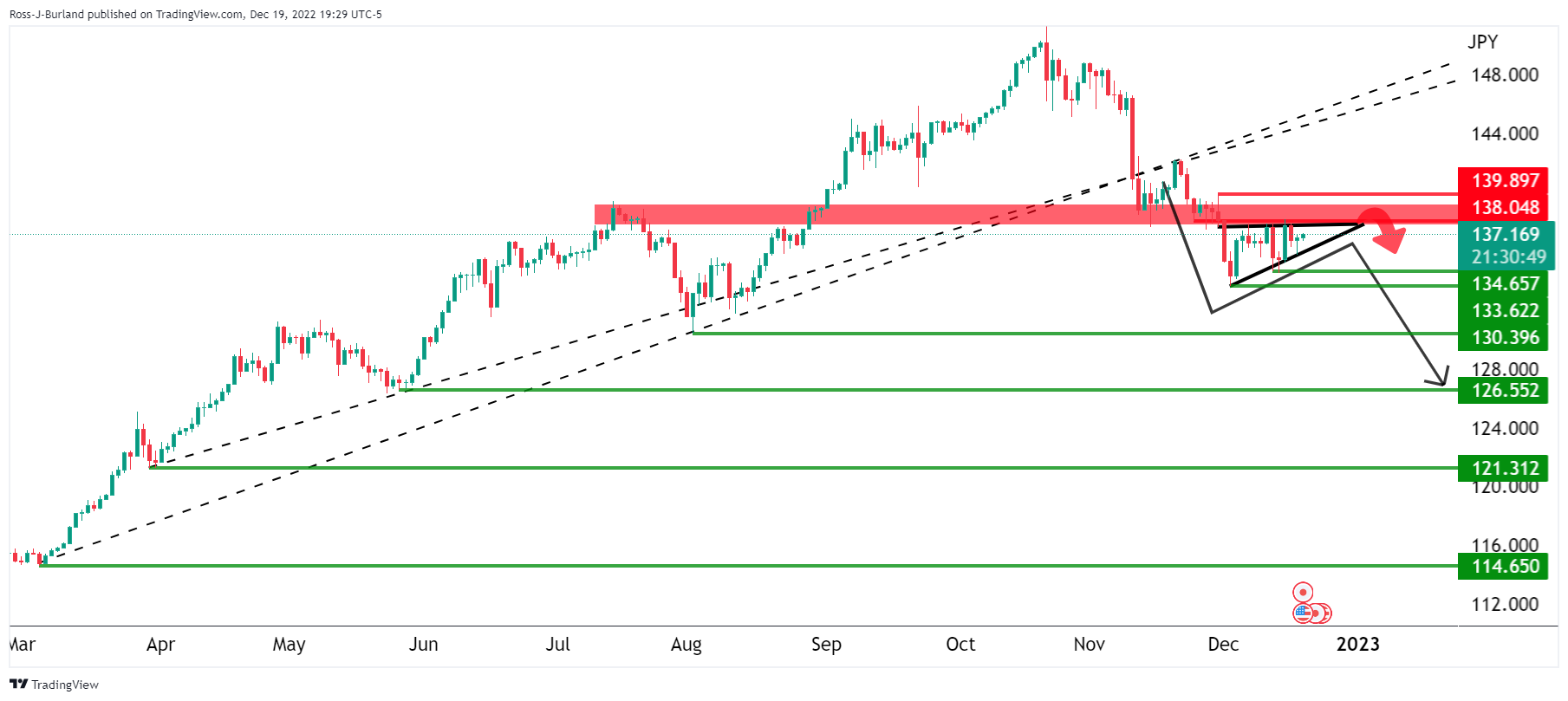
Zoomed in ...

The coil is an explosive chart pattern that would expect to see some testing of the boundaries before a decisive breakout one way or the other. however, in this case, this is an ascending triangle in a downtrend, a continuation pattern. Therefore, the bias is to the downside, especially given that the price is now on the backside of the prior dominant trend. What we might see, is some pre-breakout mitigation of the price imbalances as illustrated below.
USD/JPY H4 charts

Zoomed in ...

The W-formation can be considered as a bearish harmonic pattern whereby, at some stage, the bullish phase would be expected to peter out and result in a downside correction. There are two key areas of interest between then and now. The first is the price imbalance between 137.50/70 and then a full 100 pips of the same until the 139s. On the downside, there is an imbalance of price between 136.50 and 136.20 which is compelling and also align with the neckline of the harmonic pattern. A break there following the tests of the upside could be significant with regard to a downside breakout.
-
00:40
AUD/USD stays pressured around 0.6700 on unimpressive RBA Minutes, focus on Aussie-China talks
- AUD/USD holds lower grounds after RBA’s latest Monetary Policy Meeting Minutes.
- RBA Minutes suggest that policymakers discussed all options, are ready for further rate hikes.
- Anxiety ahead of Aussie-China talks, mixed sentiment elsewhere restricts pair moves.
- PBOC Interest Rate Decision, US Housing data to offer additional directions but China-linked headlines are the key.
AUD/USD pays little heed to the Reserve Bank of Australia's (RBA) latest Monetary Policy Meeting Minutes while holding lower grounds near 0.6700 during early Tuesday. In doing so, the Aussie pair portrays the market’s cautious mood ahead of the other key catalysts, namely a meeting between Australian and Chinese diplomats, as well as a monetary policy meeting of the People’s Bank of China (PBOC).
RBA Minutes suggested that Australia's central bank considered leaving interest rates unchanged at its December policy meeting, citing the lagged effects of the aggressive tightening delivered so far and the benefits of moving cautiously in an uncertain environment.
Also read: RBA minutes: Considered pausing hikes at Dec meeting, still sees more ahead
Apart from the RBA Minutes, mixed concerns in the market and a cautious mood ahead of the key diplomatic meeting between the Aussie and Chinese policymakers challenge the AUD/USD pair moves. Also likely to have probed the momentum traders could be the year-end holiday mood and a light calendar elsewhere, not to forget the looming interest rate decision from the PBOC.
Earlier in the day, Australian Foreign Minister Penny Wong said she would push for trade sanctions to be lifted in her meeting with Chinese counterpart Wang Yi as Canberra looks to repair strained diplomatic relations with Beijing, per Reuters. “Wong is expected to meet Wang Yi in Beijing on Wednesday, the first visit by an Australian minister since 2019 and the first formal talks in Beijing between the two nations' top diplomats since 2018,” added the news.
It should be noted that the recession woes underpin the US Treasury yield and challenge the riskier assets, like AUD/USD and equities of late.
Looking forward, the PBOC Interest Rate Decision will be important amid indecision surrounding the longer-term Loan Prime Rate (LPR). That said, the one-year LPR is likely to remain unchanged at 3.65% while some in the market do favor an increase in the five-year LPR, currently near 4.30%, which could favor AUD/USD bulls.
Technical analysis
Inverted hammer bullish candlestick on the daily chart of the AUD/USD pair suggests further upside momentum of the quote. Also challenging the sellers is the 100-DMA support near 0.6665.
-
00:38
RBA Minutes: Considered pausing hikes at Dec meeting, still sees more ahead
The Reserve Bank of Australia (RBA) published the minutes of its monetary policy meeting two weeks after the prior interest rate decision.
RBA minutes key notes
Reuters reported that the RBA ''considered leaving interest rates unchanged at its December policy meeting, citing the lagged effects of the aggressive tightening delivered so far and the benefits of moving cautiously in an uncertain environment.''
''Reserve Bank of Australia's (RBA) Board weighed three options at its last decision this year - hiking by 50 basis points, 25 bps or pausing, but the arguments for a 25 basis-point hike prevailed.''
''It was the first time the Board considered pausing since it started raising interest rates in May. Rates have already risen by 300 basis points to a ten-year high of 3.1% and much of that had yet to feed through into mortgage payments.''
''In particular, the Board noted there was considerable uncertainty about the outlook for inflation and the labour market amid deteriorating prospects for the global economy.''
"Recognising this uncertainty, members noted that a range of options for the cash rate could be considered again at upcoming meetings in 2023.''
"The Board did not rule out returning to larger increases if the situation warranted. Conversely, the Board is prepared to keep the cash rate unchanged for a period while it assesses the state of the economy and the inflation outlook."
''Ultimately, the minutes showed it decided against pausing because shifting course with no clear impetus from incoming data would create uncertainty about its reaction function, noting that no other central bank had yet paused.''
AUD/USD update
There has been no reaction to the minutes. AUD/USD continues to consolidate around 0.6700.
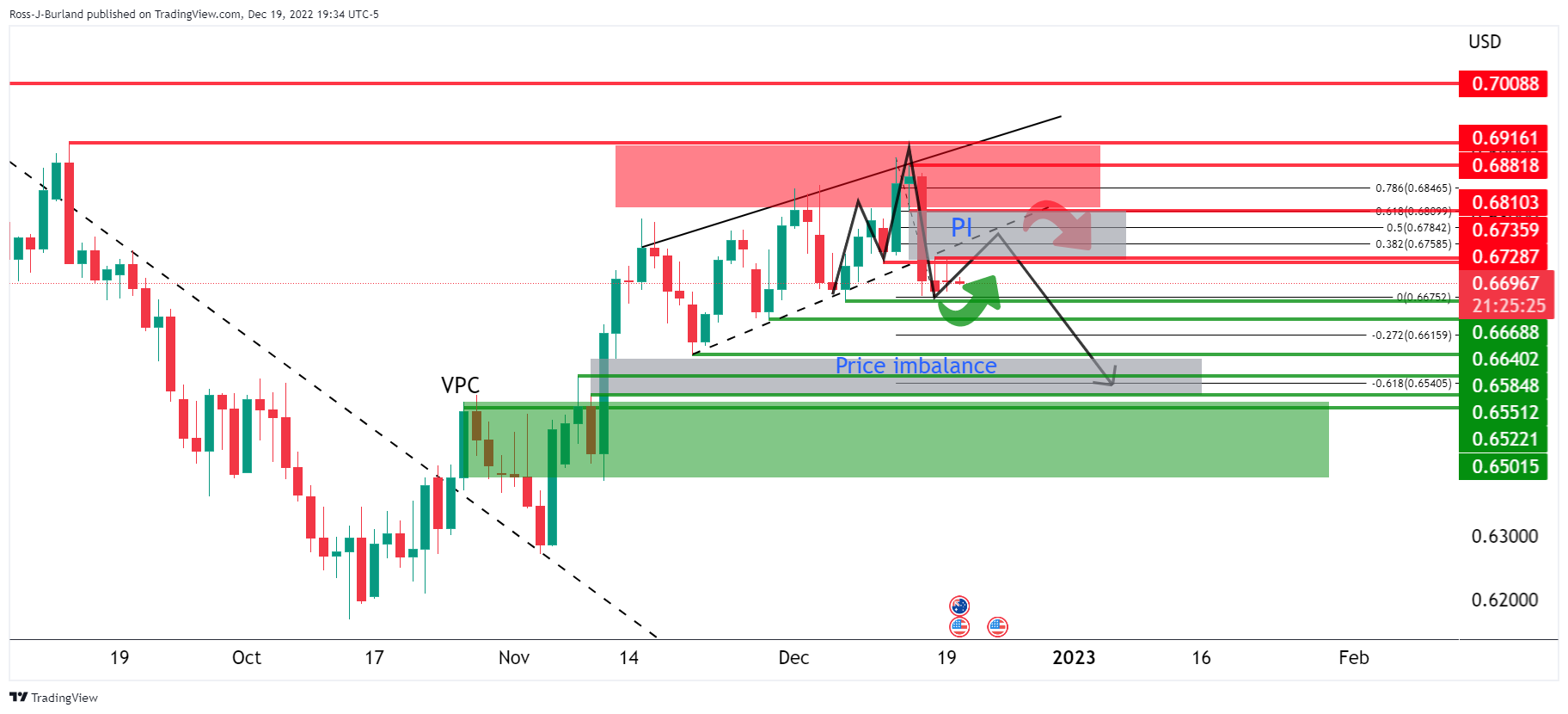
The price is consolidating but as the above 4-hour chart analysis illustrates, there are prospects of a bullish correction into a price imbalance to retest the prior bullish channels now counter trendline and 0.68s. If this were to hold as resistance, then the bias will be to the downside towards 0.6500.
About the Reserve Bank of Australia (RBA) minutes
The Reserve Bank of Australia (RBA) publishes the minutes of its monetary policy meeting two weeks after the interest rate decision is announced. It provides a detailed record of the discussions held between the RBA’s board members on monetary policy and economic conditions that influenced their decision on adjusting interest rates and/or bond buys, significantly impacting the AUD. The minutes also reveal considerations on international economic developments and the exchange rate value.
-
00:30
Stocks. Daily history for Monday, December 19, 2022
Index Change, points Closed Change, % NIKKEI 225 -289.48 27237.64 -1.05 Hang Seng -97.86 19352.81 -0.5 KOSPI -7.85 2352.17 -0.33 ASX 200 -14.8 7133.9 -0.21 FTSE 100 29.21 7361.31 0.4 DAX 49.8 13942.87 0.36 CAC 40 20.66 6473.29 0.32 Dow Jones -162.92 32757.54 -0.49 S&P 500 -34.7 3817.66 -0.9 NASDAQ Composite -159.38 10546.03 -1.49 -
00:18
WTI Price Analysis: Oil bulls can ignore recent inaction surrounding $76.00
- WTI crude oil struggles to defend the bounce off 50-HMA, remains sidelined of late.
- Firmer RSI line backs gradual recovery on prices, suggesting further advances of the quote.
- Sellers need clear break of 200-HMA to retake control.
WTI crude oil grinds higher around $76.00 during early Tuesday, struggling to keep the bounce off the 50-HMA of late.
Even so, the recently higher lows on the oil prices gain support from the firmer RSI (14) line, which in turn suggests the quote to remain firmer.
That said, a downward-sloping resistance line from the last Thursday, around $76.50 by the press time, restricts the black gold’s immediate upside.
Should the quote remains firmer past $76.50, the $77.00 round figure and the latest swing high surrounding $77.80 could challenge the commodity buyers before directing them to the monthly peak of $83.30.
It’s worth noting that the $80.00 psychological magnet might act as an extra filter to the north.
On the flip side, the 50-HMA and ascending trend line from Friday restrict short-term WTI downside near $75.25 and $74.65 respectively.
Following that, a convergence of the 200-HMA and a one-week-old ascending trend line, close to $74.30, could challenge the quote’s further downside.
In a case where WTI remains bearish past $74.30, the odds of witnessing a slump toward the monthly low near $70.45 can’t be ruled out.
Overall, oil prices are likely to remain firmer despite the latest struggle to defend bulls.
WTI: Hourly chart

Trend: Further upside expected
-
00:15
Currencies. Daily history for Monday, December 19, 2022
Pare Closed Change, % AUDUSD 0.66996 -0 EURJPY 145.244 0.76 EURUSD 1.06079 0.23 GBPJPY 166.331 0.76 GBPUSD 1.2148 0.04 NZDUSD 0.63641 -0.11 USDCAD 1.3651 -0.19 USDCHF 0.9291 -0.45 USDJPY 136.921 0.74 -
00:01
New Zealand ANZ Business Confidence below expectations (-50) in December: Actual (-70.2)
-
00:01
New Zealand ANZ Activity Outlook came in at -25.6%, below expectations (-8.1%) in December
-